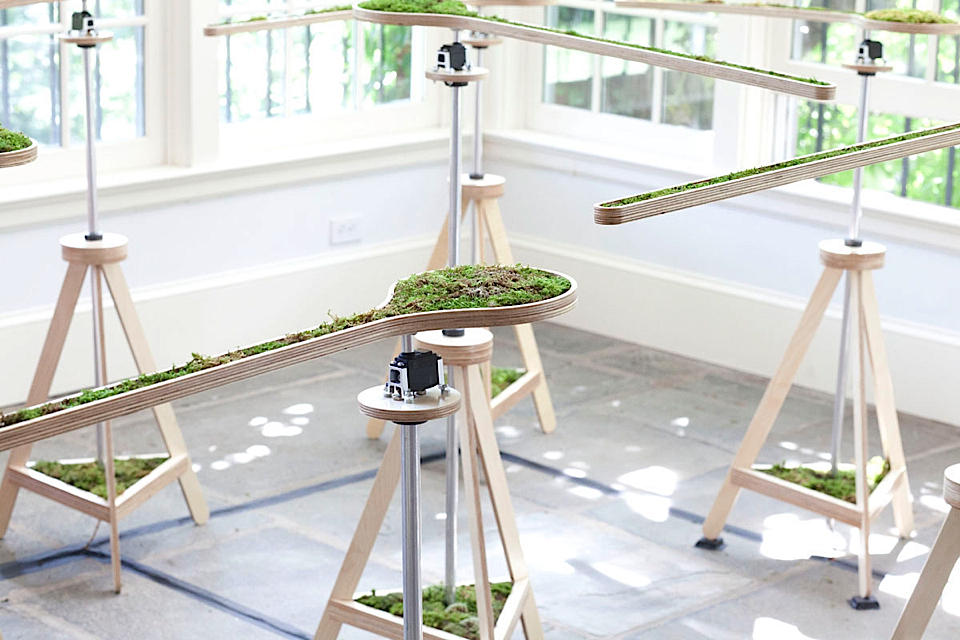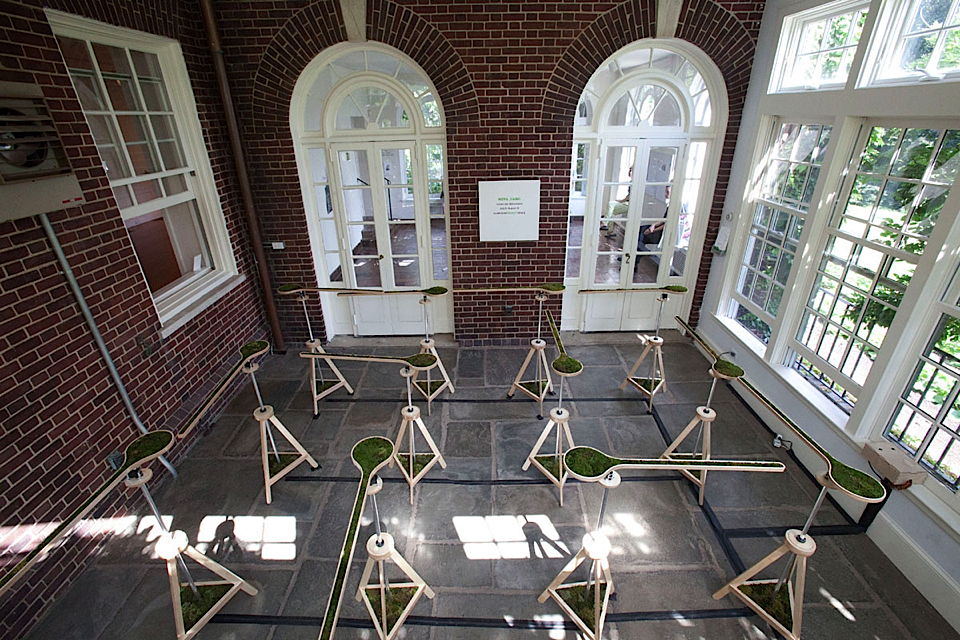SENSITIVE SCIENCE
amphibio by jun kamei
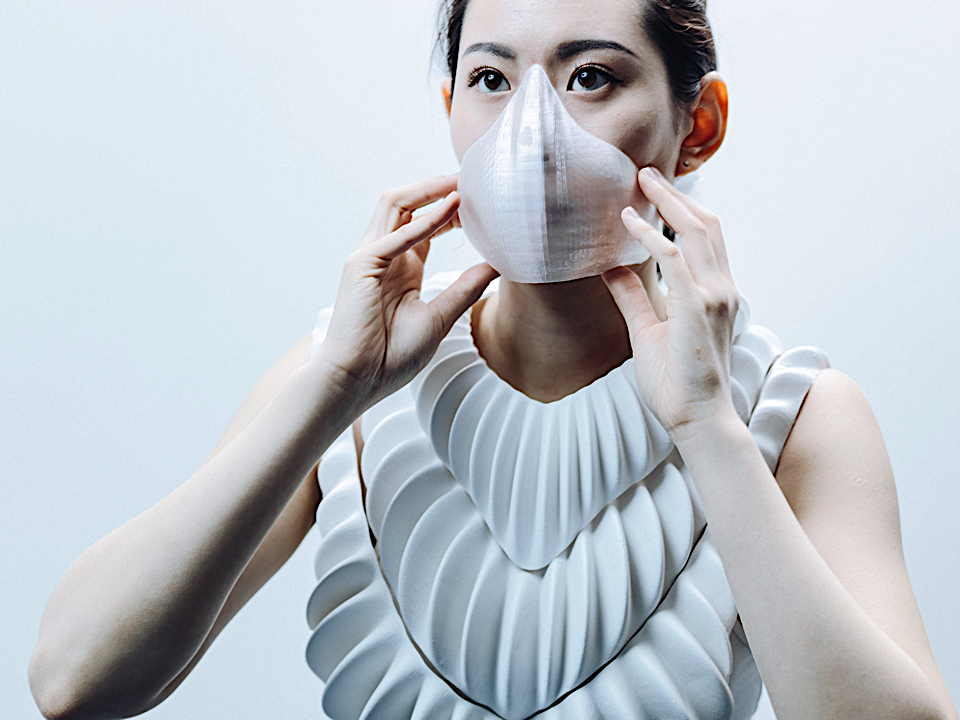
Over the past few decades, scientists have consistently observed sea levels rising at an alarming rate. In fact, according to National Geographic, the annual rate of rise over the past 20 years has been 3.2 millimeters a year – roughly twice the average speed of the preceding 80 years. A direct result of global warming, this phenomenon will ultimately affect island nations and countries that sit at a low elevation the most, meaning experts may have to begin creating solutions for a world in which our everyday environment is permanently semi-submerged.
With these possibilities front of mind, an innovative Royal College of Art (RCA) graduate developed a 3D-printed garment designed specifically for a future in which humankind lives in very close proximity with water.
Called Amphibio, Jun Kamei’s creation consists of a gill and a respiratory mask and was designed as a garment that could support underwater breathing. A researcher, designer and materials scientist for the the MicroLab team – a joint initiative between the Tokyo University Institute of Industrial Science and RCA – Kamei’s practice frequently sees him working within the field of biomimicry, and Amphibio seems poised to solidify his expertise within this field.
A working prototype, the current version of Amphibio is not able to produce enough oxygen to sustain human breathing. It is, however, able to extract oxygen from water, and release carbon dioxide back in, meaning that it has the potential to be used for underwater breathing. Inspired by water-diving insects that are able to survive thanks to a thin layer of trapped air on the surface of their superhydrophobic skin – which operates as a gas-exchanging gill – it consists of three, multimaterial 3D printed rings worn around the neck.
Hollow inside and filled with air, these rings form a device that is used to breathe in and out via the mask, which connects to the ‘gill’ by a tube. Printed using a custom filament that Kamei had to develop himself, this microporous matter is a combination of hydrophobic and elastomeric materials that supports subaquatic breathing by extracting oxygen from the surrounding water. Microscopic pores allow only air – no water – to move through.
“The system is enclosed with air tight one way valve, thus the only way oxygen could be replenished in the gill is through the membrane from the surrounding water,” Kamei explains in an interview with 3D Printing Industry. “The surrounding water has oxygen dissolved into it, and because the percentage of oxygen is low inside of the gill, these oxygen molecules in the water travel through the membrane inside of the gill to compensate the concentration difference, like the process of osmosis.”
Next up, Kamei is looking to begin testing his Amphibio creation on human beings. To do so successfully, his ‘gills’ need a surface area of at least 32 square metres. "In the near future,” he says, “it could allow the wearer to stay underwater longer than in free diving, but with less equipment – such as a smaller gas tank – than used in scuba diving.”
This post was orginally published on Design Indaba
Design by Jun Kamei / Photography by Mikito Tateisi / Model Jessica Wang
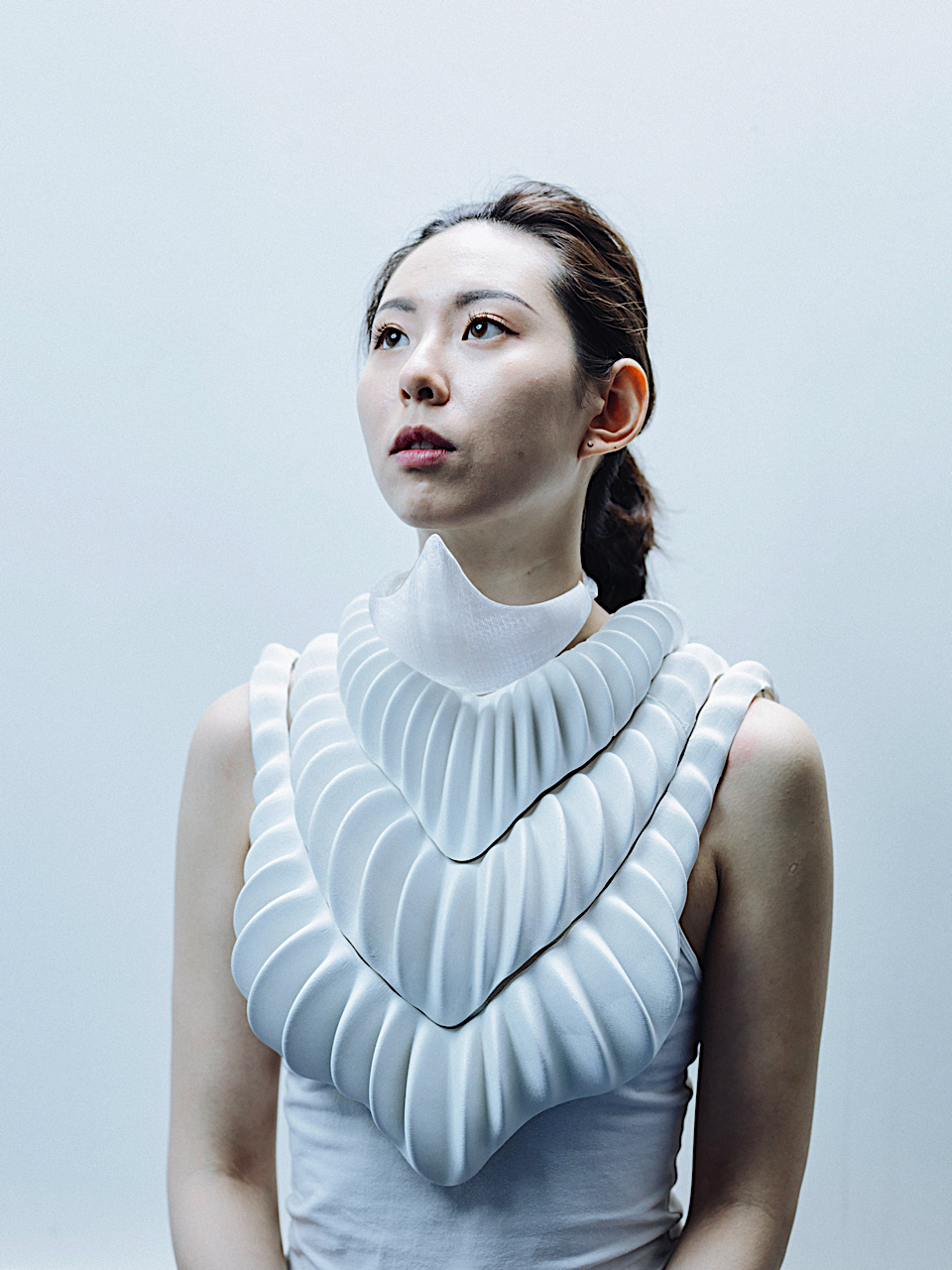
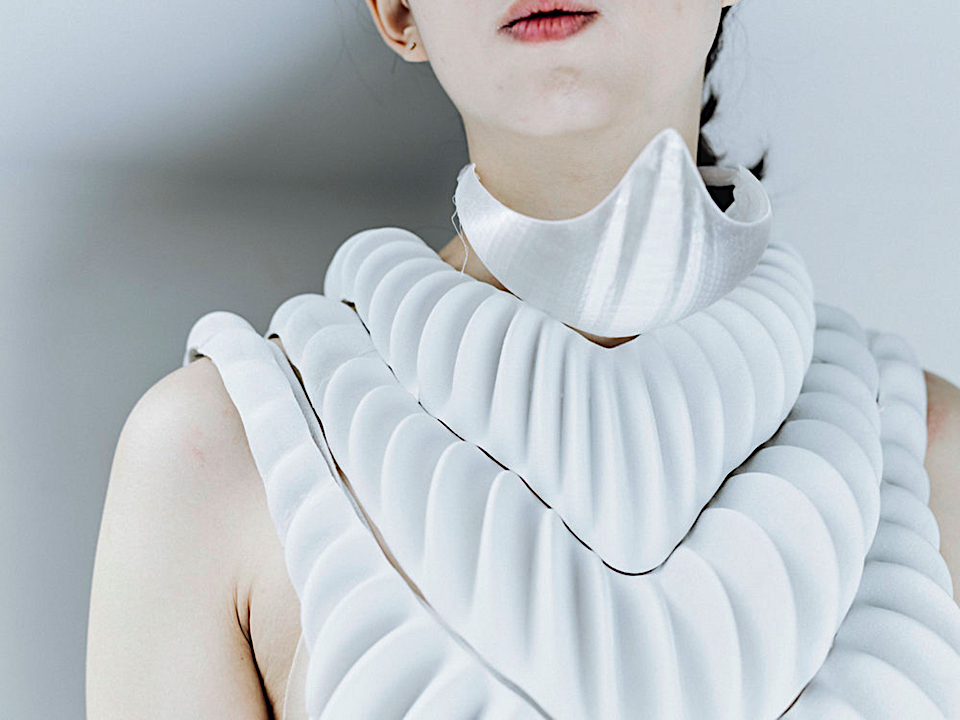
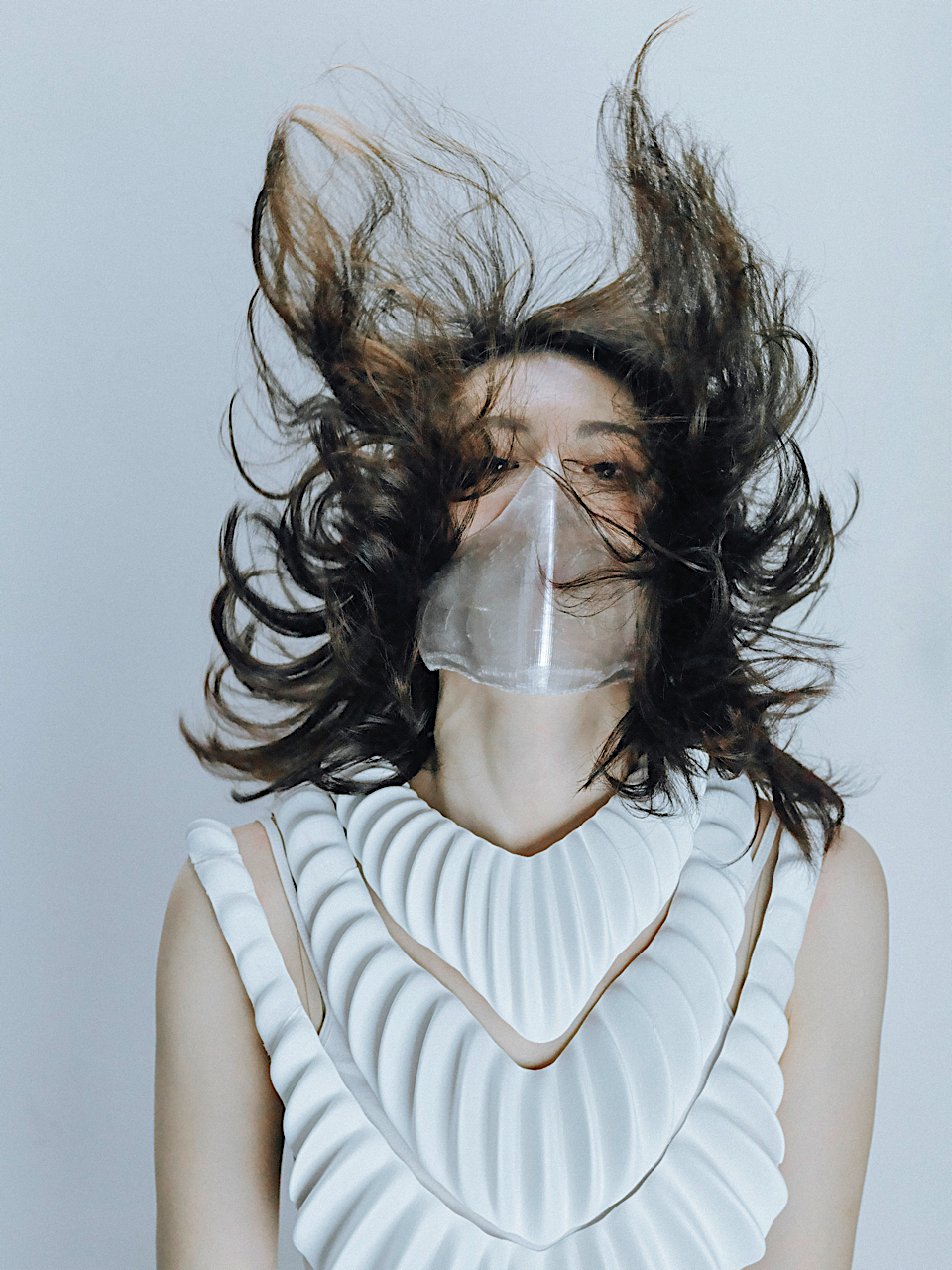
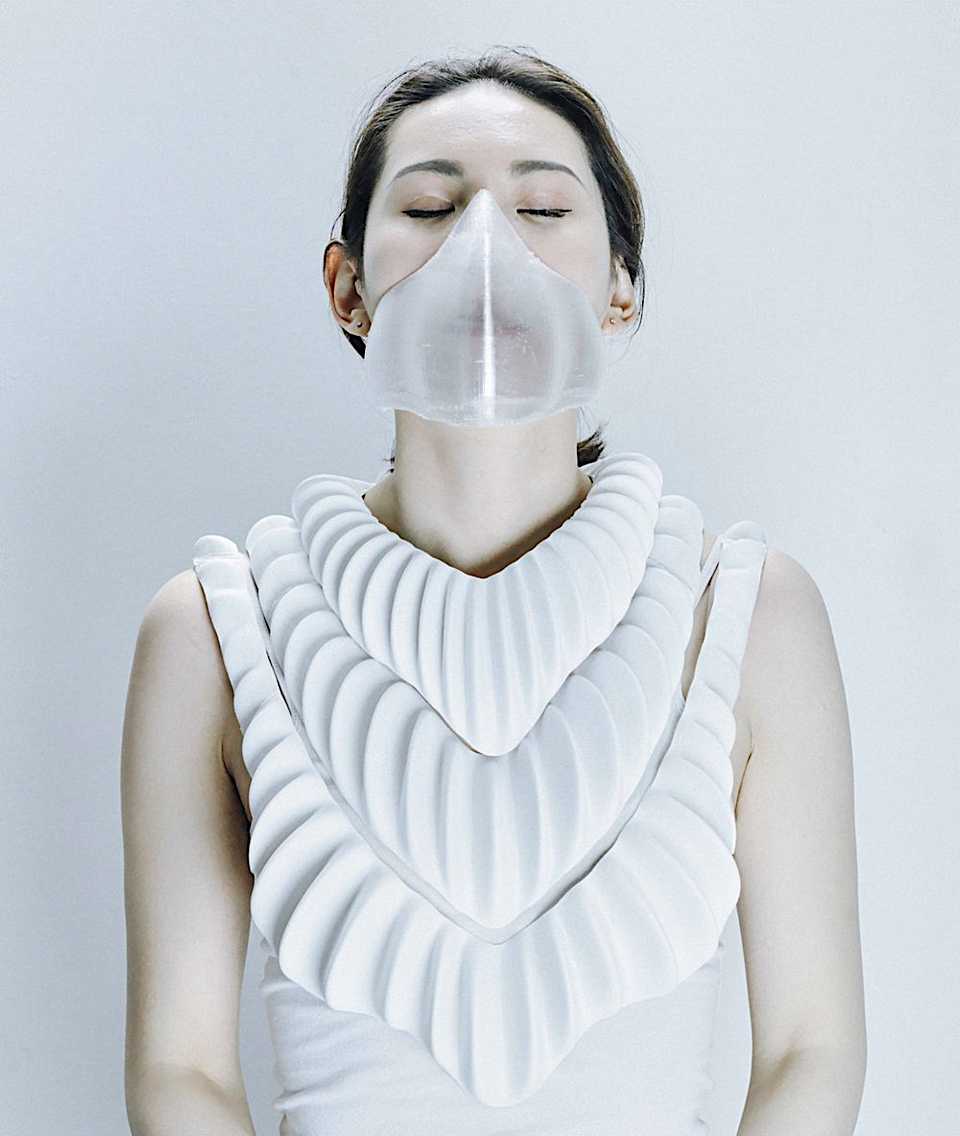
like a pearl in my hand
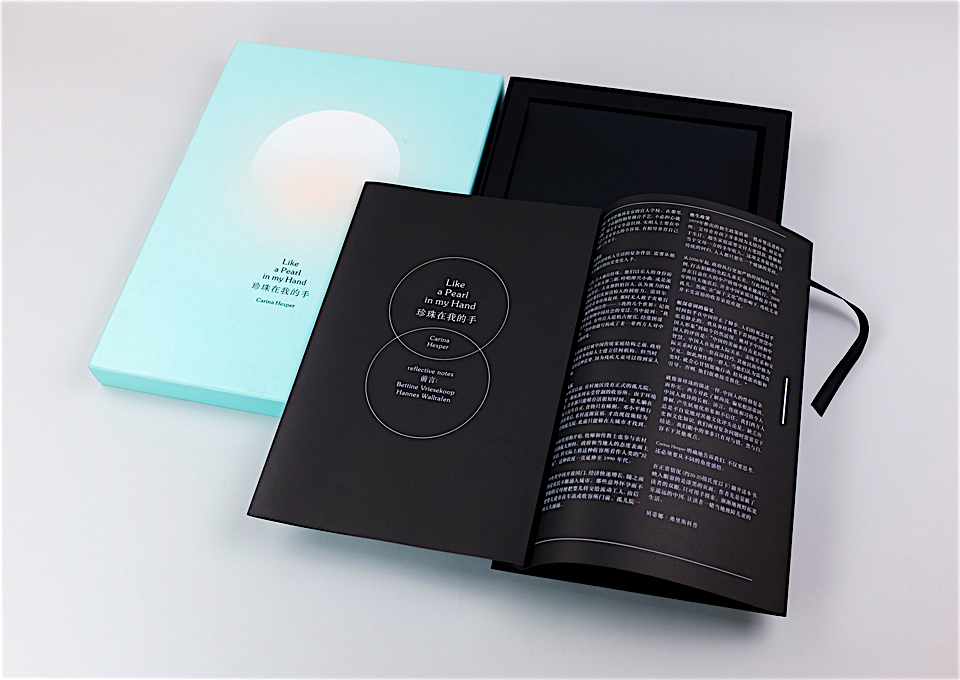
Imagine opening your eyes to complete darkness, for a lot of us unthinkable for others daily truth. One reality isn’t better than the other, it is just different. Nonetheless do we tend to believe we know and understand each other’s reality, with all the prejudices this entails. Nothing is less true, we should not try to fill in other one’s stories, we should be open to appreciate ours and other’s disabilities as stories worth sharing and learning from.
Like a pearl in my hand is a heart-warming project by Carina Hesper, a visionary maker with a predilection for making vulnerability tangible. The arise of this piece of art started in her early teenager years when she experienced the magic of a coffee mug that changed image as soon as hot liquid was inserted into it. It took some years before she translated this inspiration into a tactile piece of art, but it was worth the wait.
The signed edition box, which is named like a Pearl in my hand, uncovers portraits of China’s visually impaired children in a very revealing way. When the one-child policy was introduced in 2013, many parents gave up their disabled child because of this new law. Although in 2015 the law changed to a two-child policy, parents where to0 afraid to lose face by having an disabled child. Touched by the hopeless faith of these human beings Carina travelled to China to visit the Bethel orphanage to seize the real face of China.
Like a Pearl in my hand became a project about awareness, about understanding and about hope. When capturing a Albina girl and hearing her story about being blind and all the comprehension which it causes, she realized that we think we understand each other but in reality there is so much more to learn. That was her lightbulb moment, where she combined the story of the Albino girl, with her coffee mug inspiration and her desire to give the visibly impaired orphans of China a voice.
For her final piece Carina completed the different portraits she made in China with several layers of thermochromatic ink, to make the viewers experience what it means be to without sight. The ink turns the whole portrait black, it is only the heat of one’s hand, which is around 20/25 degrees, that can make the ink transparent for an undefined moment of time.
“It was the most complex work I’ve ever made, technique and emotion are brought together, but I’ve learned so much from it” – Carina-
This box is the embodiment of so many current trends in our society, a multi-sensory experience which encourage social awareness. The first link people make with art is that you can only look at it, Carina is fighting that status quo by challenging people to forget what they know about the handling of art. Like a Pearl in my hand is moreover a fully personalized experience, maybe not the way you might expect though. The user decides where to put down a hand, the warmth of this specific hand decides what one will see, so the experience will be different for every single person and therewith as unique as can be.
Like a Pearl in my Hand will be presented as a limited and signed edition book of 250 copies, In a special box with texts by Hannes Wallrafen and Bettine Vriesekoop.
The box contains 32 prints, all fully coated in the interactive black thermochromatic ink. The official “invite only” book launch will be at FOAM Amsterdam on the 19th of January 2017. In the Future Carina aspires to make a more affordable version of her story worth sharing. A version for the whole world to experience and to raise awareness because her core mission is to make the world more open minded.
www.carinahesper.nl
Cecile Cremer
Extremely curious and always searching for little weak signals that tell us things are changing. Cecile is a trend researcher and creative concept developer with the wanderlust of a cosmopolitan.Her aim in life is to develop things that matter to others and to help others change their strategy to be ahead of the future. Because she believes “The future is ours”.
www.wanderingthefuture.com
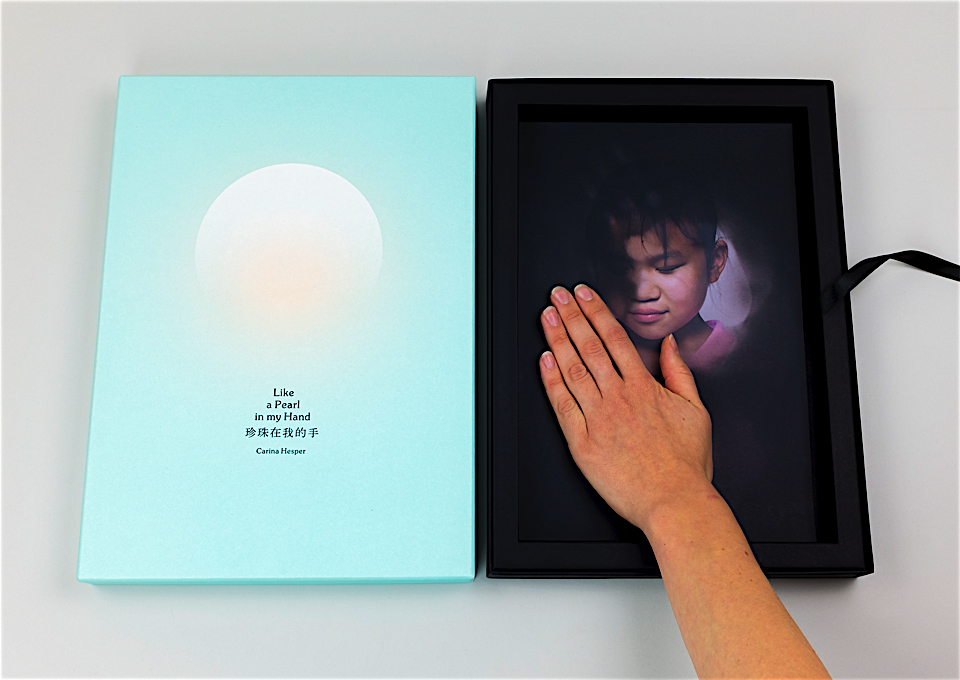
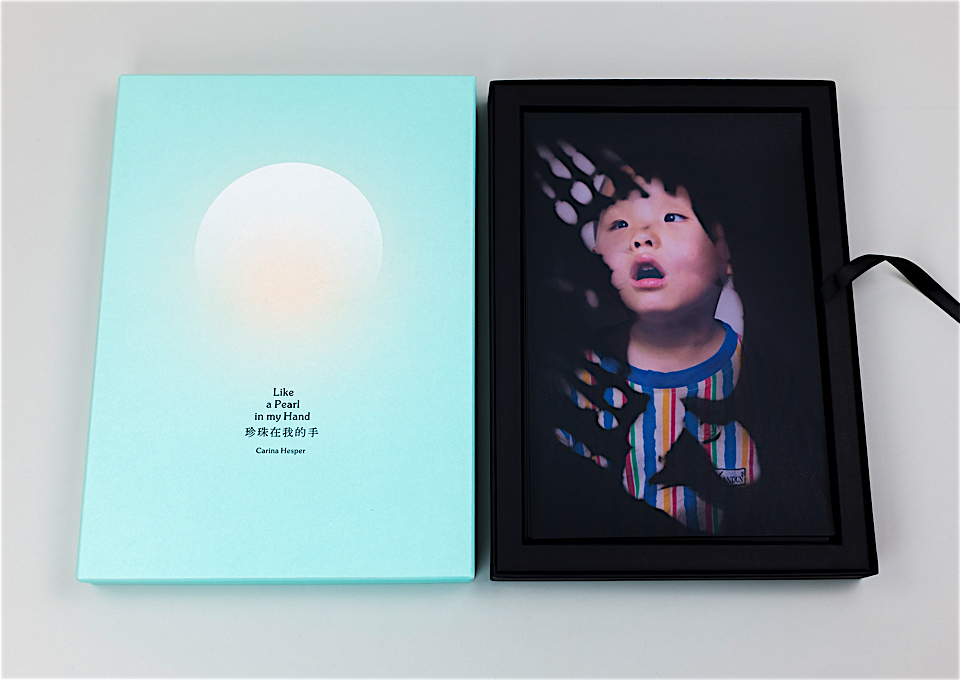
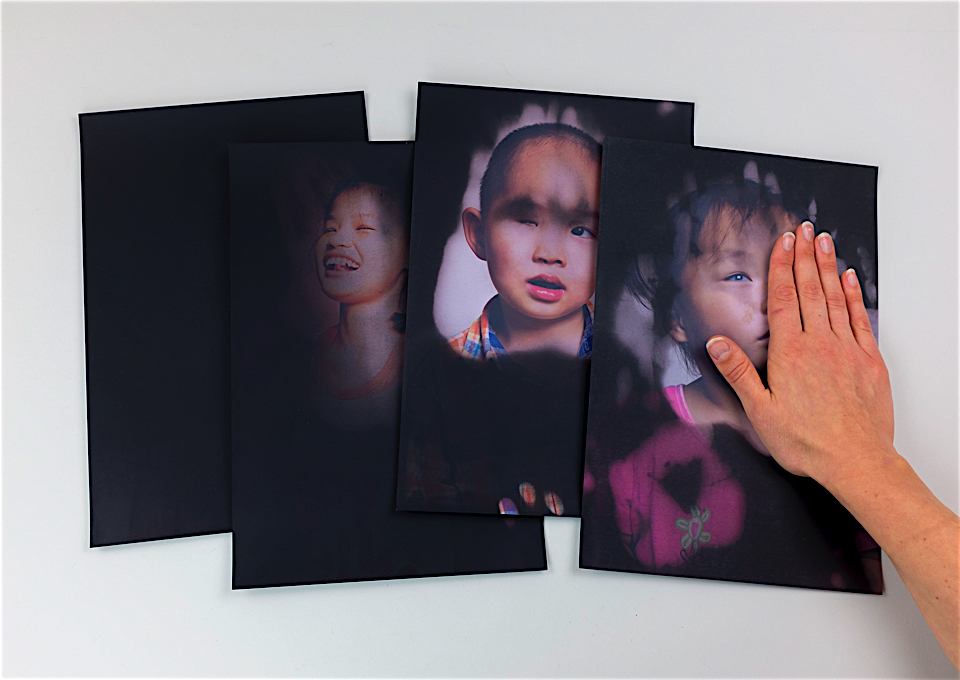
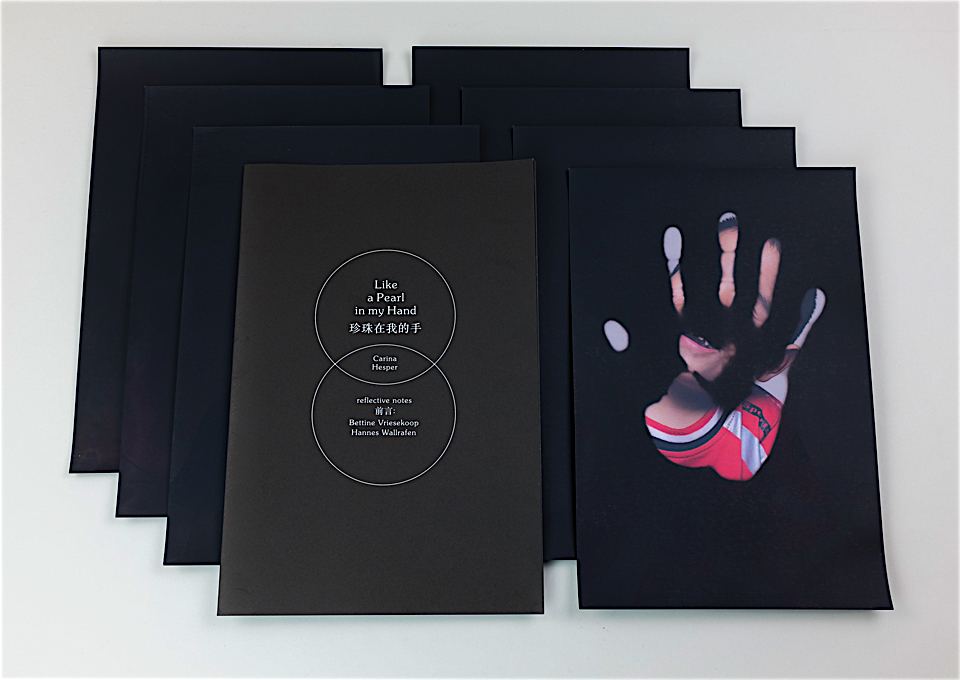
anima
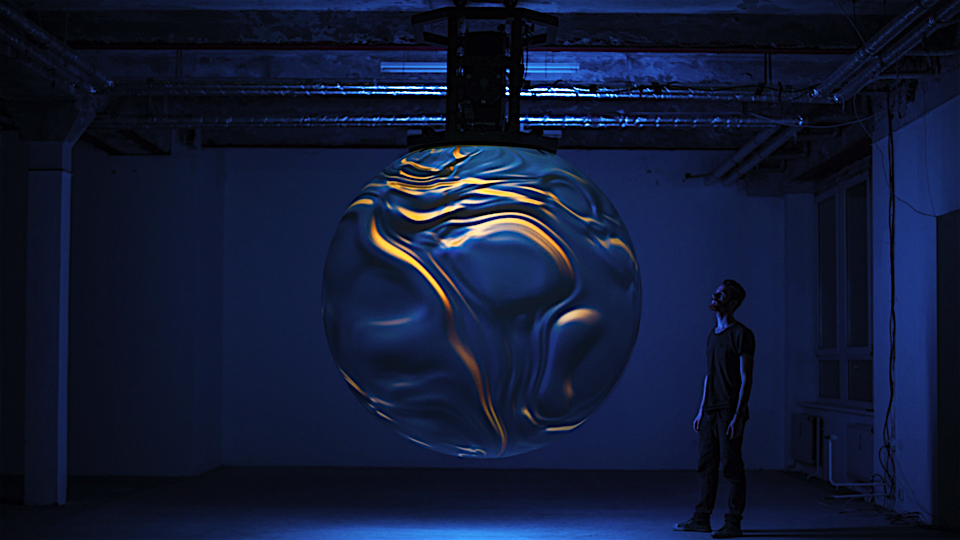
Contemporary artist Nick Verstand collaborated together with digital design studio Onformative and spherical projections experts Pufferfish to develop this enchanting interactive installation called ANIMA.
ANIMA explores the nature of living things. The interactive art installation investigates how humans emotionally relate to an artificial entity. By the use of a single projector coupled with a hemispherical lens the spherical imagery is achieved which emanates from inside the object. Both image and sound are generated in real-time, based on the entity’s contingent perception of our presence.
How would you describe yourself as an artist?
I think my approach is quite different from the 'traditional artist'. My way of working is the result of my diverse background in artistic media like sound and light, as well as my entrepreneurial background starting and running my own creative agencies. This leads me to work on projects that are beyond my comfort zone in terms of artistic skills. Over the years I learned to trust my ability to collaborate with others that are skilled in a specific field, and create something greater than everyone’s individual skillset, including my own.
How did your background in music influence your project?
I got into electronic music at an early age, starting playing and producing records around my 19th birthday. Back then I was studying for my high school exams and needed distraction, and discovered I much preferred working on music than studying. Shortly after I quit my studies and started being involved with music fulltime. The thing I love most about music is the flow it creates when experiencing it. It is so intuitive and meditative, and creates a space for me beyond rational thought. I try to imbue this feeling into my artworks as well. My perspective on a lot of contemporary art is that it's often quite rational. What I hope to achieve is to create experiences that are more mysterious, like a great record feels to me. Something that we can love from our soul not only our rational mind.
What fascinates you about designing a project like ANIMA?
What I really liked about creating ANIMA is the possibility of actualizing something in physical reality that started as just a tiny idea in my mind. This realization was so profoundly powerful, that it completely liberated my thinking about any future form factors. This was possible because of the incredibly skilled team we assembled in the process.
Can you describe your creative process?
Normally all this isn't linear, but from the perspective of this interview I wrote down some steps:
Assembling information of the world around us, cultural events, questions of our time, scientific/technological developments, works other artists are producing, etc. this is a continuous process
When at a calm moment, let's say I take a walk in the forest, and my mind is open and unused, some of these happenings are able to connect.
This connection I then scrutinize and developed further by researching its, often scientific, background. I then formulate a rough idea of what the audience will experience, from which results what the form factor could be.
Breaking down the form factor into its specialized components and finding the people who are able to design and execute it. This phase often also means trying and secure the funding as well as finding a relevant location to showcase the project once it's complete
Now the actual design phase begins, where I work with the team of artists, technologists and scientists to design and develop the piece
Exhibiting the first iteration of the work, after which I look for more opportunities worldwide and further develop the work with each exhibit. I do this because I need to gauge the audience their reactions and attune the piece to their behavior. A work often feels finished after about 4 or 5 showcases.
How did you end up working together with the Berlin based digital design studio Onformative?
When I created the concept for ANIMA realized early on I needed some stellar programmers to create the generative fluid emulation I envisioned. By searching the internet I found Onformative's website and got in touch, after which they joined the project. From this I learned you can just reach out and ask for a collaboration.
Are you currently working on a project?
Always! I develop projects in parallel with different teams to achieve a sort of constant output. One project I am currently working on is a new iteration of a work called POLARIS for SXSW 2017 in Austin (Texas, USA). This project I develop in collaboration with Dutch science institute TNO, who are helping me to create a way to measure the collective emotional experience of light, sound and space in real-time through the brainwaves of the audience, which we then feed back as color and sound in the encompassing space.
What does the future hold for you?
Hopefully a future in which I can travel the world, create the things I imagine and share all this with the people I love.
Interview by Claire Claire Gralund
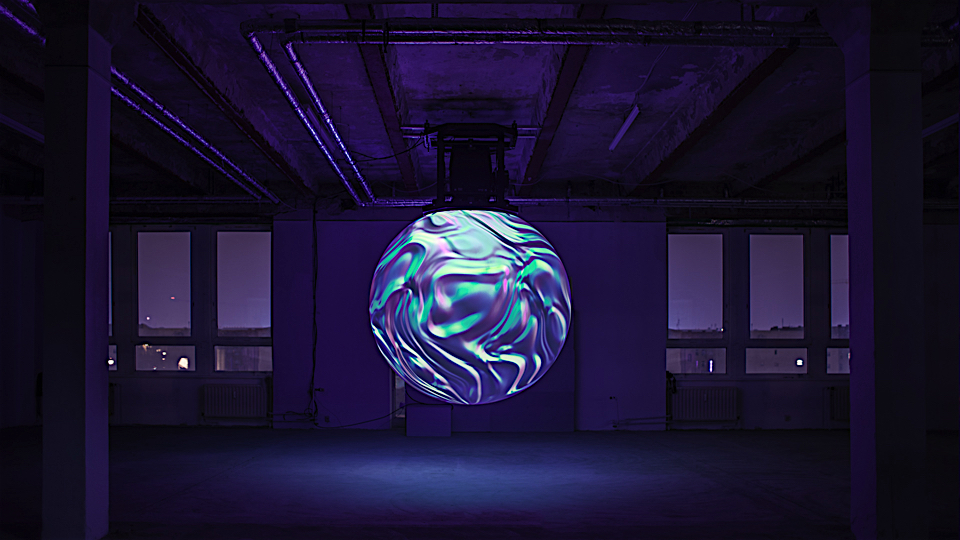
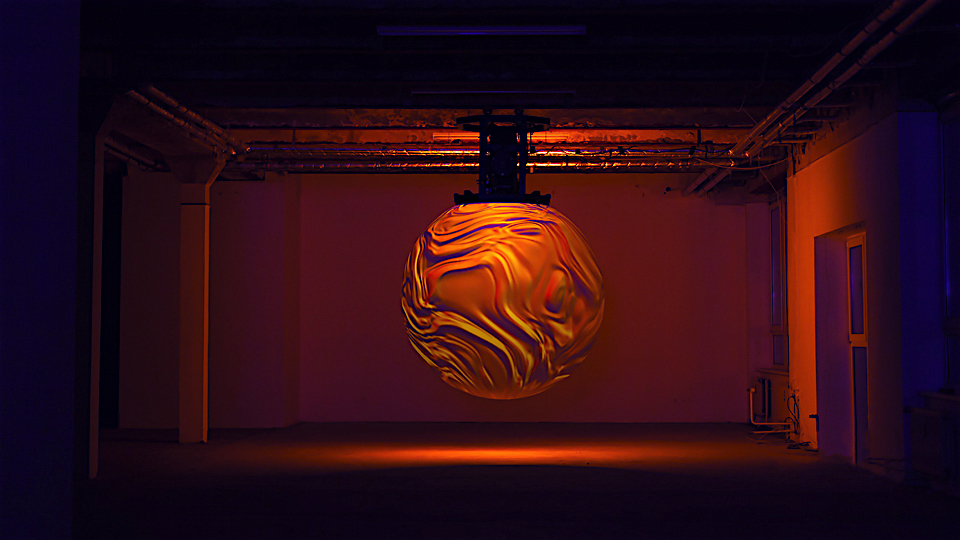
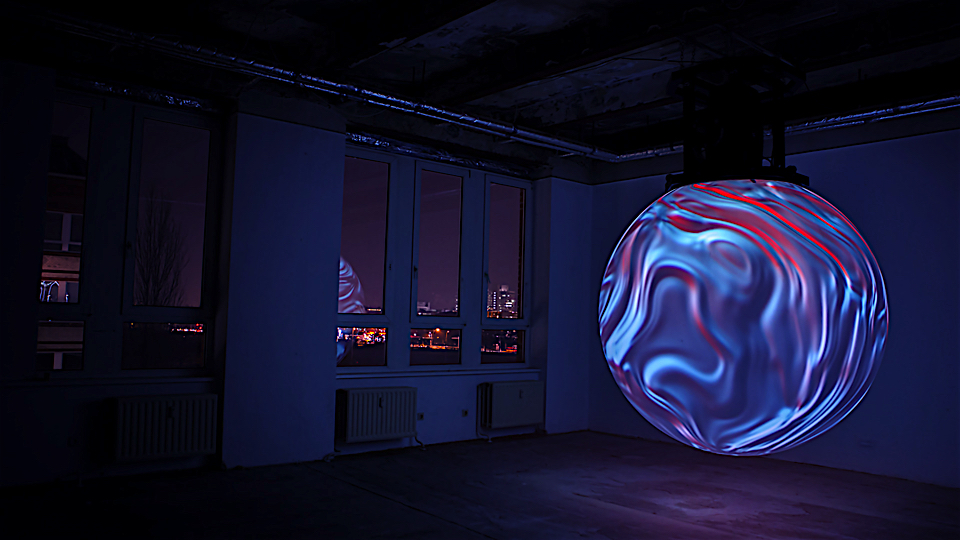
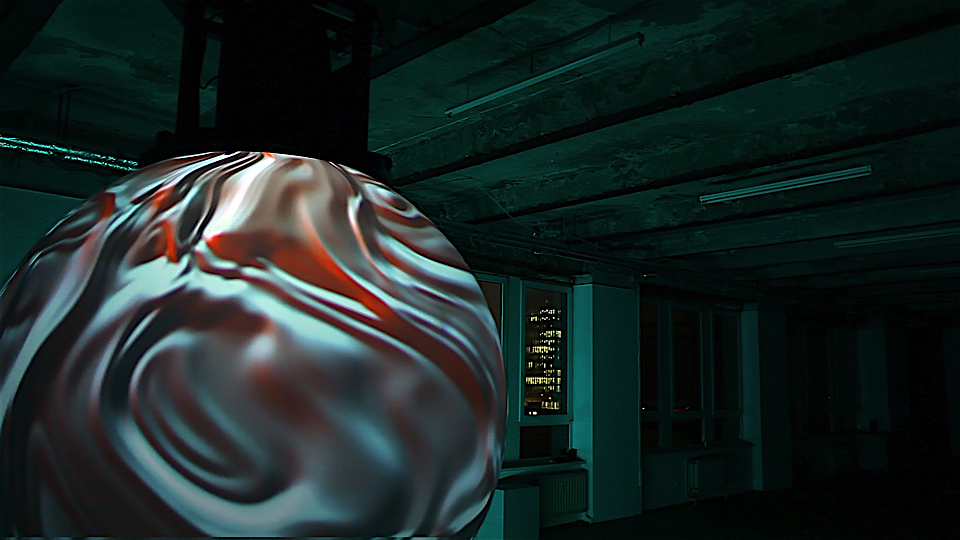
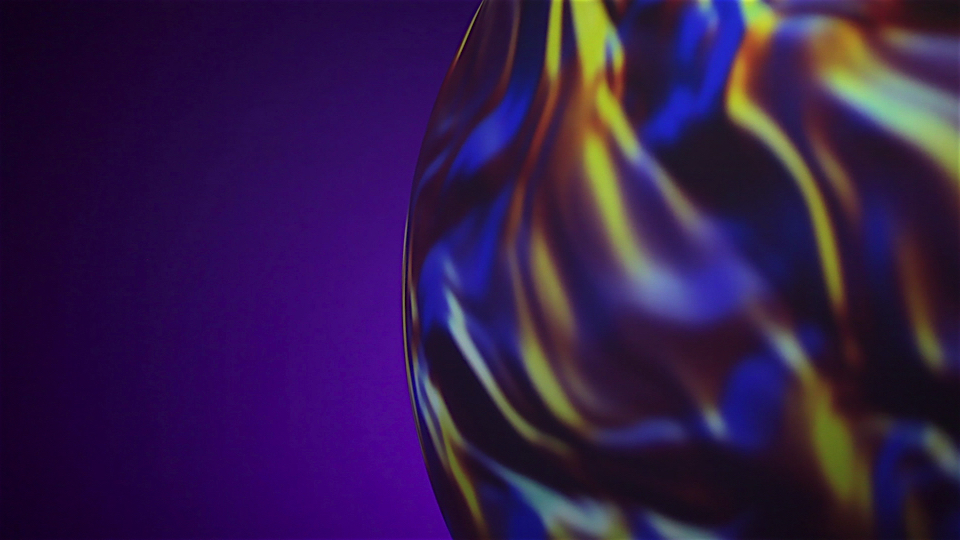
ishu
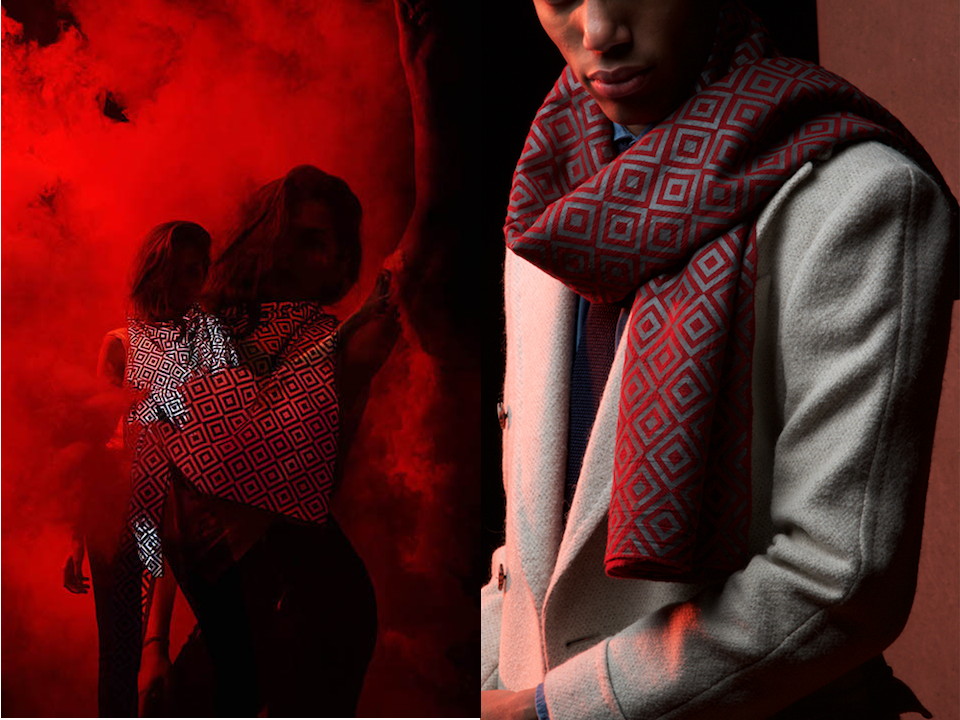
Ever wished that your friend, little brother, stranger wouldn’t take a picture of you? Bad hair day, hangover or just not feeling your best. Whatever the reason, sometimes we can’t control the digital content people put of us online. In a world where the choice to remain anonymous is no longer a choice, the ISHU scarf comes handy. Officially launched in October 2015, the product combines fashionable prints with technological functionality that black out the wearer. Think of it as an invisibility cloak. Whenever you don’t want your picture to be taken just wrap yourself with the ISHU and the final image will be just a black silhouette.
Five months into the market and the ISHU has gathered a bunch of celebrity fans. Nick Jonas, Nina Dobrev, Cameron Diaz and Paris Hilton have already been spotted wearing it. We sat down with Saif Siddiqui, ISHU’s founder to chat fashion tech, privacy and entrepreneurship.
Tell me about your background and how you started the ISHU?
I came up with the concept six years ago. Within those six years, I joined IMG William Morris, where I worked for four and a half years and also started my own company – Access All Brands – an online product placement platform which helps brands reach celebrities and influencers. Five months ago I launched the first ISHU scarf. It’s an antiflash scarf, which means if someone takes a picture of you, your face blacks out so you don’t see anyone in the picture apart from the scarf.
Do you have technological background?
No, I have no professional background in anything that I’ve ever done. I mean, it’s technology, it’s culture, it’s new and changes constantly. I like to try out new things and experiment, so If I want to do something, I’ll figure out how to do it. I know a lot of people who have professional background in the things that I want to do. If I’m not a professional and expand my team with someone who is, that becomes a part of me because I work with that person on a daily basis. For example, I don’t have a complete sales background but I have great sales people on the team who look after that. I’m doing what I know best, which is elevate a business, travel and meet interesting people along the way who I can learn from. I like working with the best because this is an extension of the brand.
Why scarves?
I’ve branched out with a couple of different products – children’s, women’s and men’s collection – but the initial product was the scarf because it’s an accessory. It’s easy to wear, it’s for men and women. It’s easy to carry around and it’s close to the face. Adidas and Nike use reflective material on their shoes but it’s on your foot and you obviously can’t hide your face with it.
Can people buy them anywhere?
Yes, we are going to be in Harrods. We’re in different department stores in Holland and Germany, some boutique stores in South Africa and you can also get them online. They start at £200 and go up to £400. We also do ties and pocket squares that go for 70 pounds for the combination. It’s a cool gift idea. They have the same functionality and the quality is impeccable. I didn’t spare a dime on them. We also have hoodies, with patterns on the inside, which can black out pictures if you unzip them but they’re zipped up you can still see yourself in the pics. They’re not in your face, so the functionality is optional.
What’s the feedback so far?
People love it. They see the product first and they like it for the way it looks. When they find there’s something more to it, they’re wowed because it’s like an extra thing you’re adding to something that they have already shown an appreciation for. We’ve shown it in London, Paris, Milan, Berlin, LA, Dubai. Everywhere we go people love it and I’m really happy with it because it’s been six years of work.
A lot of people who wear the ISHU scarf are celebrities. Is that the type of client you’re going for?
Not really. It doesn’t matter if you’re a celebrity or a normal person like you and I. For example, I don’t always want people taking pictures of me and I want to be able to control that. Celebrities have picked up on it but I only feel like this is because they’re really privacy sensitive. They understand what it’s like when people are taking pictures of you all the time. But everyone’s got their own brand online nowadays so I believe people will become more aware that there is a power behind mystery. At the moment celebrities have picked up on it, which is good because it obviously helps with press. We get good recognition, which we’re really happy about but it goes beyond celebrities. It’s a about people and privacy. This is why we’re also we’re doing the children’s collection.
Can you tell me more about it?
Well, if you have a child, it’s your number one priority in life. Being able to control who takes a picture of them is important. So I thought a children’s collection will be appropriate. That’s why we have jackets, basic wear and also fashionable streetwear clothes. No one else does that yet.
It doesn’t matter if you’re a celebrity or a normal person like you and I. Celebrities have picked up on it only because they’re really privacy sensitive.
You mention security and privacy a lot and obviously that’s the reason behind the scarves. Do you think privacy is becoming a luxury nowadays?
Don’t get me wrong – having social media presence is great because all of a sudden you have a platform. You can test products, services and talk to a lot of people. But there’s always another side too. There are problems with social media and everyone has a love-hate relationship with it. Whether that’s because of online bullying or something else. I think people are really weary of social media. So we give them control of the content that people might want to publish without their consent. Digital content is here to stay and I feel like people forget that sometimes.
I remember you telling me that the concept was born in Amsterdam. Has Amsterdam had an influence in terms of developing the product?
Absolutely! I think Amsterdam is one of the greatest cities because as an entrepreneur, artist or a creative, Amsterdam provides so many different platforms and ways to execute your idea. I have the Amsterdam mentality of saying I’m going to do something and actually doing it. In London, for example, there seems to be a lot of talk but not enough action. The Dutch actually make it happen. And we also have a lot of support, close community and people who look out for each other. In London, it’s you and a million others so you have to fight your way through.
As an entrepreneur, money is always an issue. I mean, there’s a reason why Kanye West is asking for a billion – because he wants to do more. As a creative, you always want to do more. The more money you have, the more beautifully you can present your event or fashion show and the better your products will be. It’s much easier for us to open a store in Holland than, let’s say, in Shoreditch. If we want to gather a team in an office space in Holland, it’s a lot easier than in London. We don’t have the money barrier so we get to try and test a lot more in Holland before going to a bigger city. That’s why we also look at places like Denmark, the creativity there is amazing. That said, after a while in Amsterdam, you want to move out and go bigger, expand. But that Dutch mentality is invaluable.
What are the plans for the future?
I want to release new products and do things that people don’t expect. I really take it day by day. I know what my end goal is but I don’t know exactly how I’m going to do it.
What is your advise to anyone who wants to start in the industry?
Just go and do it. Stop wasting time talking about it. A lot of people are scared for the outcome so they just back up. But no one else is going to do this for you. There are billions of people on this planet but there isn’t anyone who is doing what you’re doing the way you want to do it. If there was, you’d already know about it. So even if it goes bad, the world doesn’t end after one decision. Just go with it.
Kristina Dimitrova
theishu.com
Kristina is the founder of Interlaced - a media and event platform highlighting everything exciting in fashion and technology. In 2015 Interlaced hosted their initial conference and one of the first fashiontech catwalk shows in Europe. Kristina often speaks at and curates industry events. With marketing, advertising and PR background, she also writes about the intersection of emerging technologies, media and consumer culture.
interlaced.co
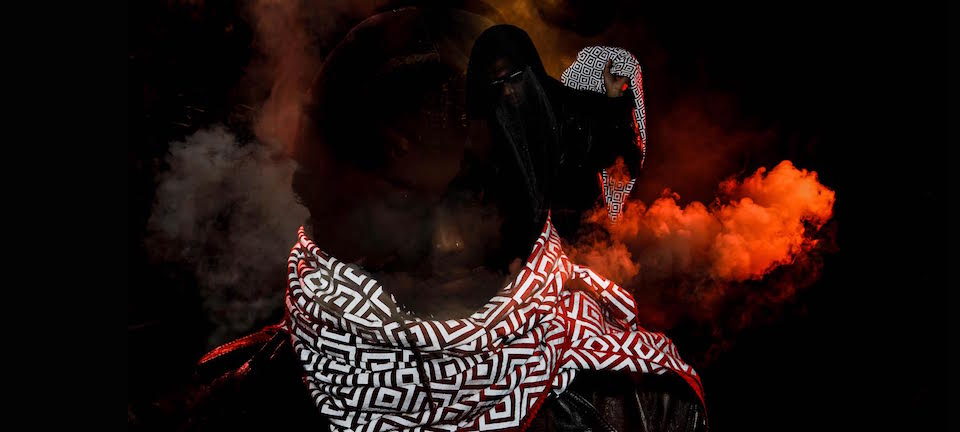
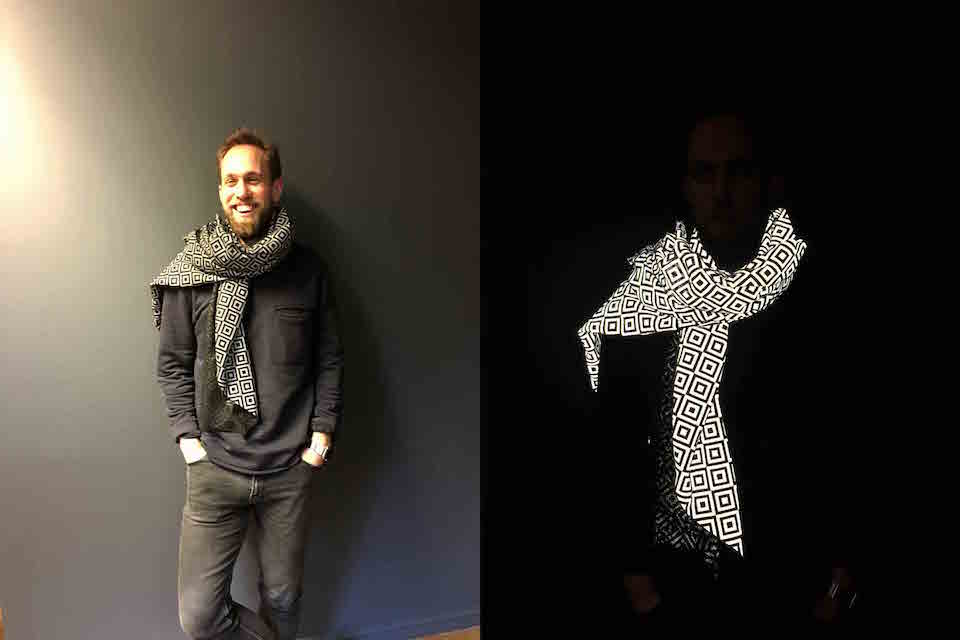
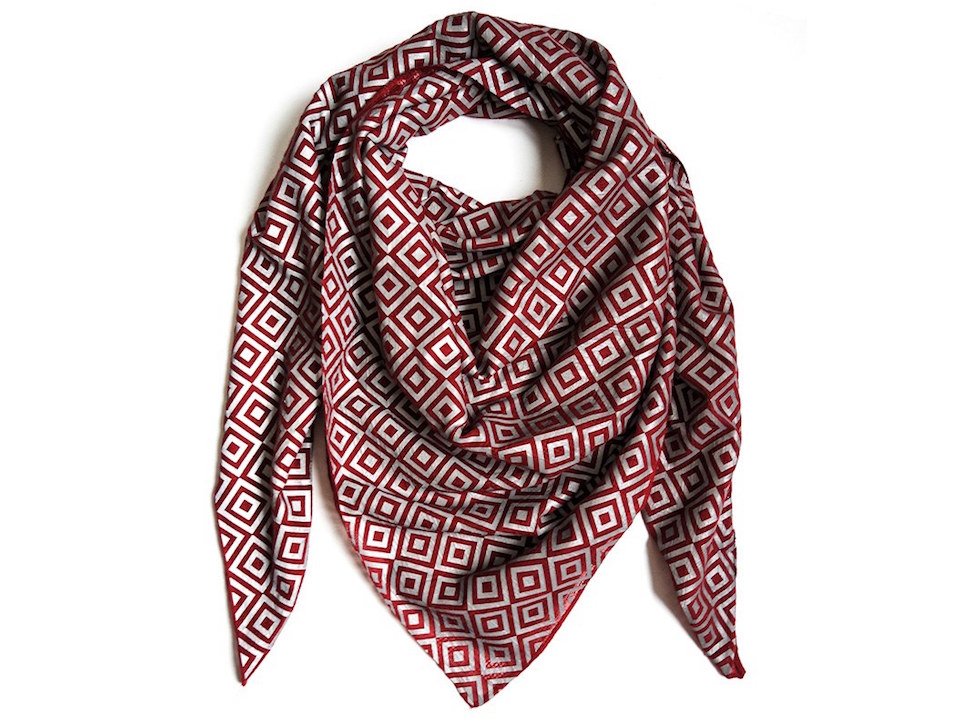
Body Electric by Clara Daguin
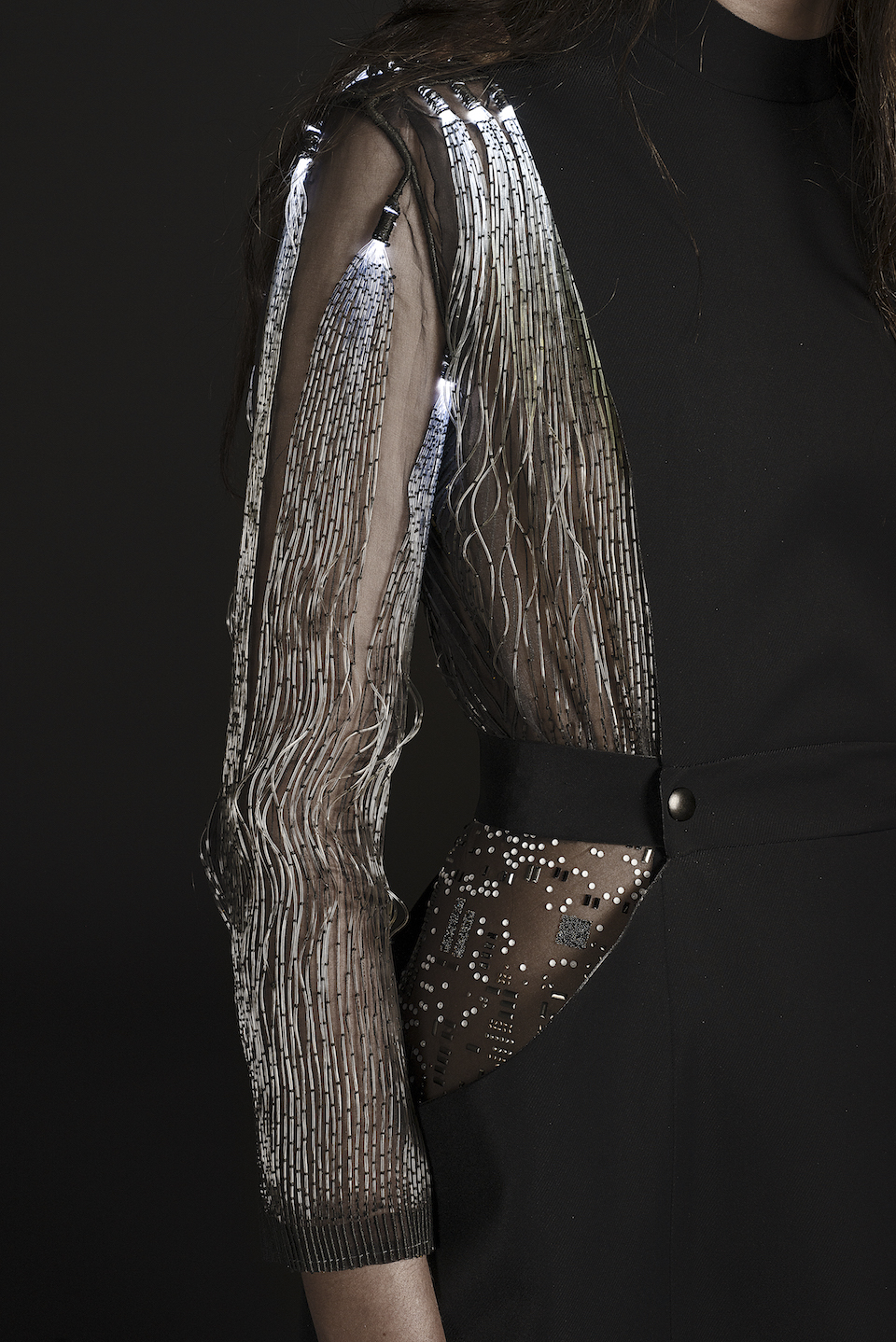
As one of the ten Hyères International Festival young designer finalists this year, Clara Daguin presented her Body Electric collection this April. In addition to a Masters of Fashion Design at ENSAD in Paris and a Bachelors of Fine Art in Graphic Design from CCA in San Francisco, Clara has previously worked for Margiela, Alexander McQueen, Hussein Chalayan or Iris van Herpen. She grew up in the Silicon Valley and thus has integrated its culture into her creative process.
She believes it is essential to keep manual savoir-faire alive while embracing technology as both a creative inspiration and a solution-provider. Noémie Balmat sat down with her to learn more about her creative process and get her thoughts on mixing fashion with technology.
Could you describe your creative process?
It all begins with a thought or feeling, and a need to express it. It is paramount to begin by synthesizing the idea into a single concept, a sentence that can serve as a reference if the research leads me astray. Visual inspiration and experimentation with materials work in parallel with finding silhouettes through moulage. The technical/sometimes electronic aspect is very much a part of this exploratory phase. Sometimes it appears in the piece as a texture, or it can inform the shape of the garment directly. In the « body electric » collection the strict uniform pieces are marked by cut-outs which act as windows to reveal technical embroidery. The patterns of the complex garments underneath are directly based on the cut-outs of the uniforms. All in all it is mostly an evolution, developing aspects that resonate, pushing aside discordant elements to create a coherent whole. And of course hoping to surpass one’s original intentions and be surprised by the end result, because that is what’s most exciting.
How did you learn to code/the technical parts of your work?
I have always made clothes, but my first professional interest was graphic design. I learned code to make websites, the interactive aspect was what really pulled me into that medium. When I began studying clothing and fashion design I participated in a workshop with the MIT high-low tech group where we transformed basic IKEA chairs using simple sensors and motors, circuits and code to alter our relationship to them.
This idea of integrating circuits into things other than computers peaked my interest and I continued with a class called « augmented objects ». After that I was obsessed and every chance I got I experimented with different sensors and simple ways to integrate electronics into clothes and textiles. It helps that my father is a computer engineer, that I grew up in the Silicon Valley and that I am visually inspired by all things technical!
What did the Hyères festival bring you?
It allowed me to create a new collection, to work with a panel of professionals who helped showcase it beautifully, and brought visibility to my work. I have been asked to share the pieces for various photo shoots, a music video, to exhibit at D’Days and Tranoï Paris and Premium Fashion Tech Berlin among others, and am collaborating with an artist on a soirée for Lacoste. What is great about Hyères is that it is really a jumping off point for meeting interesting people, and these new connections branch out to new projects and collaborations.
Noémie Balmat
Photos: Alice Brygo
- Make up artist: Roussi Li, Vincent Brière
- Models: Lydia Ragot (brunette), Elise Speicher (long red hair), Flora Marchon (short red hair)
claradaguin.com
Interested in the future of fashion through innovation, Noémie Balmat has a valuable four-year experience in international advertising agencies and works with brands as a fashion tech consultant. Currently working for Soon Soon Soon as an Innovation consultant, she launched Clausette Magazine in November 2014 to gather cool projects linking fashion & innovation in one place. Sensitive to the technological and scientific evolutions, Noémie often speaks at international events, such as the Hyères International Fashion Festival.
clausette.cc
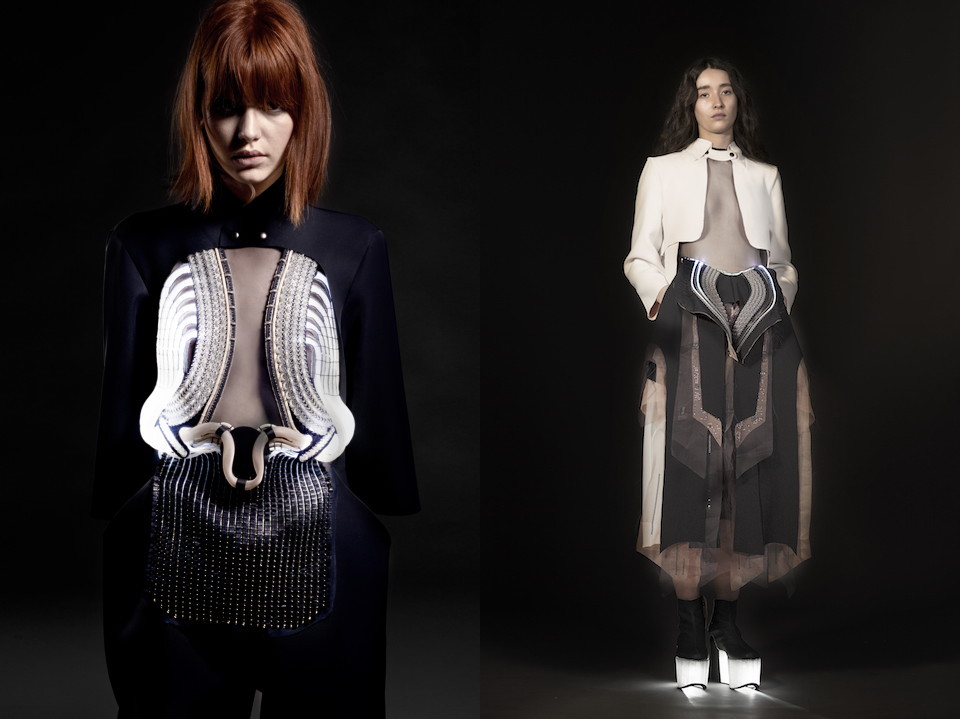
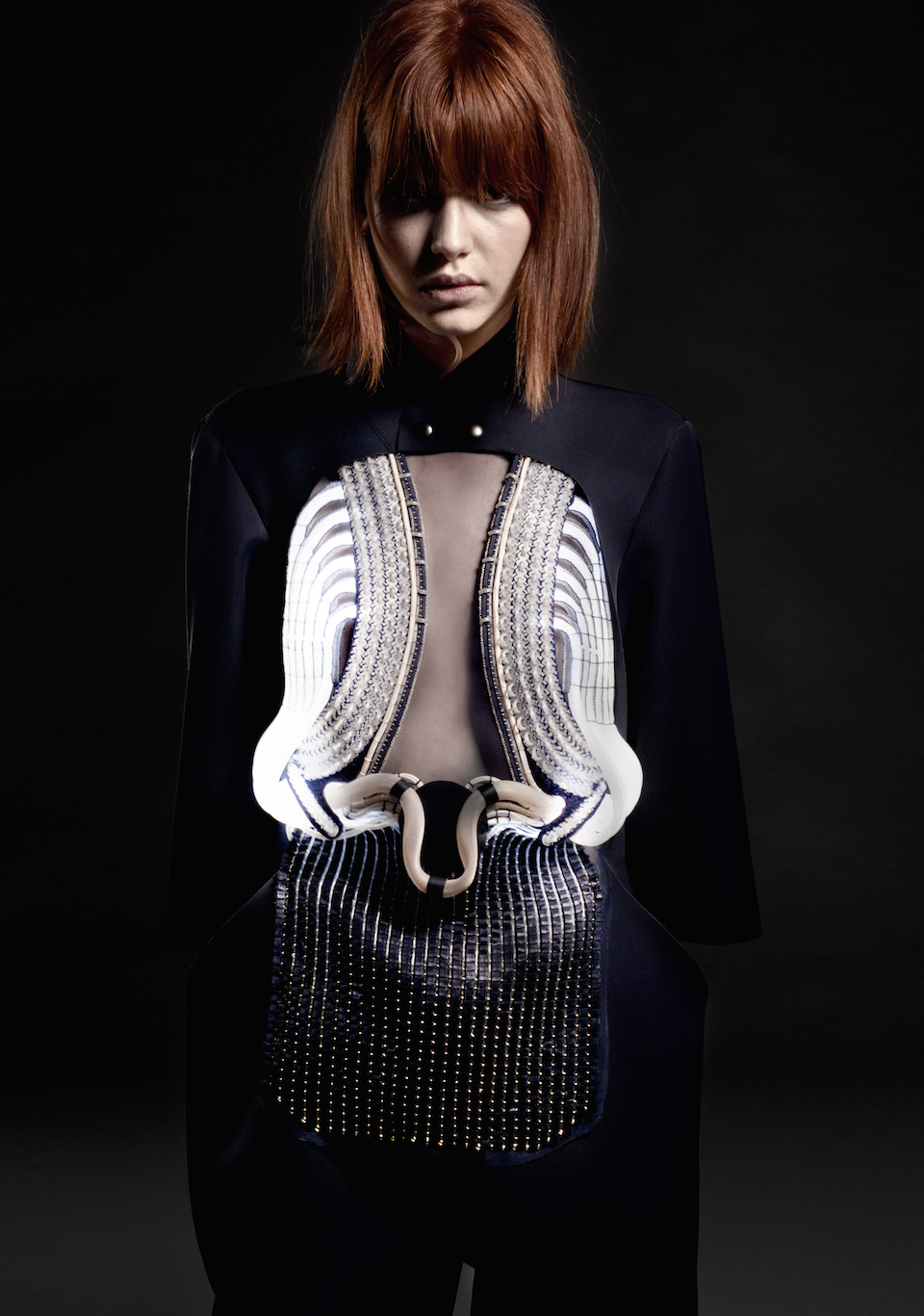
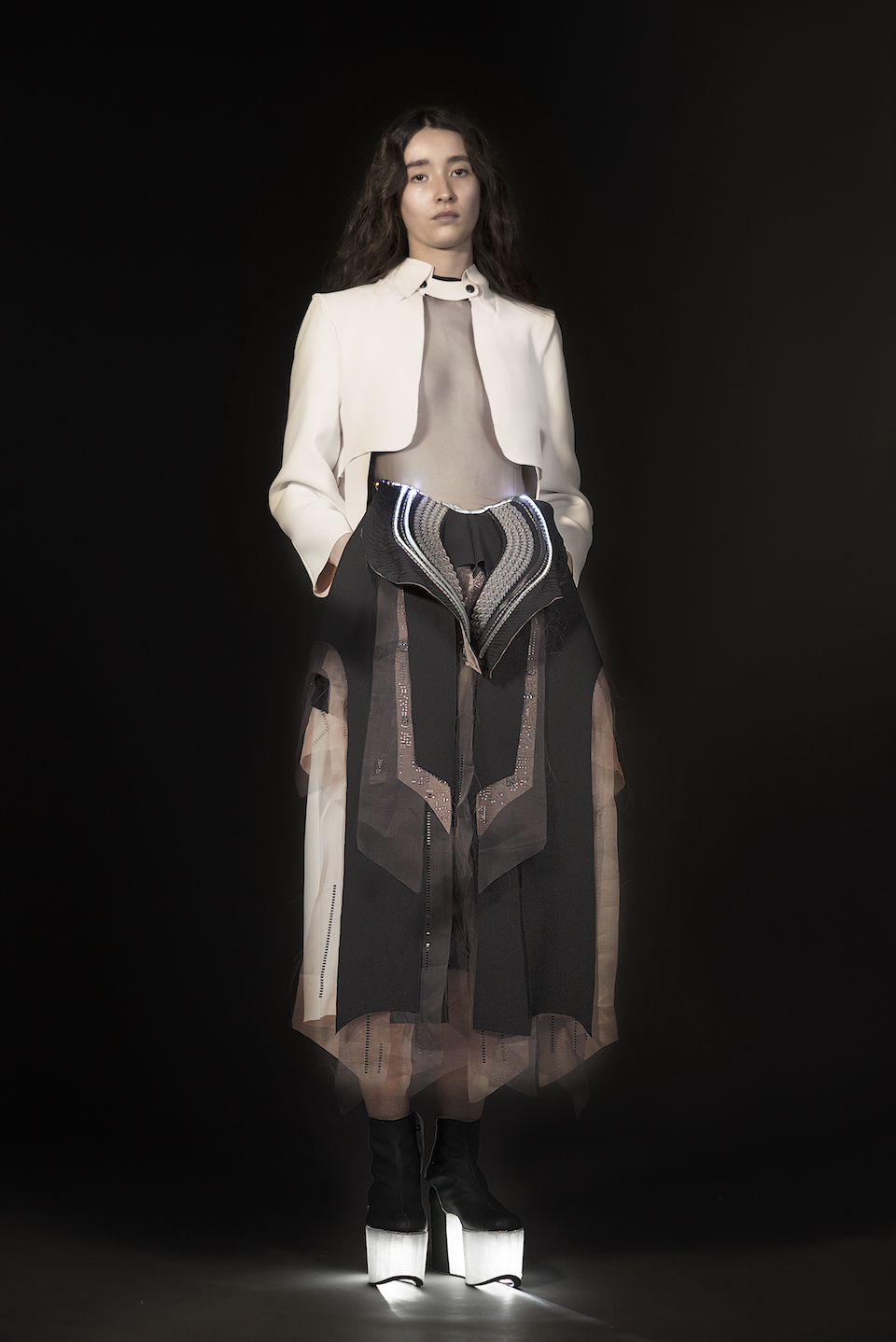
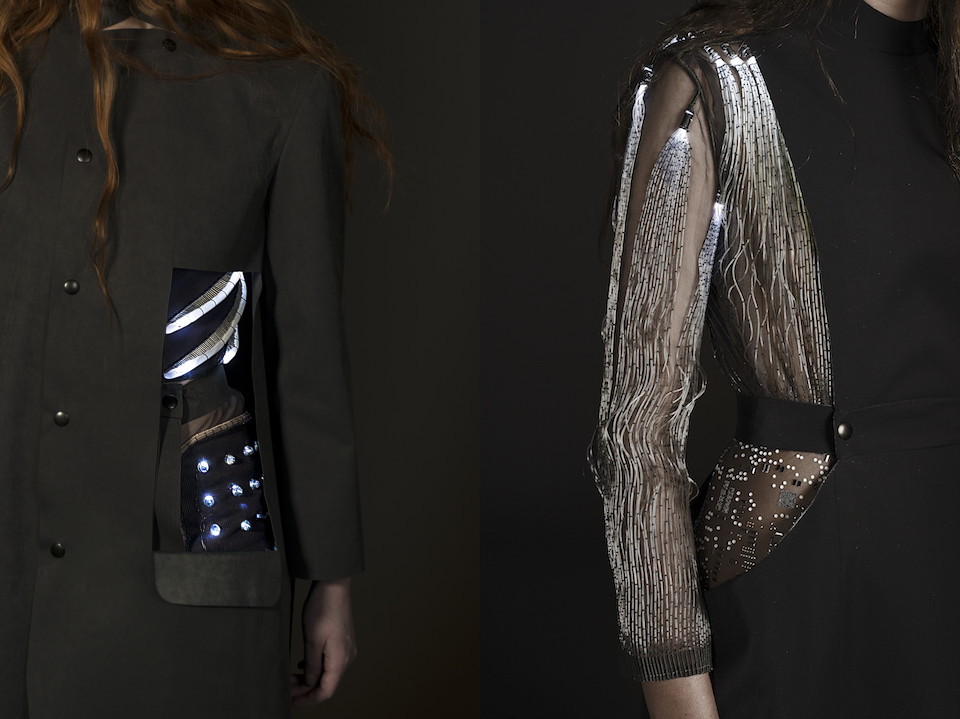
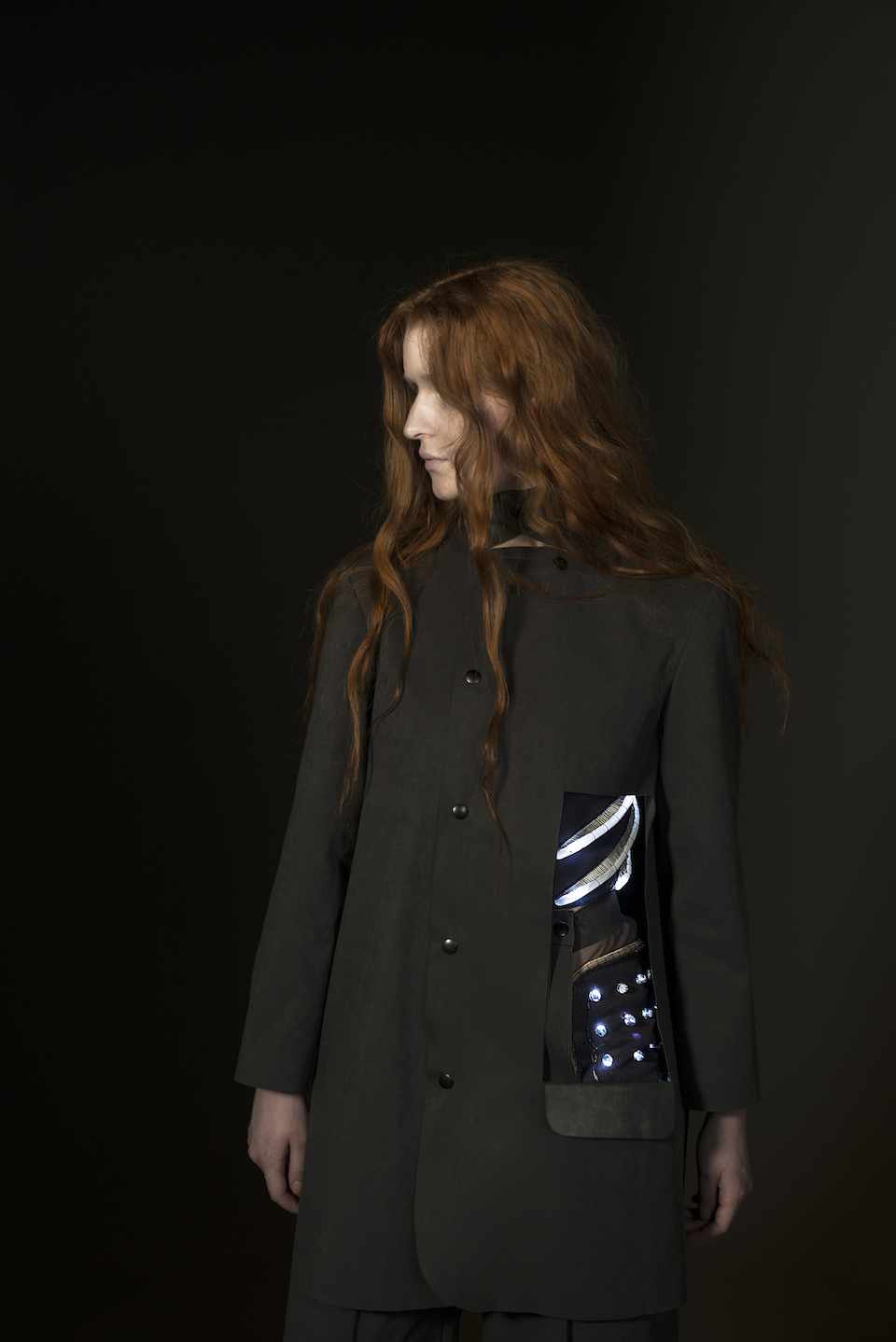
bioplastic fantastic
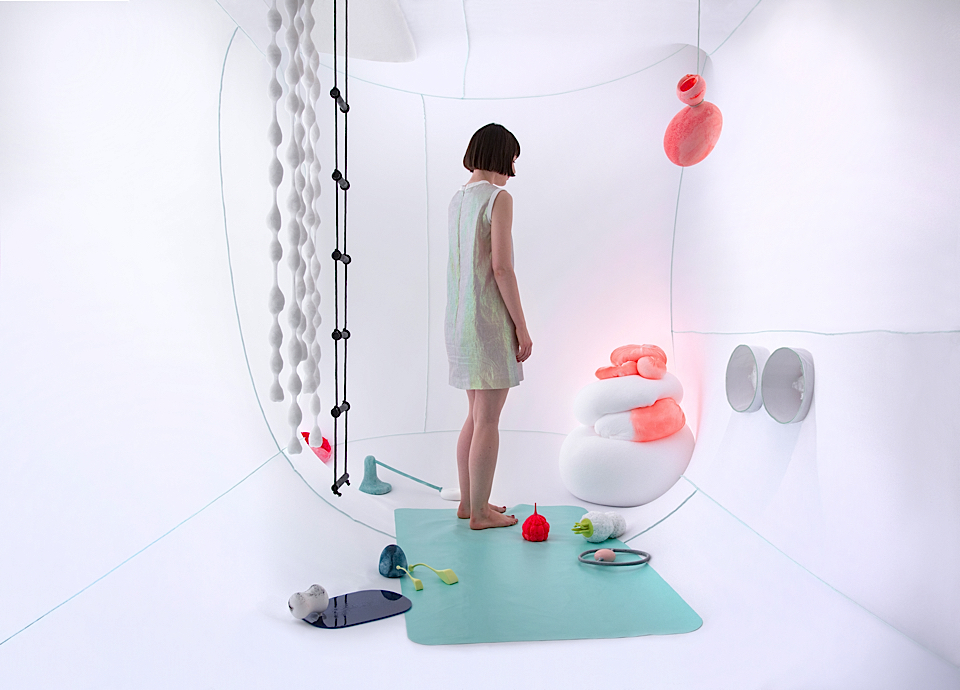
Bioplastic Fantastic is a speculative project by Johanna Schmeer, an artist acting on the border between art and design. Seven products presented by her complement the demand for nutrients and energy needed for humans to survive. Enzyme-enhanced bioplastics, powered by artificial photosynthesis, serve as the building blocks for the final product. Where did the idea of this futuristic project come from?
Everything started with research in three areas, the scientific background, analysis of how values and diverse circumstances in society shape technological products, and aesthetics / material study. Help from scientific advisors at Imperial College’s Centre for Synthetic Biology and Innovation allowed a broad exploration of synthetic biology, material science, and artificial photosynthesis topics. The project included workshops under the “designing biology” slogan. Interactions with the product based on a fictional scenario became a contribution to the formation of the final product.
Johanna Schmeer used the potential that lies in interactive design, which is becoming ever closer to the body and biology. It is more than likely that, soon, biochemical processes will take place in and on our technological devices. The concept of something halfway between a product and an organism is based on recent scientific research results of “biological” cells made from polymers and enzymes. Bioplastic Fantastic explores interactions which might emerge from the mix of material innovations with biology and nanotechnology. The designer investigates the topic of future design of domestic products made from enzyme-enhanced bioplastics.
Seven “biological devices” are used to produce food and energy needed for human survival, thanks to artificial photosynthesis. Products that simply need to be exposed to light to produce water, vitamins, fibre, sugar, fat protein, and minerals through biological processes.
The idea of a self-sufficient lifestyle which the designer proposes is a kind of conceptual utopia designed in opposition to the technocratic Silicon Valley lifestyle model. The biologically influenced aesthetics of this project reinforces the core idea that they are not machine-like or lab-like. Artificial sensuality, powered by biology, is the answer for the loss of the natural sensuality of traditional food.
The project asks the big question, to provoke discussion of a future design that is reaching forward to the more sensual and human solutions, perversely by using the latest scientific breakthroughs in bio- and nanotechnology, that don’t fulfil the ice-cold technocratic vision.
Agnieszka Polkowska
A designer by education and a trend watcher by calling. Head of Trends at Pop Up Grupa creative collective based in Warsaw. Author of No.1 Polish blog dedicated to emerging trends in fashion and design. Agnieszka Polkowska is also a doctoral student of Academy of Fine Arts in Gdańsk in the domain of experimental design and trends. This is also the field to which she dedicates her scientific work. Since she’s both a recipient and designer, she feels that her experience makes her a right person to share reliable analyses with the world.
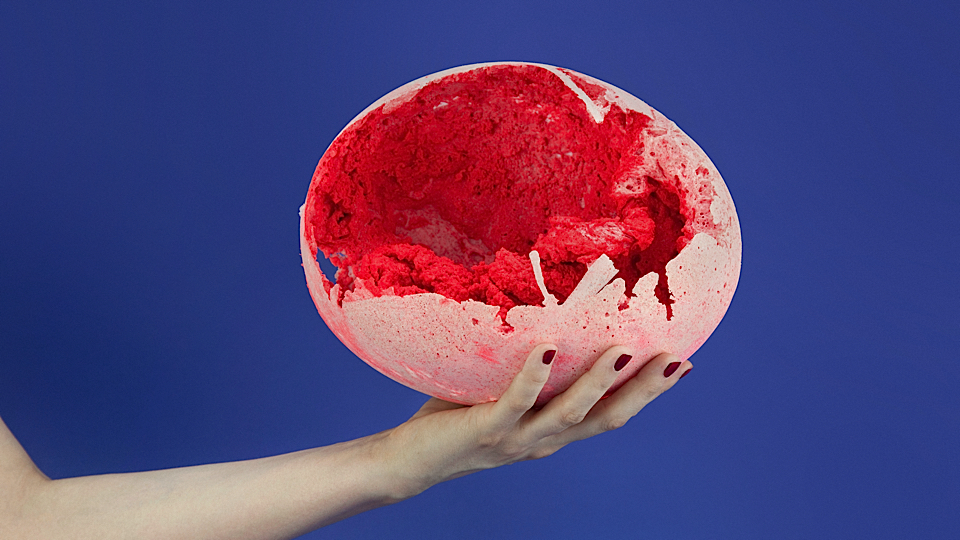
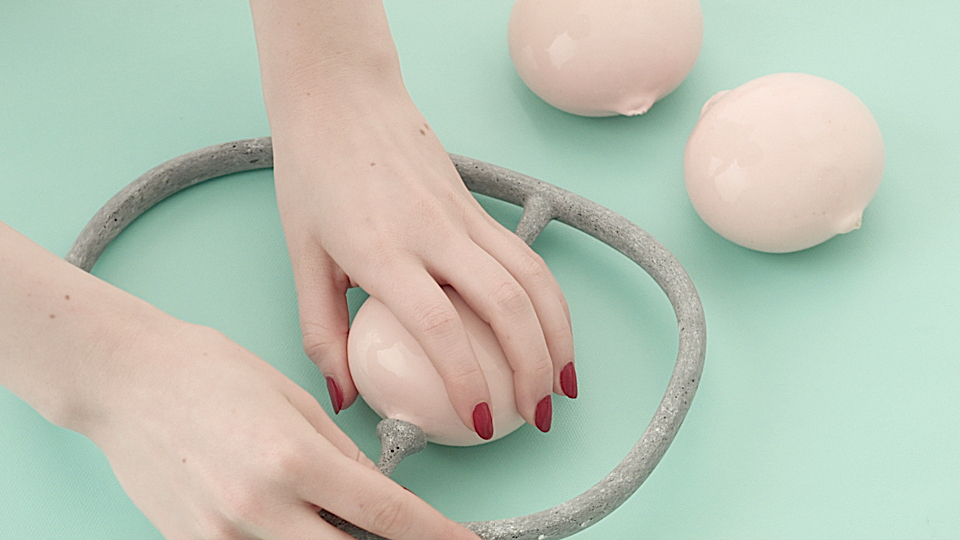
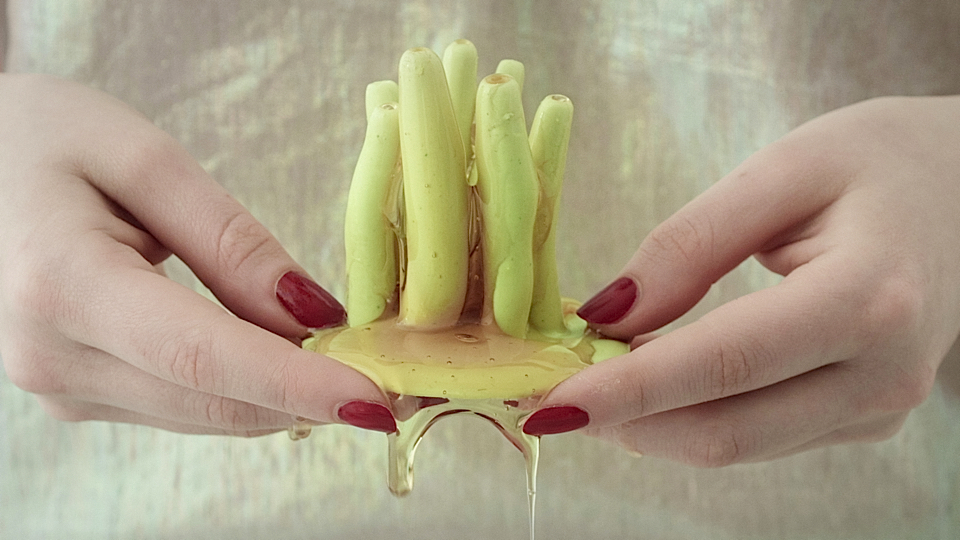
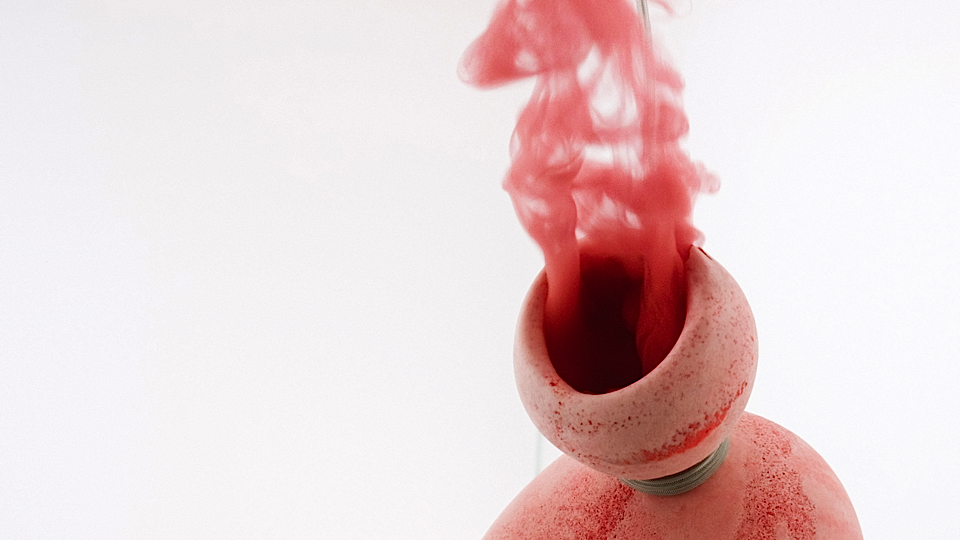
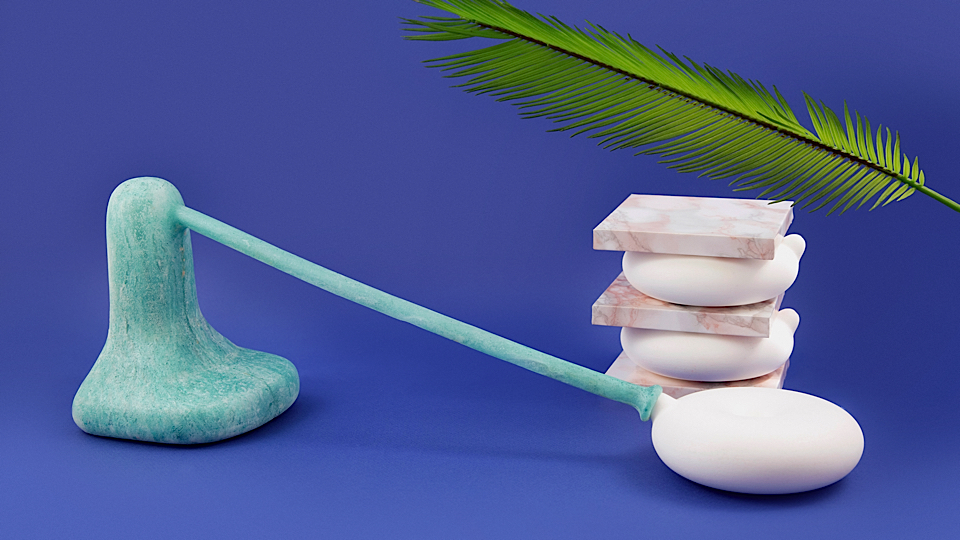
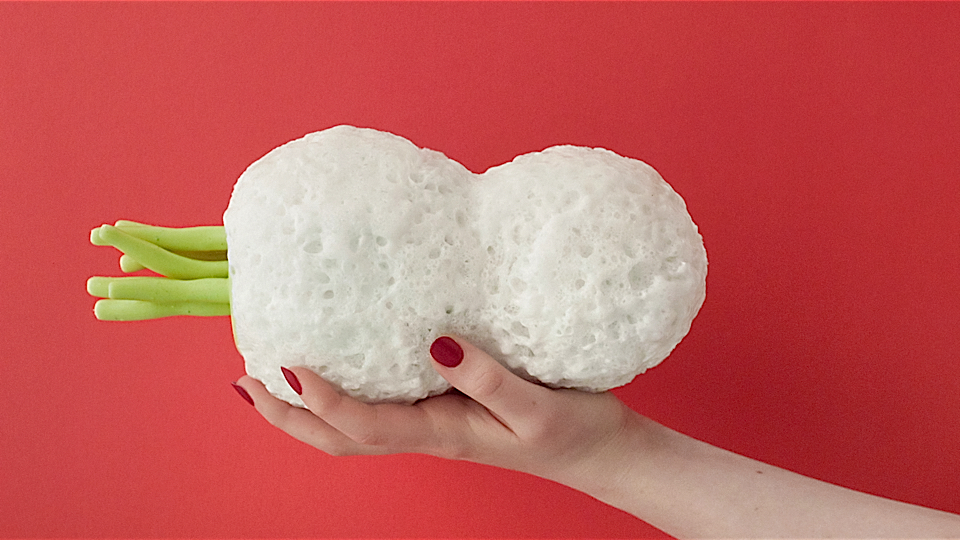
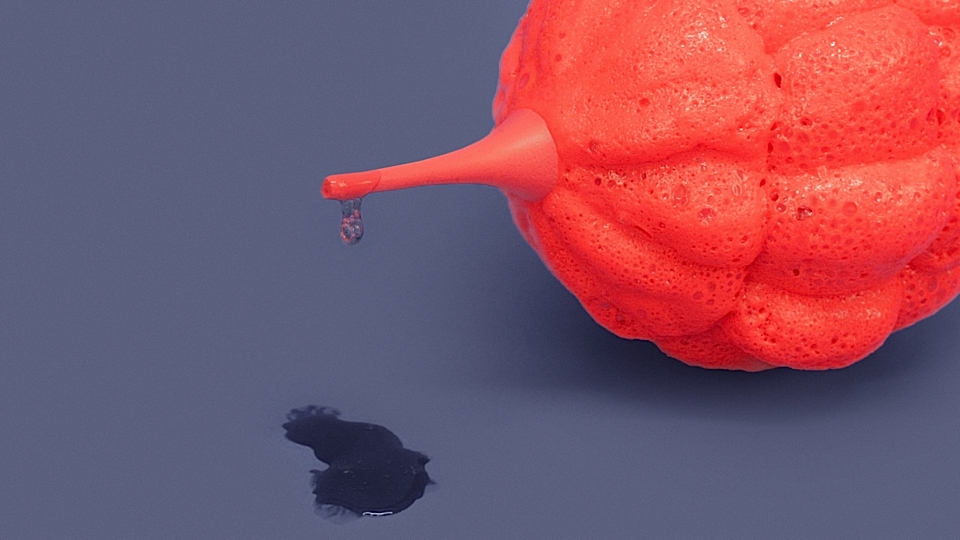
fungus inhale vaccination
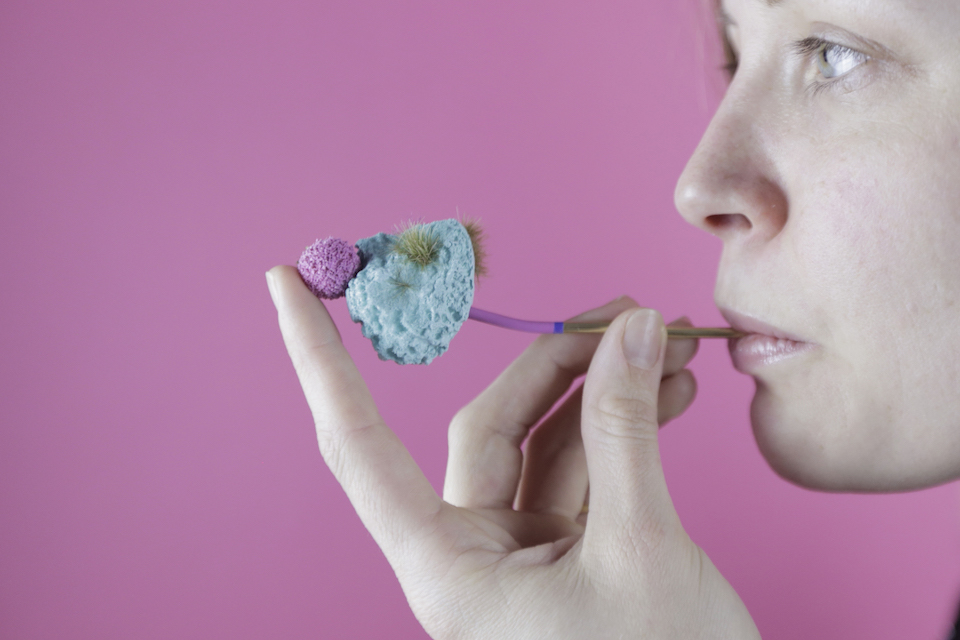
Céline Park’s conceptual Fungus Inhale Vaccination project imagines impregnating the fungi with weakened viruses, allowing its spores to carry vaccines into the bloodstream through the lungs using an inhaler.
The weakened virus would be attached to the fungal spores – the microscopic particles that allow the fungi to reproduce when they detach from the parent organism.
To demonstrate her ideas, the designer created a series of fantastical coloured inhalers. The fungi are attached to the ends of pipes, which contain filters to catch unwanted particles as well as providing mouthpieces.
What is your up bring? Where have you lived? How old are you? How does your international background benefits your knowledge in design?
I was born in Seoul, South Korea and moved to France when I was 14. I lived in Vancouver, Canada, NYC, USA, then moved back to Seoul for a couple of years and I finally settled in London to go to grad school. Now I’m 29. I remember saying that I wanted to become a designer or an artist when I was 3. Drawing and making creative artwork has been an utopian world since then. I studied Art and Design throughout my life. I would say that it was almost the only thing I was passionate about. Although my knowledge of design is will never be enough for me, I am always craving to create more creative things.
How did you become interested in the Health industry to the point of developing this project?
My father is an eye doctor, I grew up seeing lots of eye surgery videos. I always wanted to connect design to science. I was lucky taking lessons from Anthony Dunne who used to be the head of the programme of the study I do, Design Interactions at Royal College of Art. He encouraged me to do a synthetic biology project.
How does the fungus inhale vaccination work?
Vaccinations can be inhaled when it is attenuated in fungus. Our fine structure of lung is one of the most well-developed part inside our body. Therefore, it can efficiently transport the drug when we attenuate the non-drug magnetic polarities: we can transport it without the pain. Today, the medical community is using multiple types of inhalation medicines for the asthmatic patients. Many scientists are constantly trying to innovate, by inhaling insulin instead of hypodermically injecting inhalation every hour. Besides the fact that we can gain better immunity system with inhale vaccination, another benefit of having it is that it can easily transmit to surrounding people so they can easily get herd immunity as well (just like flu or pneumonia). Mould spores are very easy to be transported to our lung through respiratory organs. It can get easily absorbed from alveolar-capillary, then it will pass through the heart and finally transported to the circulating system of the entire body.
Why is it better than today’s regular vaccination?
First of all, there is nothing like inhalable vaccine delivery methods that has been yet discovered.
Secondly, it is because fungus has so much potential that it works incredibly better than regular inhalable vaccine. For example, fungus has ability to contain as many vaccine as we want in a small amount (of fungus). Also, it is easier to transport and spread out in our body through inhalation, when the attenuated vaccine is absorbed in fungus.
Each strains of fungus has its own specific preferential organ. Therefore, we can easily transport vaccine to target an organ like the lung or bronchus. Moreover, inhalation vaccine can easily achieve herd immunity like many other air-borne fungal infections.
What type of fungus do you use? What are the misconceptions people have about fungi? Do they present any risk for the patient?
Fungus like cryptococcosis, coccidioidomycosis, histoplasmosis, pneumocystis pneumonia can cause fatal infection to HIV/AIDS patients, as they have compromised immune system. However, it will not cause any problem for the regular people even though they get infected. Moreover, if regular people get infected, its strain is quickly responsive to the anti fungal. Also, there are advantages of some fungus for pneumocystis: the infection occurs optionally only on alveolar corporate, so we can choose a particular part to efficiently transfer the vaccine. Therefore, I have tried to use fungus for the carrier of the fungus inhalable viral or bacterial vaccine.
What challenges will medicine face in the near future and how do you imagine we could tackle some of them?
Lots of scientists are now facing the limit of creating more innovative medicine as most of the research we need to survive has been discovered. This issue will become more serious, and scientists might research it for their papers for their degrees, and not to make an advanced step in the medicine community (which is happening even now).
What role will design have in this future?
I think designers have lots of creativity but have less knowledge in most of fields like science, politics, etc.
If designers get more chances to collaborate with scientists, politicians.. I think we, designers, might be able to proceed more advanced solutions or progress in each field with our open-minded creativities.
What does the future hold for you? Any areas you would want to explore?
I’m currently focused on the subject, freedom, and I’m trying to find out how I can explore it through playwrights, choreography, and synthetic biology.
Lydia Janis Caldana
www.celinepark.co.uk
Lydia Janis Caldana is a trend forecaster with a creative background and both eyes on the future. Amazed by the opportunities new technologies bring at an exponential rate, she uses her abilities to predict movements and change to help companies, governments and disrupters be in charge of a more sustainable, inspiring and tech-solutioned world. Lydia keeps a blog about technology, is the LatAm correspondent for The Future Is Already Here, a think tank for a better world, and co-curates Ello’s official community about tech, culture and innovation, Ello Future.
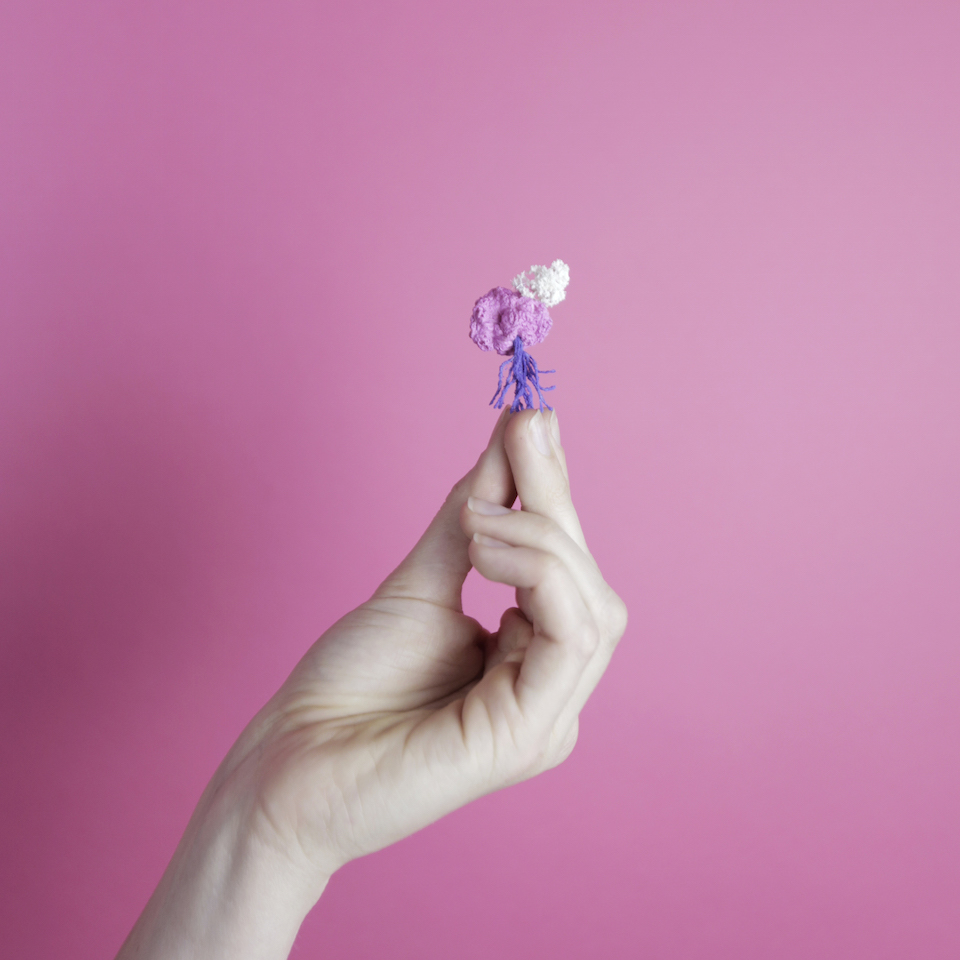
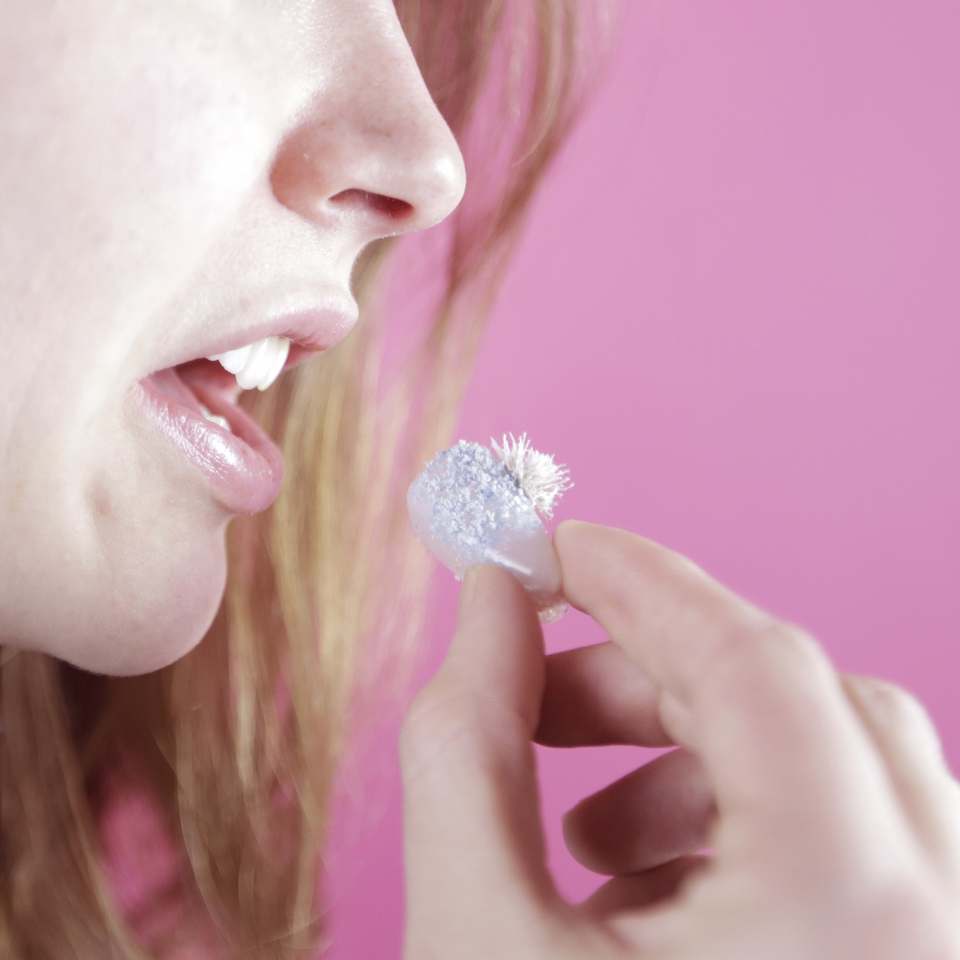
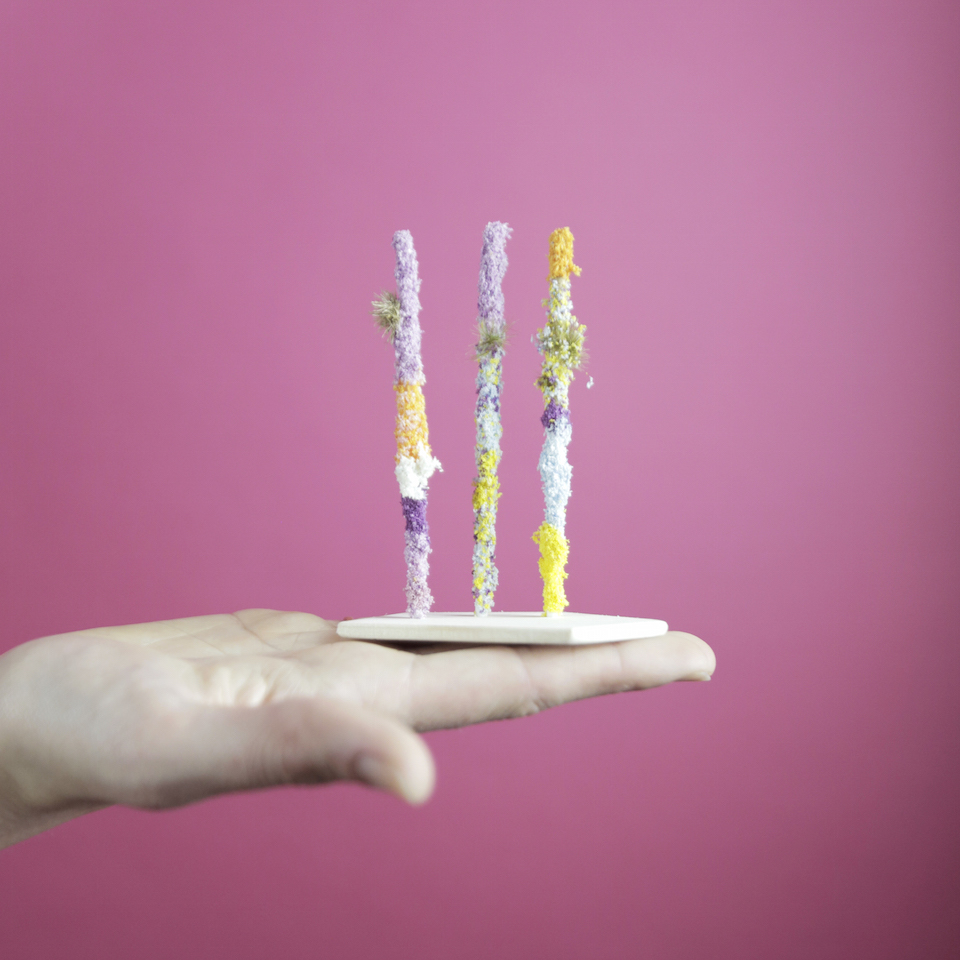
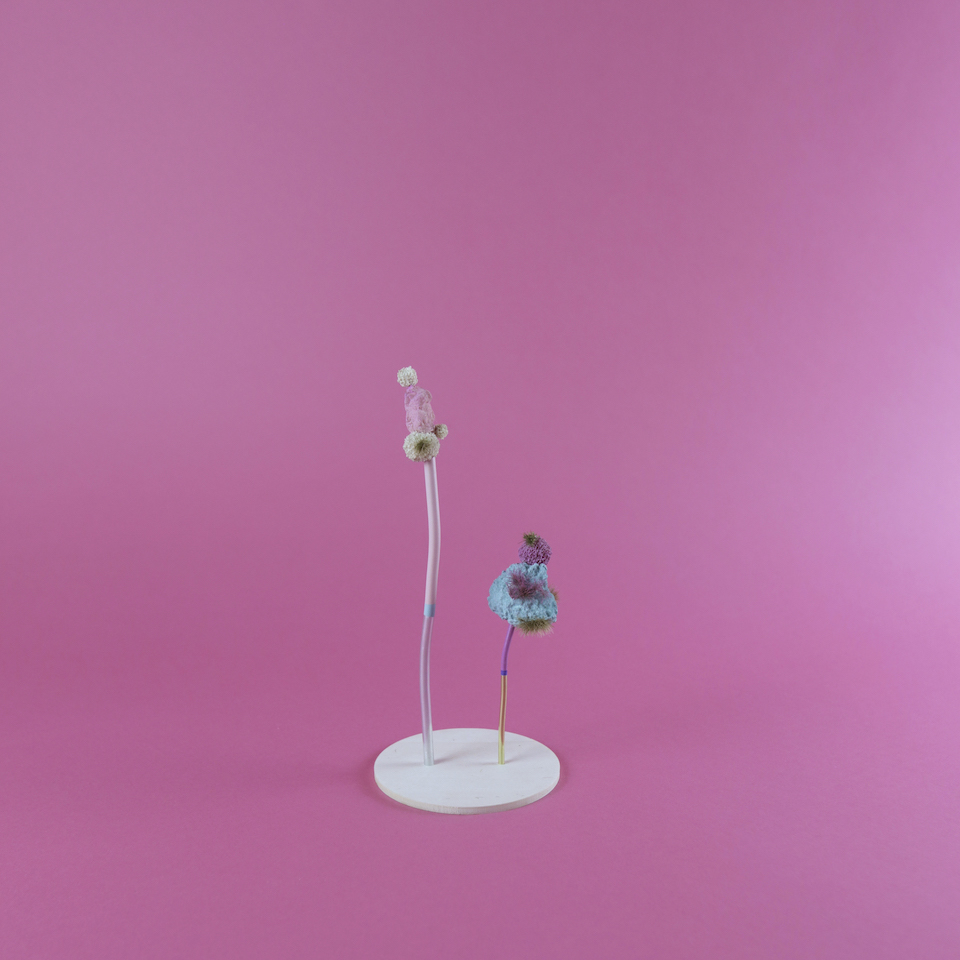
living things
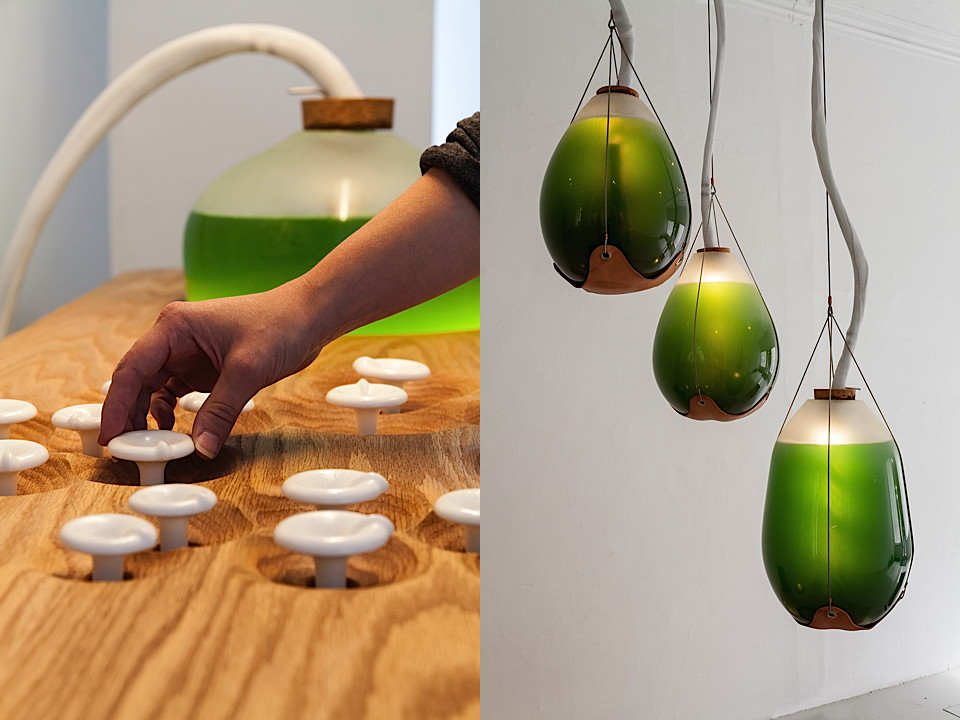
‘Living Things’ is an installation that explores the « symbiosis between human beings and microorganisms externalized and celebrated in the built environment » through photosynthetic furniture.
Micro algae present a unique opportunity to designers. Since they lack superstructure and are found in liquids, becoming a ‘liquid plant’, they become a living material which can be integrated symbiotically into the architectural environment. The home of the future could see algae as a sustainable solution for the increasing human-generated pollution and waste.
« The plasticity of this living material allows us to create living structures. These living structures recycle light, heat, and carbon dioxide from buildings and their inhabitants into rich green biomass which can be consumed as sustenance, used as agricultural fertilizer, or converted to biofuel. This installation reveals the phenomenological qualities of the highly beneficial micro-algae and challenges visitors to consider what the future of the domestic environment may become in the context of the precarious agricultural and energy needs of a ballooning population.
The three vignettes; a living room, a dining room, and a kitchen/control center each espouse a different character, and the living vessels function differently in each space ».
Living Things is now installed in the Mattress Factory, Museum of Contemporary Art in Pittsburgh, Pennsylvania until March 27, 2016.
Lydia Janis Caldana
Photos courtesy of the Mattress Factory - photos Tom Little & LLC
Lydia Janis Caldana is a trend forecaster with a creative background and both eyes on the future. Amazed by the opportunities new technologies bring at an exponential rate, she uses her abilities to predict movements and change to help companies, governments and disrupters be in charge of a more sustainable, inspiring and tech-solutioned world. Lydia keeps a blog about technology, is the LatAm correspondent for The Future Is Already Here, a think tank for a better world, and co-curates Ello’s official community about tech, culture and innovation, Ello Future.
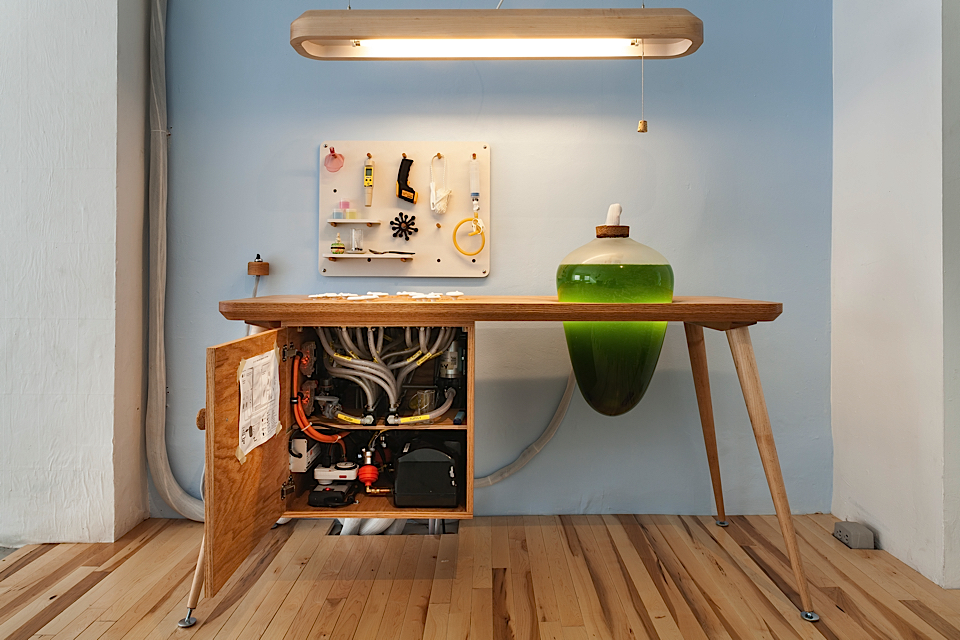
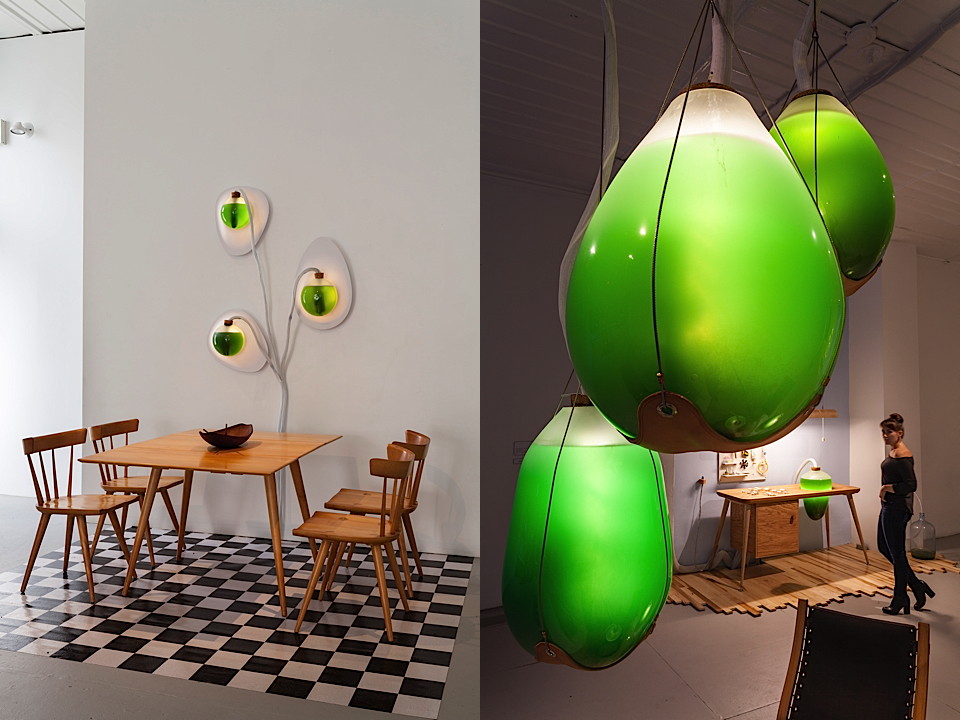
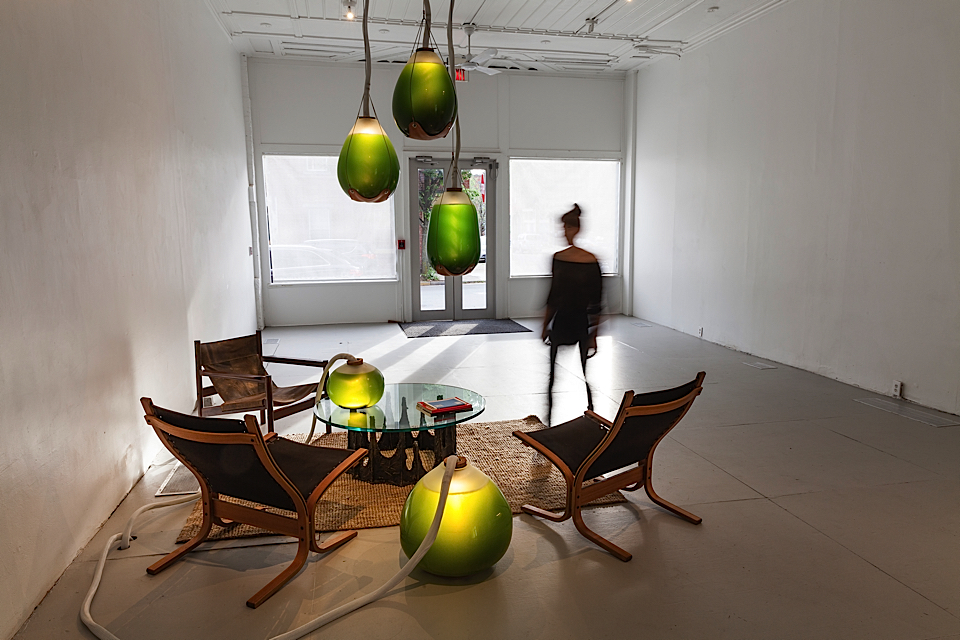
abstract
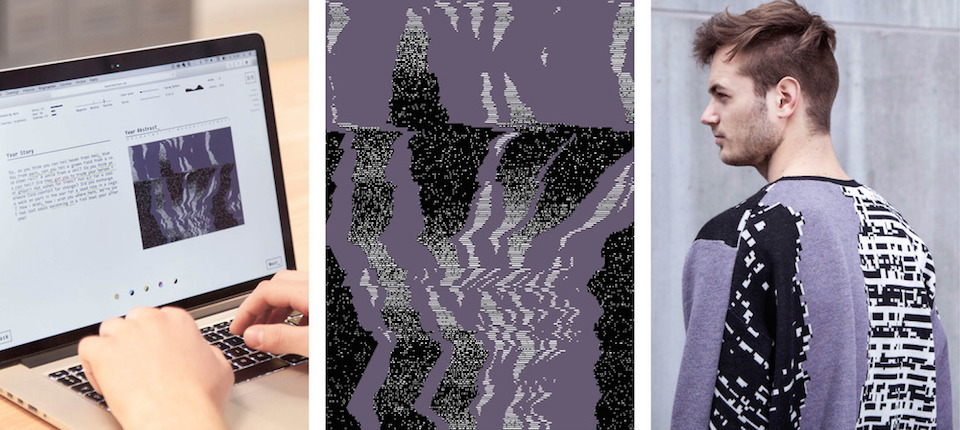
“Use the best possible materials and reveal the qualities of those materials and the craftsmanship their assembly”. One of the most prestigious German architect and designer, Karl Friedrich Schinkel said exactly that. If it wasn’t for the fact that he lived in the 19th century, one could have thought he was speaking about a design project called ABSTRACT_.
ABSTRACT_ is the latest project of an ambitious Danish collective of future thinking designers. Bjorn Karman (technology), Kristine Boesen (textile) and Julie Hells Eriksen (fashion) developed ABSTRACT_ as a co-creation between fashion, textile and technology. Although the excellence of this project might make you expect differently, ABSTRACT_ is actually a collaboration between three design students as part of their Bachelor education.
This customizable fashion project, where by software program transforms text and emotion into textile patterns, creates the ultimate personalized design pieces. The vision of the three young designers behind this endeavour holds that they believe nowadays consumer’s interest lies in unique and personal products in combination with authentic experiences. ABSTRACT_ offers his users these sole experiences by letting them personally connect to clothing.
The software can process and analyze the rhythm and meaning of what the customer writes on their keyboards. The facial expressions are being analyzed by webcam before these personal emotions are being translated into design. Users get their own emotion as a pattern in a piece of clothing and therewith can tell their own story making this piece of fashion of very high personal value.
Our appearance is on of the most important ways of externally express who we are, our personality and our style. It is our way to stand out and to tell our story and ABSTRACT_ offers a stunning way of truly telling it. Moreover, the designers believe that this personalization of products could lead to more sustainable use of materials as people might care more about their products if they have an emotional connection with it.
ABSTRACT_ is an absolute stunning collaboration focusing on the different strengths all the professions have to offer. Answering to our current personalization trend perfectly while embraces our emotion economy by giving consumers the opportunity to add value to their garments. This project shows us that it is not so much about the products we buy but about the story it can help us tell, and that is absolute priceless.
Cecile Cremer
Extremely curious and always searching for little weak signals that tell us things are changing. Cecile is a trend researcher and creative concept developer with the wanderlust of a cosmopolitan.Her aim in life is to develop things that matter to others and to help others change their strategy to be ahead of the future. Because she believes “The future is ours”.





a talk with mathieu lehanneur
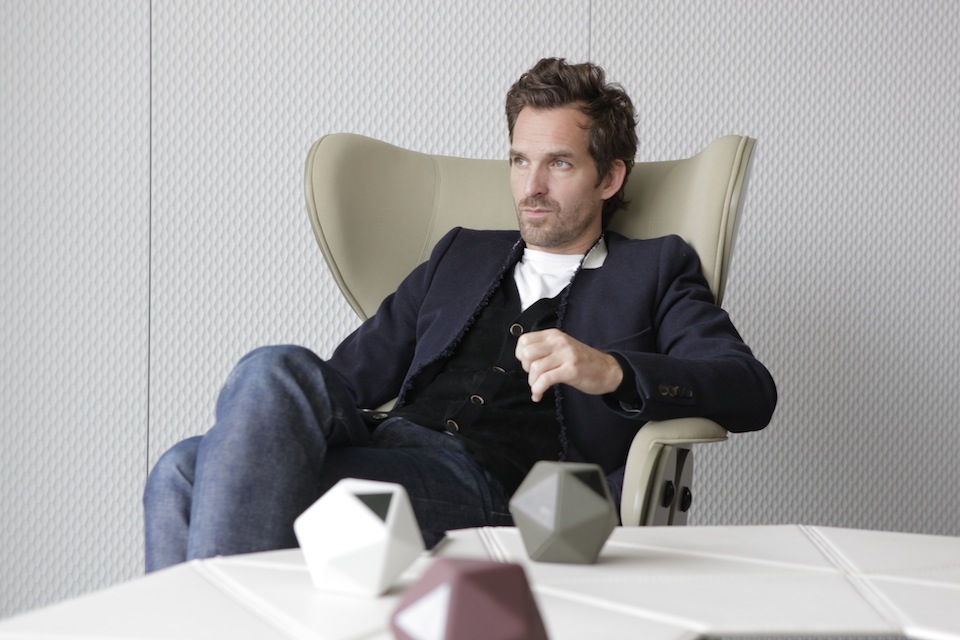
mathieu lehanneur photo by gautier billotte
When you buy a device very often several months later there is a newer and cooler version. Instead of evolving with us, our devices become obsolete.
Boom Boom is the first evolving wireless speaker. Dreamt up by a young audio company called Binauric and designed by the talented Mathieu Lehanneur, Boom Boom comes with all the basic features you should expect: audio playback, conference call capabilities, compatibility with all smartphones and computers, the option to sync up two speakers.
The speaker is loaded with excess components like an accelerometer, light sensors and microphones that allow the device to take on new functionalities as they will be developed. Just like sleeping components that are waiting to be woken up. The built-in technologies are there so the speaker can acquire new features without needing new parts.
Boom Boom is "as evident and magical as fruit. I wanted a portable speaker to be as simple, instinctive and desirable as an apple freshly fallen from a tree. A sound object ready to be grasped,” summarises Mathieu Lehanneur. No top, no bottom, perfect ergonomics requiring intuitive handling, Boom Boom speaks to you in your language and with multiple voice intonations: ” An object has never addressed you so well before!” laughs Lehanneur.
Binauric just roll out a new smartphone application that enables 3D sound to be recorded at home or on the move. You can now record voices or your surroundings : the speaker becomes a recorder, capturing unique sounds on your smartphone by means of a panoramic recording method.
The advent of social networks has given rise to a predominance of looking over listening through the prevalence of photo and video sharing. A new era has just begun where top quality sound is as appealing as pixels.
Cecile Poignant, our editor, had an exclusive Q&A with Mathieu Lehanneur :
Today the approach of the world is mainly visual. Do you think that other senses such as hearing and smell could be more important in the near future?
The visual, and the movie industry helped it, took a prominent place in our lives. When a sense takes power it is at the expense of others. We got to a point where the view will not go much further in what it can bring us even if the technology is still growing. The question of the other senses now arise because we know their evocative and emotional power. Our goal is to live more total experience. Sound is obviously one of them and it is a poor parent. A world is opening to us with the knowledge of the brain. We learn every week more on how this large organ manages and generates all these sensations. I am very excited, happy and inspired to live in this time-depth knowledge of the human body.
Is sharing a value that inspires you?
Sharing is like a gift, if you stay in the abstraction everyone is for. What matters really is what you have to give me. Today we live in a world through social networks where sharing is not a true sharing but just the proof of what I have lived. It is much more narcissistic than truly generous.The platforms allow you to send things but it is a little vain. What I really want is to give you a bit of emotion that I have lived intimately : a place, a music, an emotion. The sound dimension will allow you to live a part of what I experienced. This is more generous.
You recently opened the Café ArtScience in Cambridge, Massachusetts in collaboration with American scientist and Harvard professor David Edwards. How do you assemble Art & Science ?
The whole history of Arts and Science has shown a lot of links . Scientists and artists have surprisingly a capacity to understand each other.The idea is to provide a place for these two universes. We start first with Le Laboratoire in Paris. It is called a laboratory as failure is part of the experience. The Café ArtScience is located between MIT and Harvard. Here there are brains and startup and yet no place offers a platform for meeting, exhibition, experience ... This new place will try to blur the boundaries
What object do you dream to invent?
Not so long ago, I asked myself which object I was particularly jealous of. There are two, the escalator which is an object that I like very much because it is absolutely surreal. Imagining a staircase that is the form that is the more static and make a moveable object is absolutely poetic. It is also a great feature which revolutionized architecture. It has already been done and I'm a little jealous. The second object is the airbag. I am very jealous of the airbag I would have loved to invent it. It is somehow like a toy: I'll save lives by inflating balloons! This is something of a simplicity of an intelligence, a minimum of means and a total efficiency. Those two objects I did not invent them so I am working on the third one.
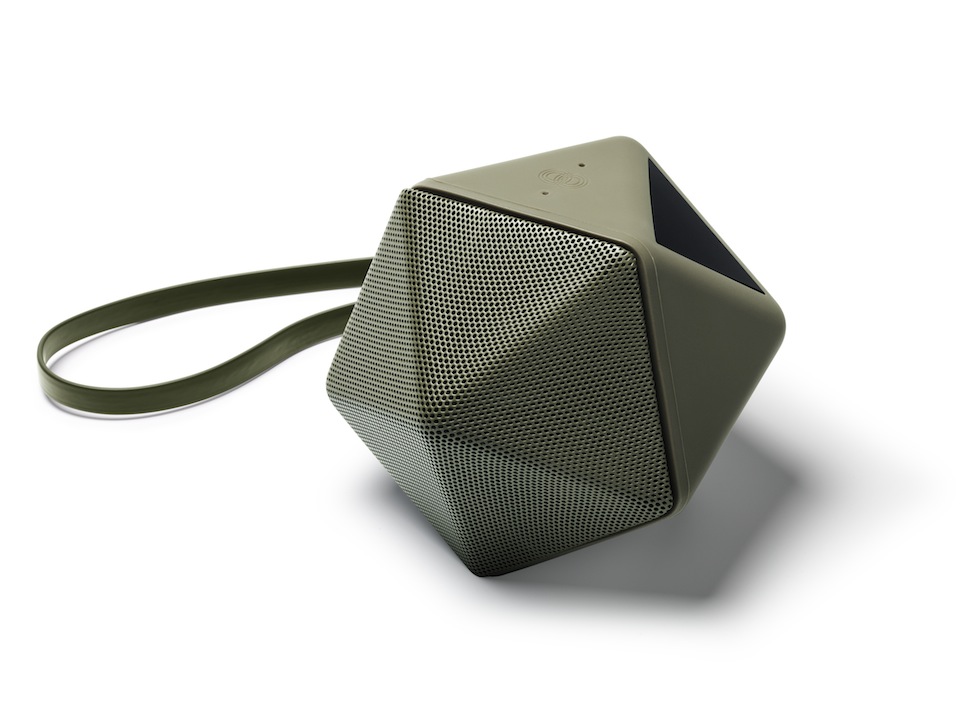
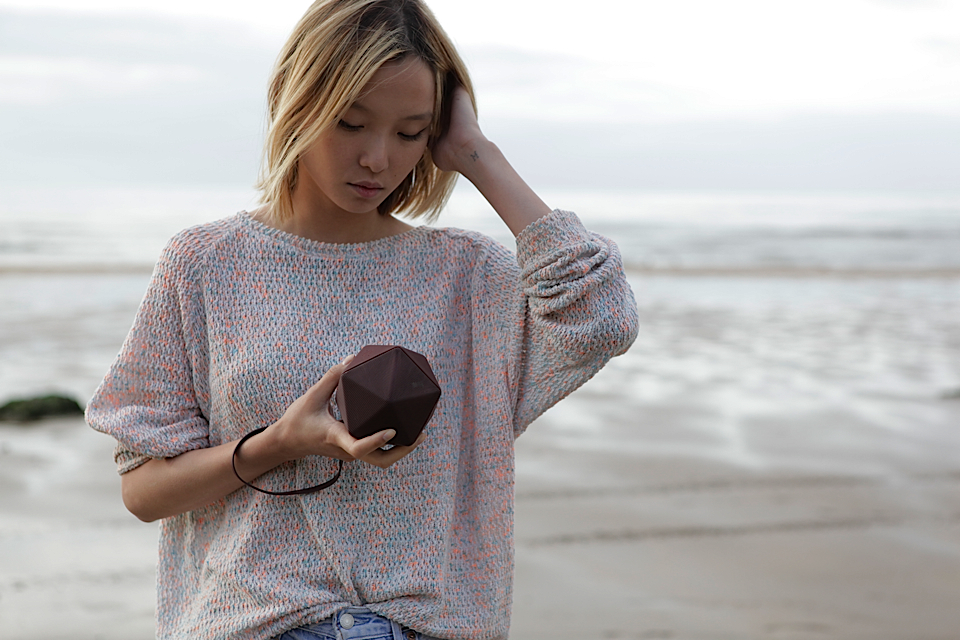
photo by Gaultier Billote
poetic innovation
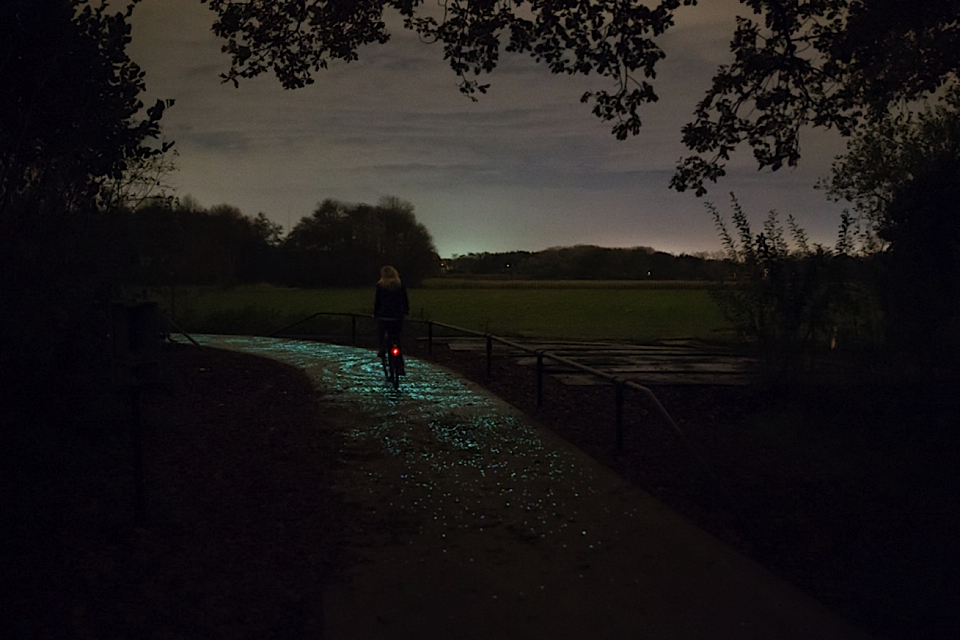
photo courtesy studio roosegaarde
Daan Roosegaarde’ s goal is simple: “I’m a voluntary prisoner of my own imagination, and I want to update reality,” he explained in a fascinating interviewwith The Creators Project. His interactive designs are tactile high-tech environments. ’Techno-poetry’ is the word Roosegaarde uses to describe the connection, between ideology and technology. His work is changing the way we perceive the world by playing at the boundaries of analog and digital.
Studio Roosegaarde his design lab, recently conceived Smart Highway and team up with the Dutch construction company Heijmans to realize the first interactive road of tomorrow. This smart road use light and road signs that interact with the traffic situation to provide us comfort and safety.The Glowing Lines charge at day-time, and glow at night for eight hours. The first road has been realized and more will come.
Vincent Van Gogh Masterpiece “The Starry Night” is the inspiration behind the design of a glow-in-the-dark bike path in the Netherlands.The trail extends between Eindhoven and Neunen where Van Gogh spent part of his life. The trail’s opening marks the launch of the International Van Gogh 2015 year, which will celebrate the 125th anniversary of the artist’s death.
And, it is just incredibly poetic!
Cecile Poignant
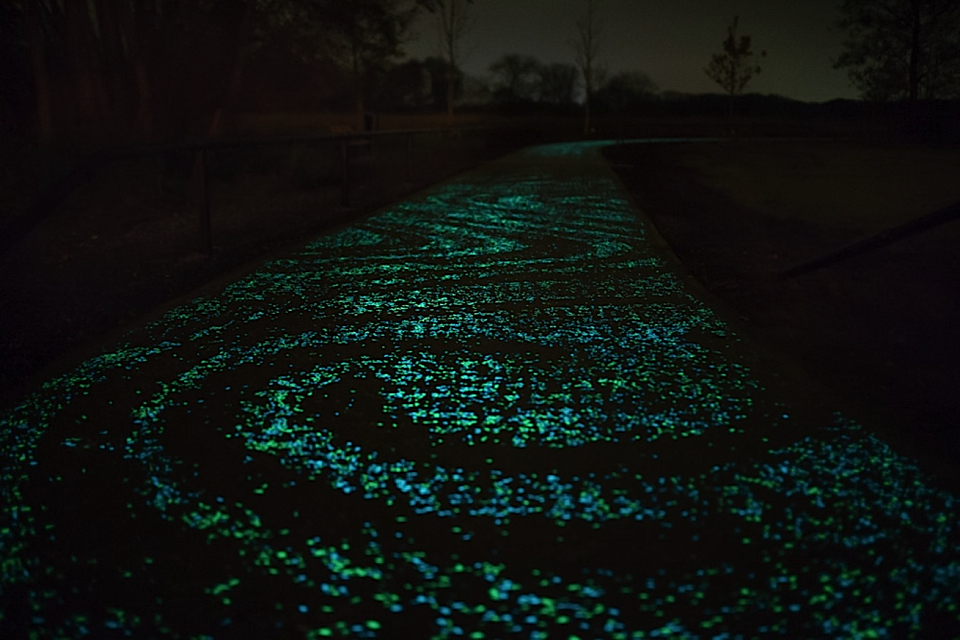
photo courtesy studio roosegaarde
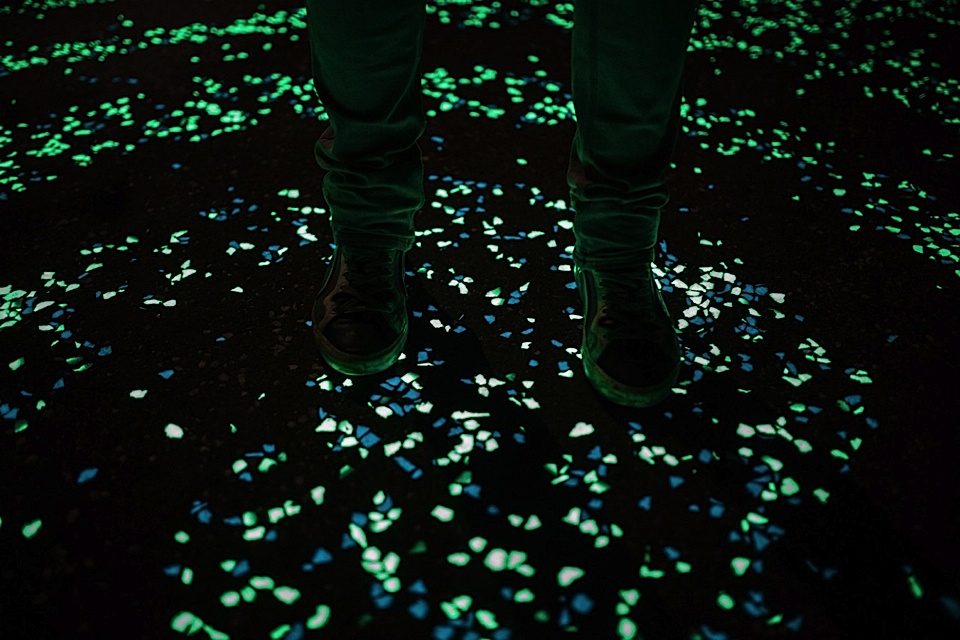
photo courtesy studio roosegaarde
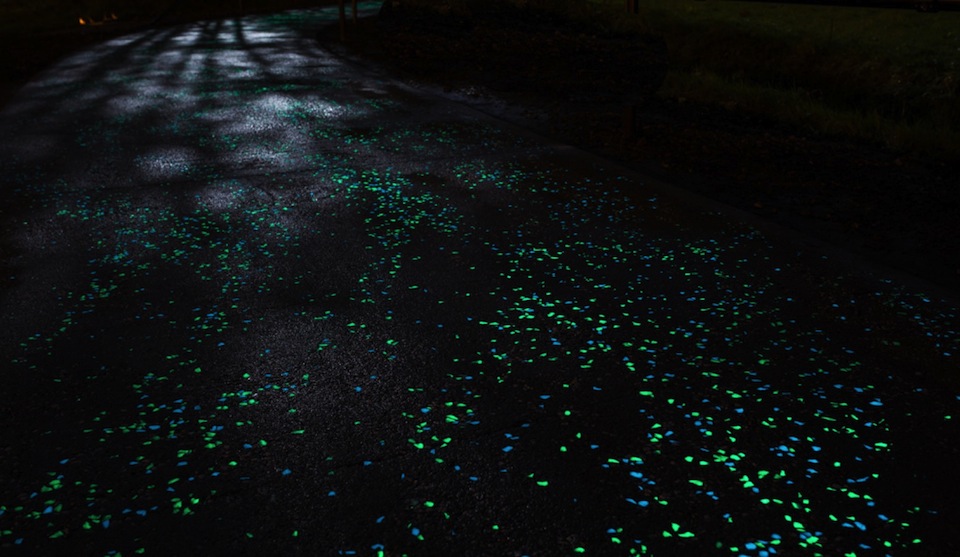
photo courtesy studio roosegaarde
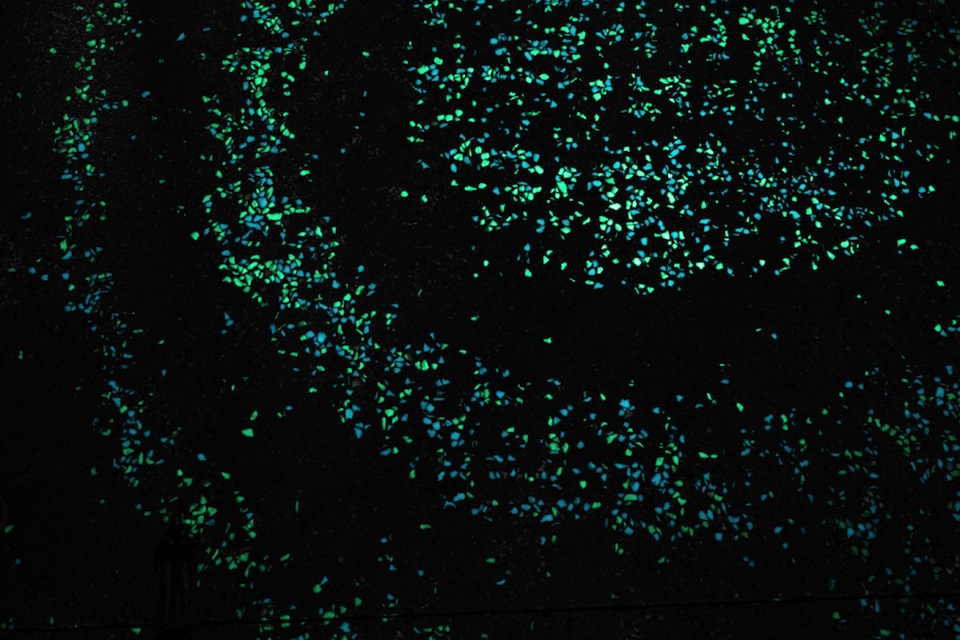
photo courtesy studio roosegaarde
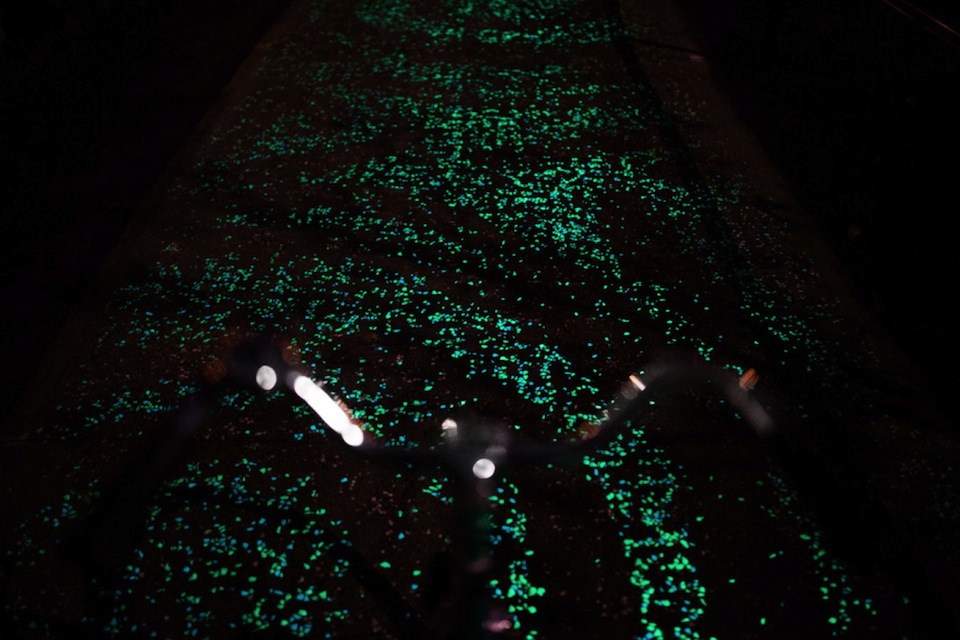
photo courtesy studio roosegaarde
vocal vibrations

photo by Phase One Photography
"Vocal Vibrations" is an installation which invites the public to discover the relationship between sound vibrations stimulated by voice and their effects on human physiology. It's a sensory experience, an initiatory journey and an interactive path to follow.
Tod Machover, composer/ inventor and Neri Oxman, architect/designer, both from MIT Media Lab, are exploring the question of the voice and its impact on the body. “We know that health has an impact on the voice. Conversely, can the voice affect our physical and mental conditioning?” For this exhibition, William Boujon & Julien Benayoun, the creative duo of Bold-design, imagined the scenography at Le Laboratoire. Opened since 2007, Le Laboratoire is a contemporary art and design center in central Paris, where artists and designers experiment at frontiers of science; an extraordinary place founded and directed by David Edwards.
First, Bold-design created a meditative chamber, a kind of chapel, into which visitors enter. They hear a meditative, multilayered composition by Tod Machover that weaves together multiple voices and other sources in a transfixing sonic journey. Visitors can stand, sit on a carpet or pillows, and listen carefully – concentrating on a single meditative tone surrounded by evolving textures, before they are invited by a guide to enter into a preparatory tunnel.
The tunnel alternates between transparency and translucency that changes as the visitor moves, until entering a central space. This tunnel is both visual and sonorous, made to enhance a sense of isolation, and yet freedom.The visitor is encourage to enter into a unique vocal experience, with his own voice, clasping the ORB.
The oRb, designed by bold-design, was imagined by Tod Machover and David Edwards in a conversation in late 2013. Since then, Tod Machover and his students at the MIT Media Lab and bold-design in Paris have developed the oRb.This magical sphere is central to Vocal Vibrations . The visitor holds it in his hands, during six minutes he explores his voice by experimenting and interacting with Tod Machover’s carefully customized composition. Every vocal exploration changes the sound and the vibration, allowing the participant to enter in a special meditative relationship with his vocal vibrations. The oRb becomes an incarnation and a materialization of the voice. Bold-design draws inspiration from the symbolism of the stones in a Zen garden. Porcelain, a mineral material, has been chosen for its tactile and vibratory properties.

photo by Phase One Photography

photo by Phase One Photography

photos by Phase One Photography

photo by Phase One Photography

photo by Phase One Photography

photo by Phase One Photography
smart replicas
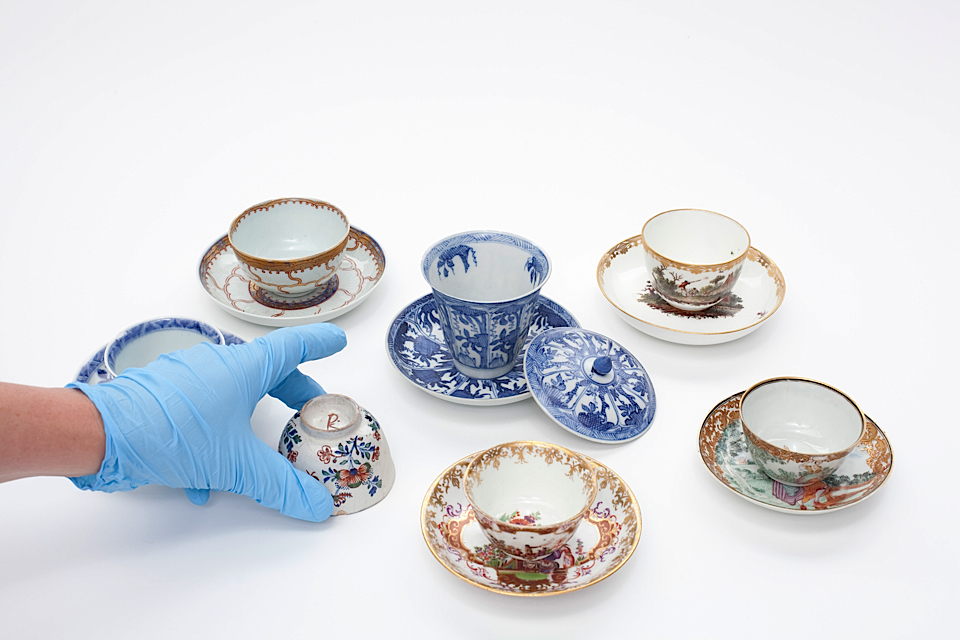
Dutch designer Maaike Roozenburg uses 3D printing to create replicas of antique objects enhanced with a layer of augmented reality information in her SmartReplicas project.
Smart Replicas is made in cooperation with four partners: Delft University of Technology, Faculty of Industrial Design and Faculty of Civil Engineering, Delft Heritage, Department of Archaeology, Museum Boijmans Van Beuningen, the AR (augmented reality) Lab at the Royal Academy of Art in The Hague and students from Graphic Design of Royal Academy. A team of very different parties with their own background and expertise contributed to this project.
“A lot of museums have solid collections of old pre-industrial utensils,” Roozenburg says. “Many of these had the same function then as they do now, but the production process was entirely different. From understanding the history of an everyday object you can tell so much about civilization from the cavemen until now.”Only about 5% of a museum’s collection of tableware is ever on exhibition.
“And even then they are presented in small glass cabinets with tiny pieces of card giving a visitor minimal information,“ says Roozenburg. “It is such a pity because these objects were not made to be shown in a museum, but to be used.”
To combat this Roozenburg uses recent developments in 3d printing to make replicas. “But I did not want exact copies,” she says. “I wanted to use the designs to make new designs.” She created new moulds of old designs.
Smart Replicas is contributing to the accessibility of these museum objects while also increasing our knowledge of these objects.
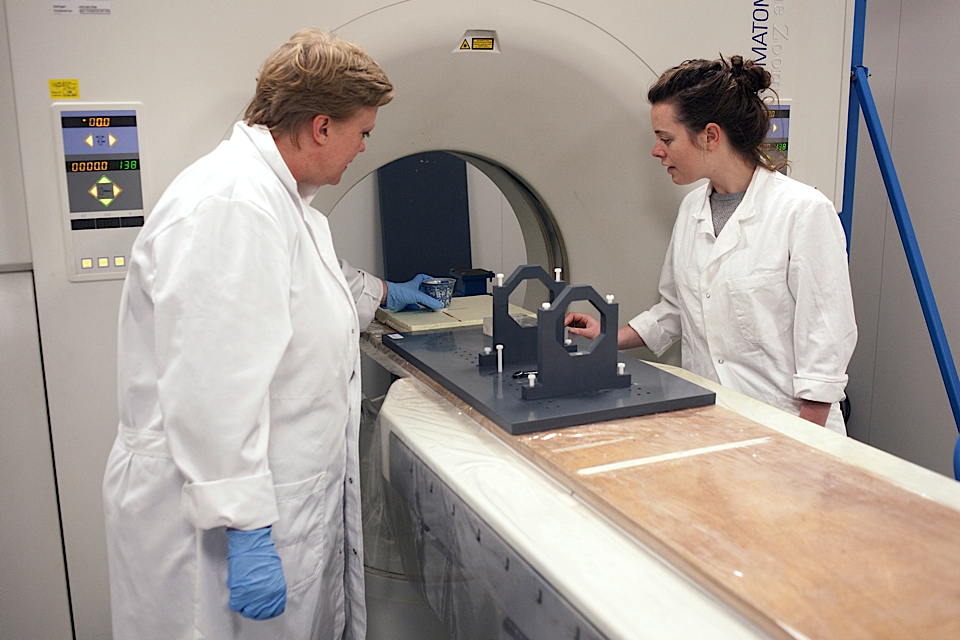
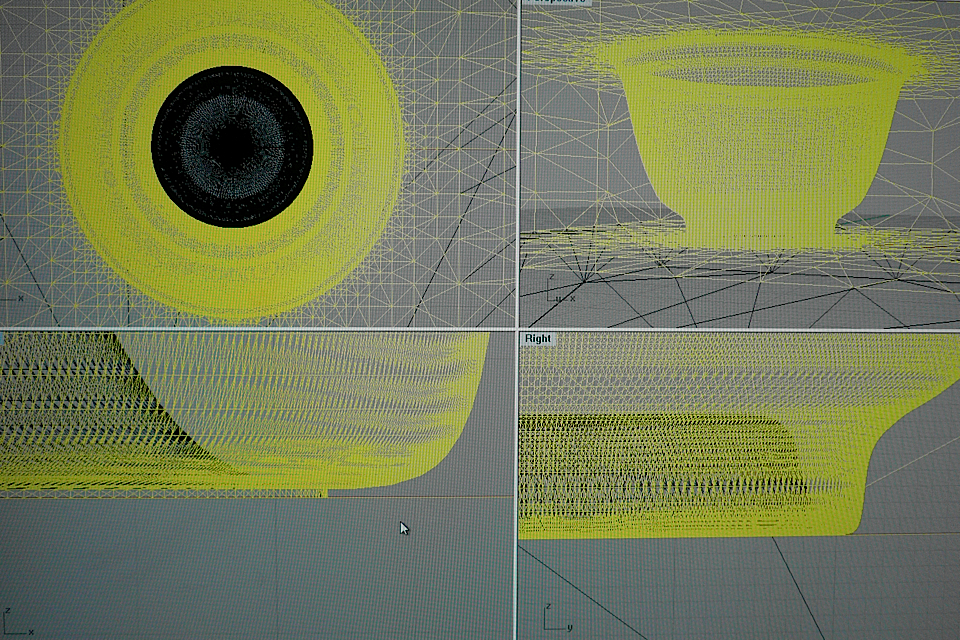
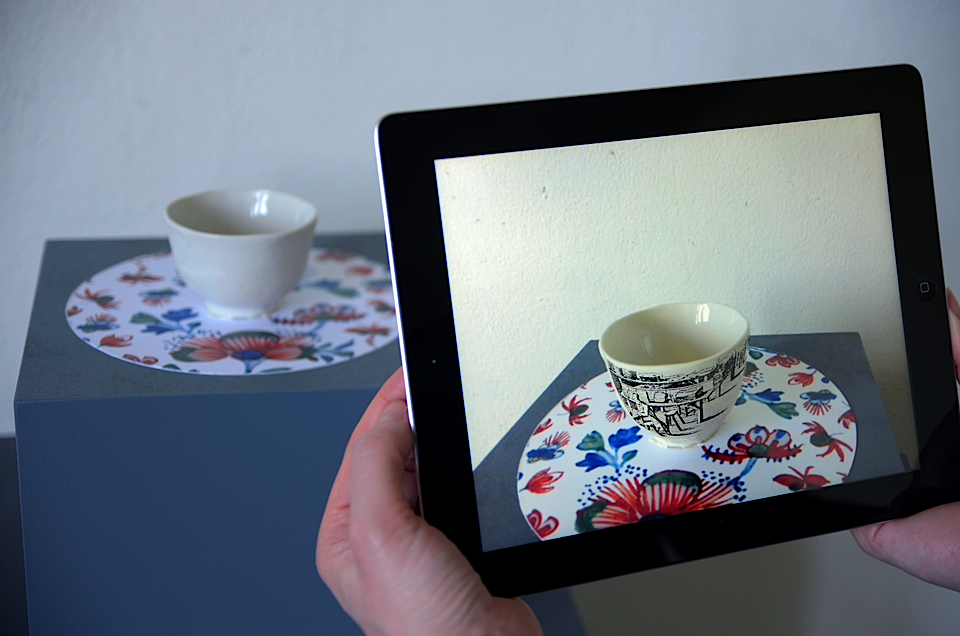
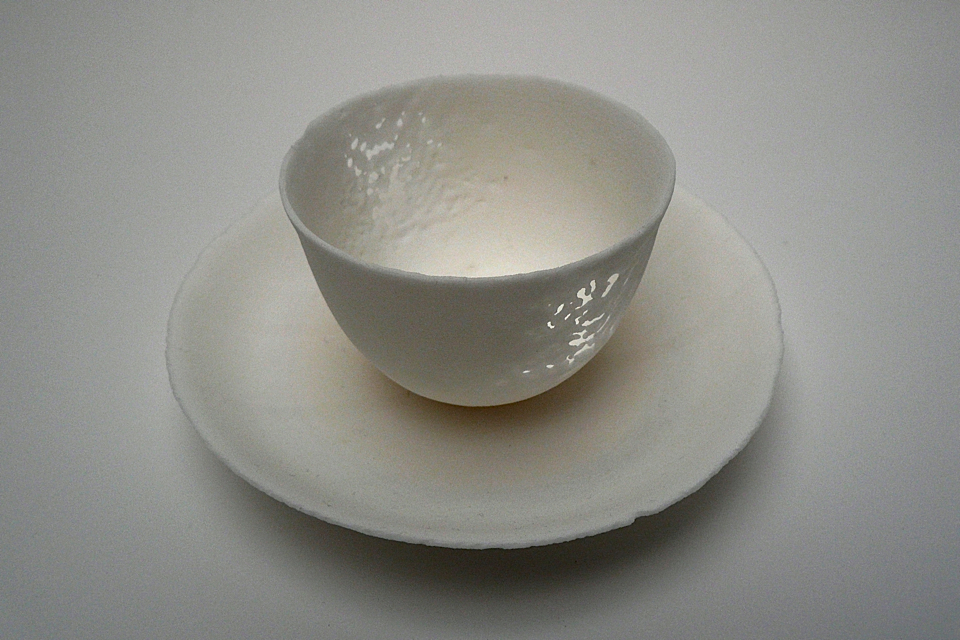
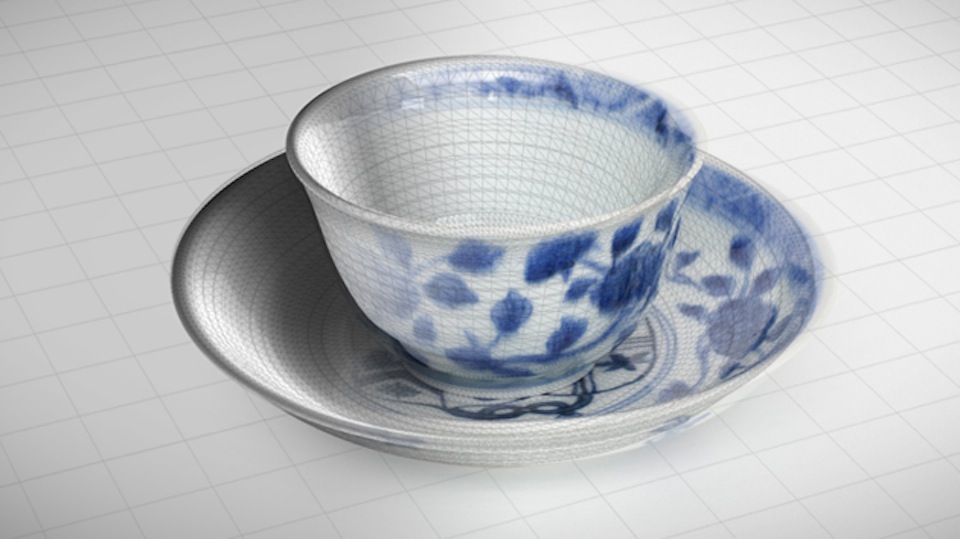
curves
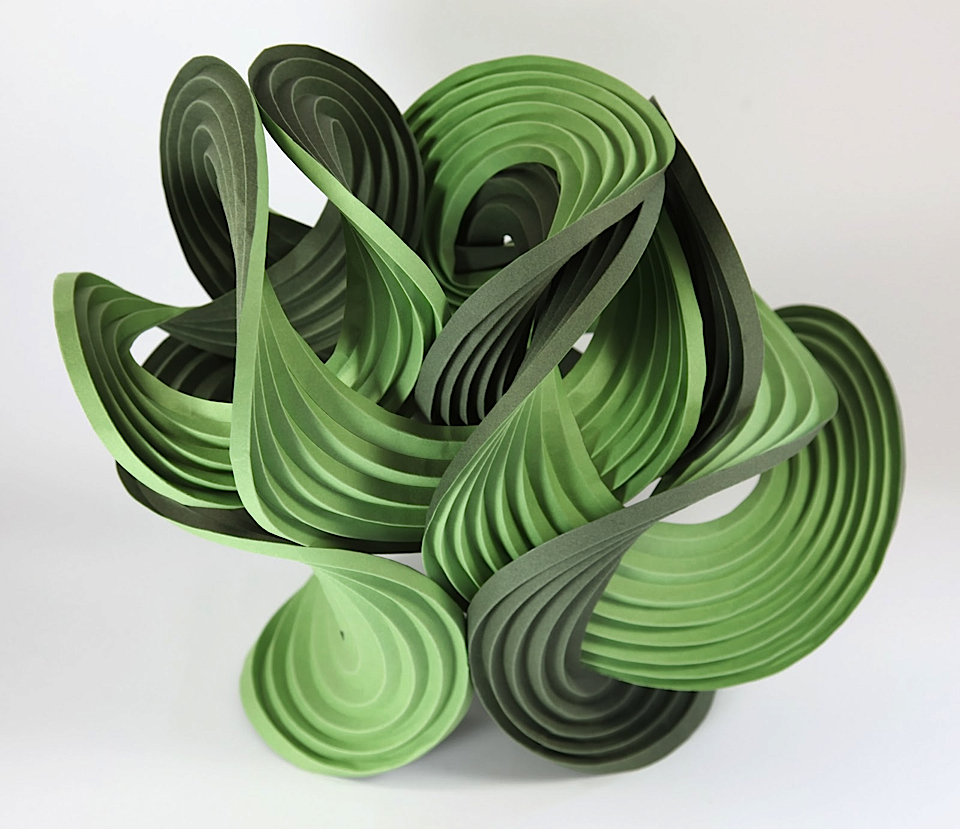
design by Demaine
The shortest distance between two points is a line. Or is it a curve?
Geometry has long been a driving force behind the Issey Miyake line — a brand that consistently blends new technologies with traditional techniques to create its signature style, which could be described as elegant futurism. Look back at the Fall/Winter 2010 show inspired by mathematician William Thurston where creative director Dai Fujiwara paid homage to the beauty of random geometry, even inviting Thurston to take a bow at the end of the show.
Under Miyake's new creative director Yoshiyuki Miyamae the Issey Miyake Fall/Winter 2014 show echoes the flavors and textures of collections past, while using new techniques of hand-pleating on the curve reminiscent in the work of Martin and Erik Demaine.
Martin and Erik Demaine, a father-son duo from MIT and artist in-residence and professor of computer science, respectively, are creating waves that seem to be rippling through the fashion world. The Demaine's combination of applied mathematics and origami (which translates to ori meaning "folding", and kami meaning "paper" in Japanese) results in beautiful complex forms that appear to be undulating in motion while remaining completely static.
The stunning forms that emerge from the mathematical relationships in their work underlies the realization that mathematics is an art form. Their sculptures have been exhibited at galleries and museums around the world and can be found in the permanent collection of the Museum of Modern Art (MoMA). Martin and Erik Demaine were named 2013 Guggenheim Fellows for their origami works in materials ranging from paper to metal, wood and plastics.
One wonders if the Issey Miyake team has been spending time at MIT ?
Alexandra Stein
Erik Demaine & Martin Demaine
Issey Miyake Fall/Winter 2010 show inspired by mathematician William Thurston
Issey Miyake RTW Fall/Winter 2014 images courtesy of Style.com
Alexandra Stein is an artist, illustrator and designer working in book publishing, fashion and beauty in California and New York. You can follow some of her adventures here.
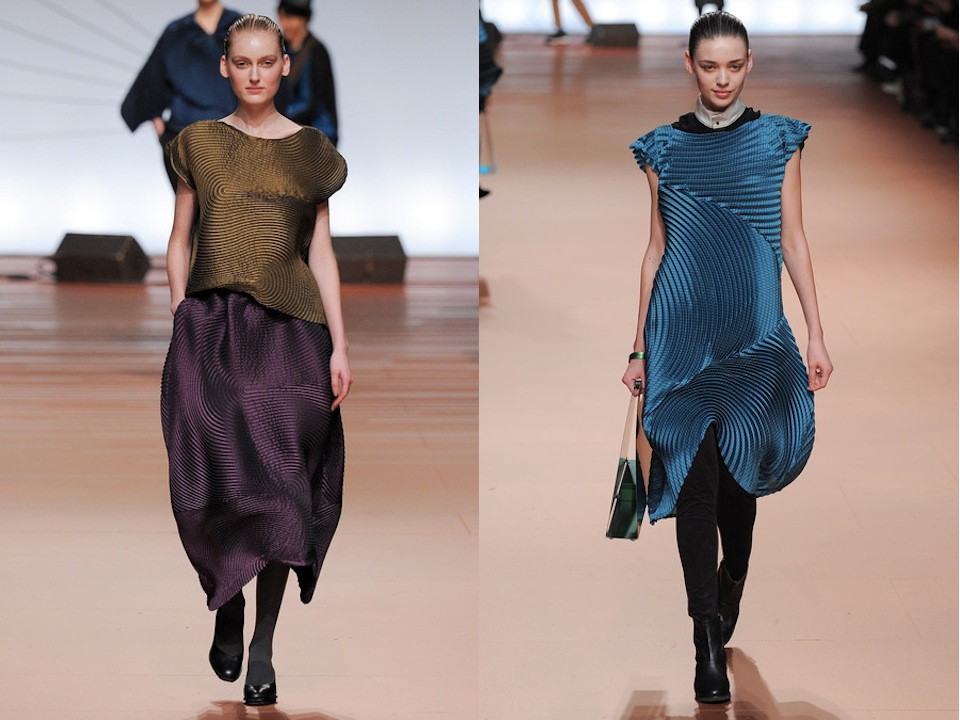
Issey Miyake 2014 - Photos courtesy Style.com
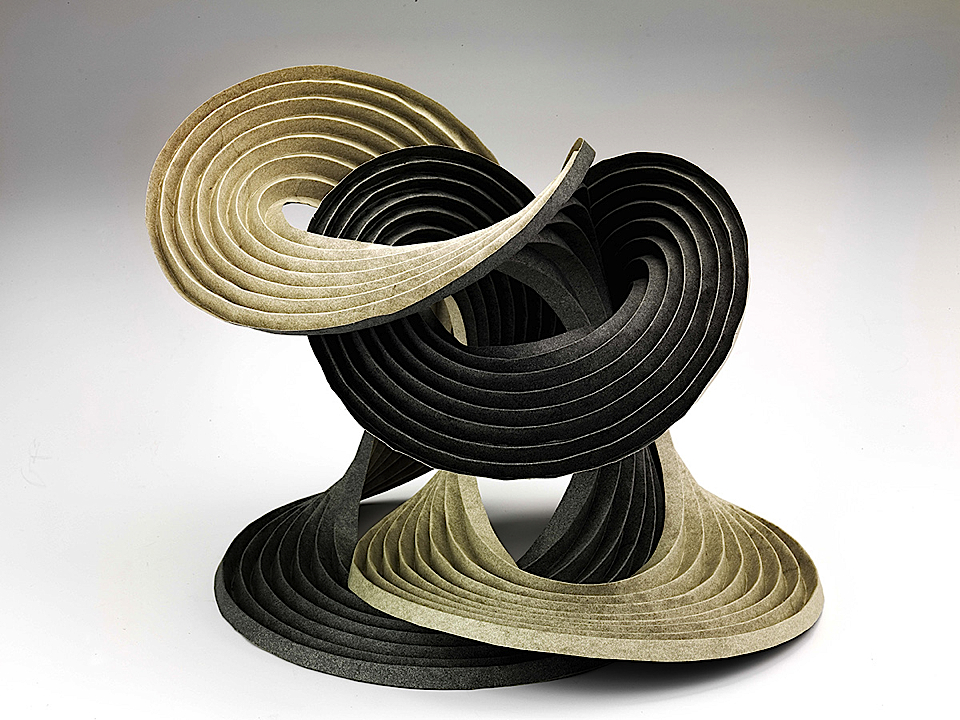
Design by Demaine
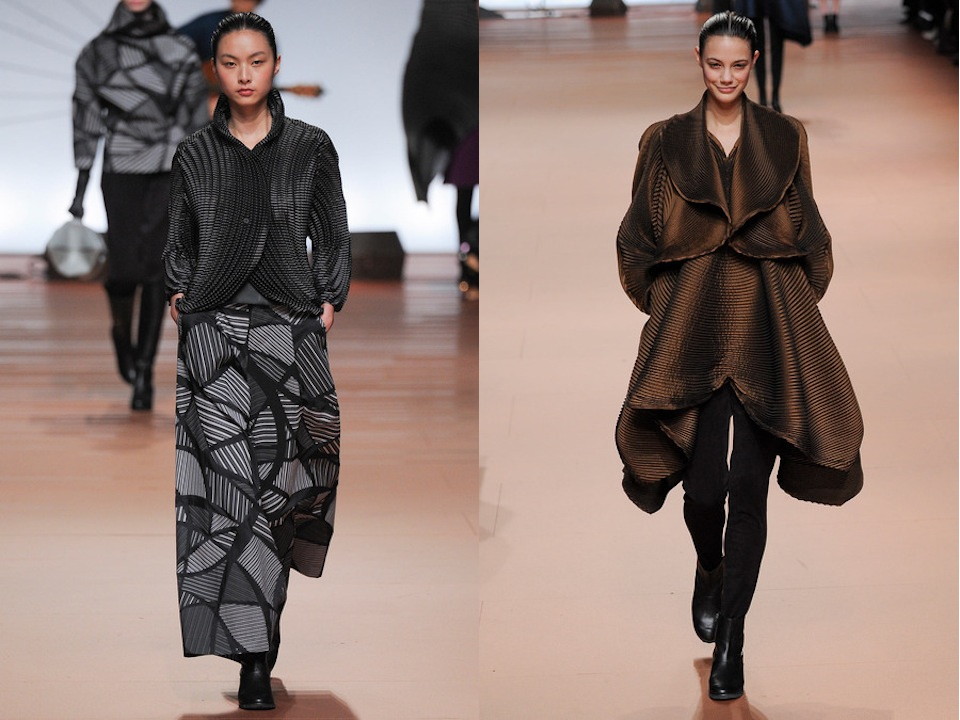
Issey Miyake 2014 - Photos courtesy Style.com
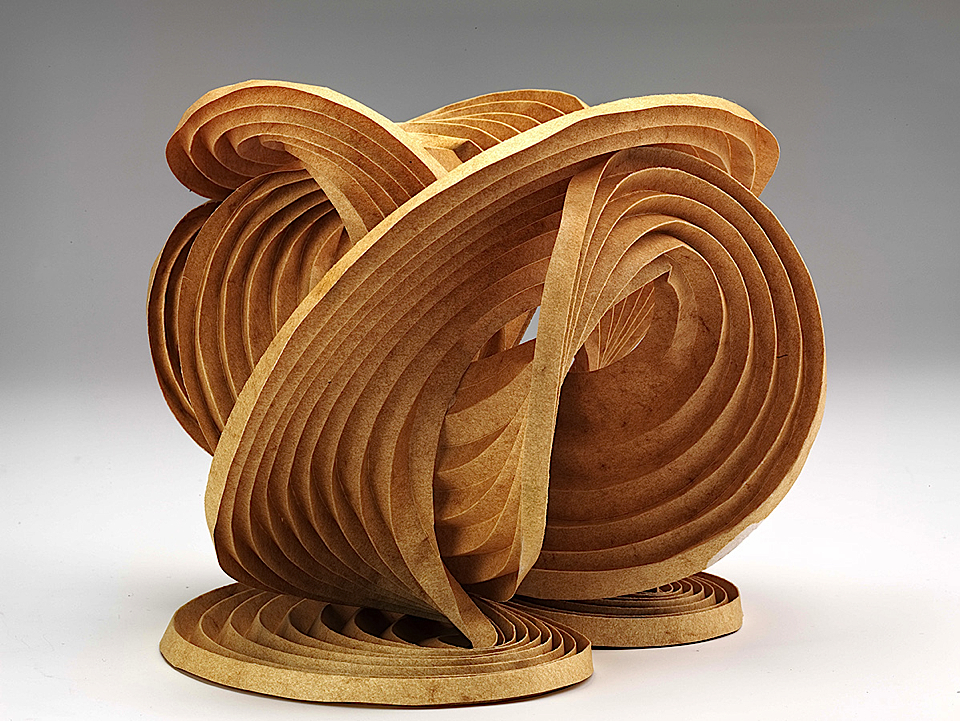
Design by Demaine
blossom
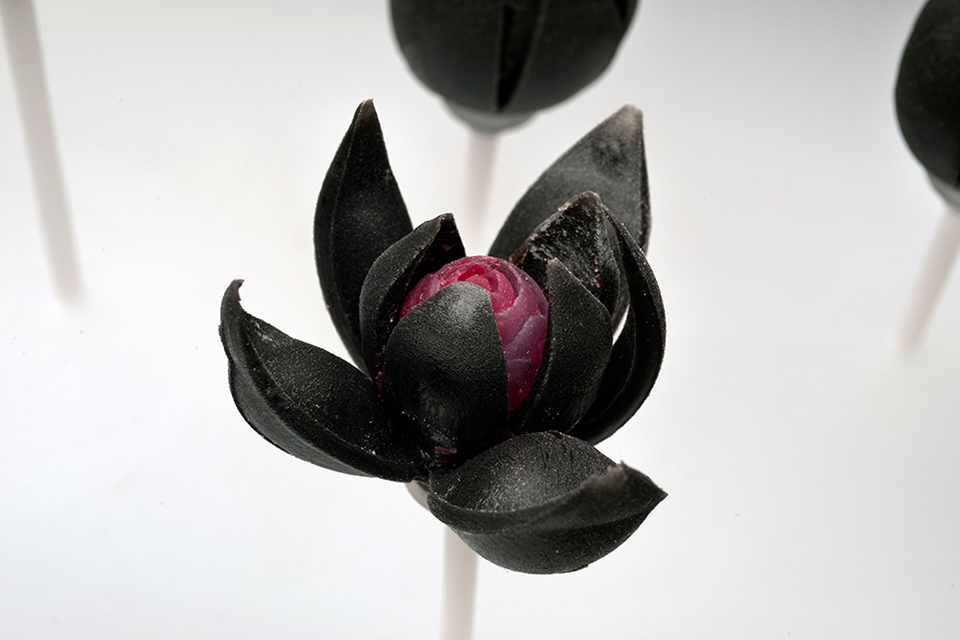
Designed by Richard Clarkson for Tim Miller’s INDN441 Digital Manufacture paper at Victoria University of Wellington in collaboration with OBJET.
Richard Clarkson designed complex 3D-printed flowers blooming like real flowers. Recent advances in 3D printing now allow the simultaneous deposition of different materials in one single print. "Blossom" explores this blending of materials from flexible to rigid.
This is really going to change completely the way 3D printing is used in manufacturing and design as this variation offers a great opportunity to generate complex forms that were impossible to make before.
"Seamless Blossom" is an interactive installation made without electronics, sensors or computer control but working only on air pressure. As users interact with small hand pumps the air is forced into curved, hollow petals that temporarily inflate and create a blossoming movement.
This beautiful and hybrid piece of Art shows the incredible growing capabilities of 3D printing.
Cecile Poignant
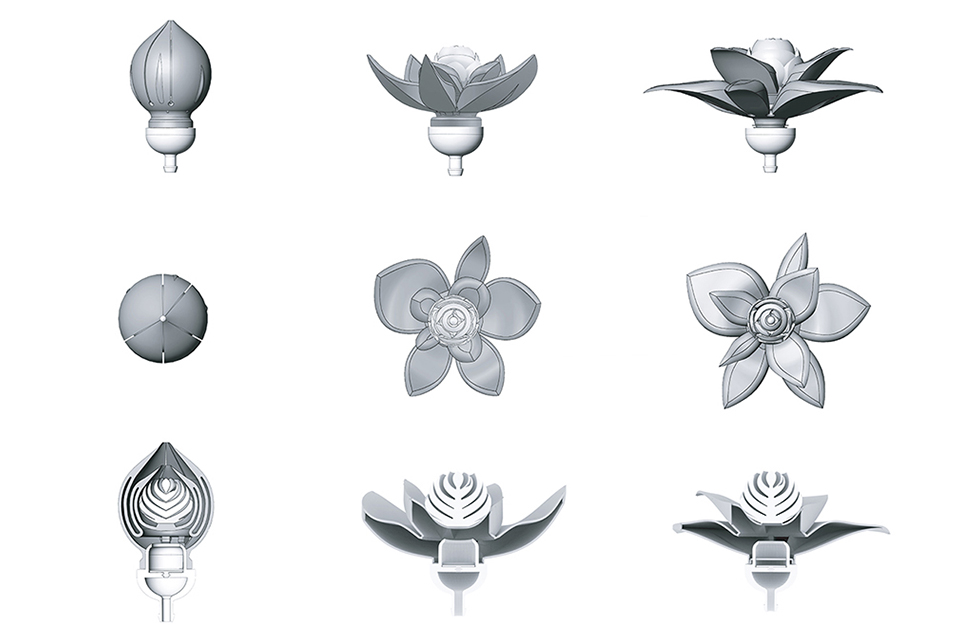
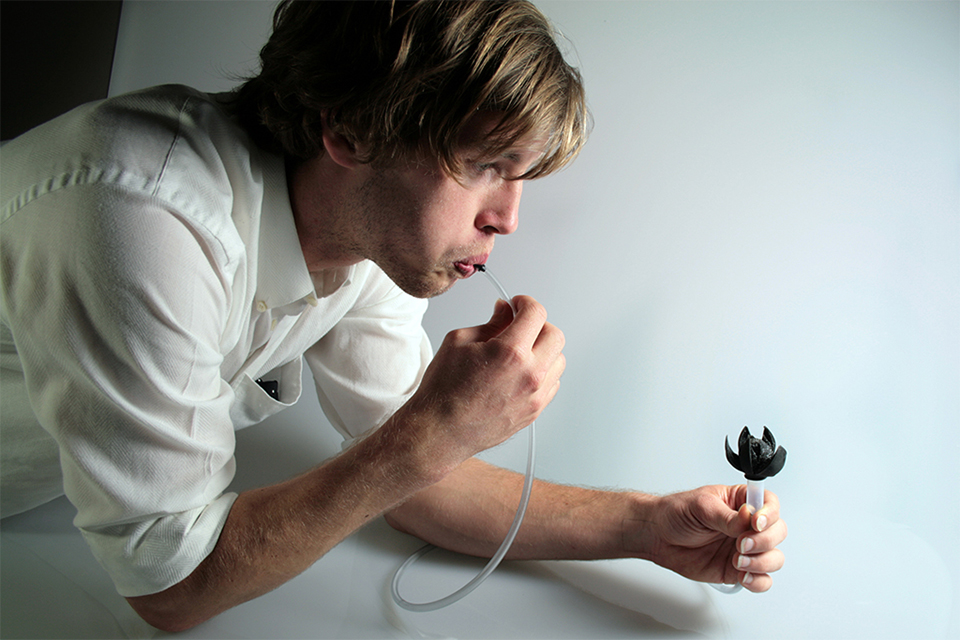
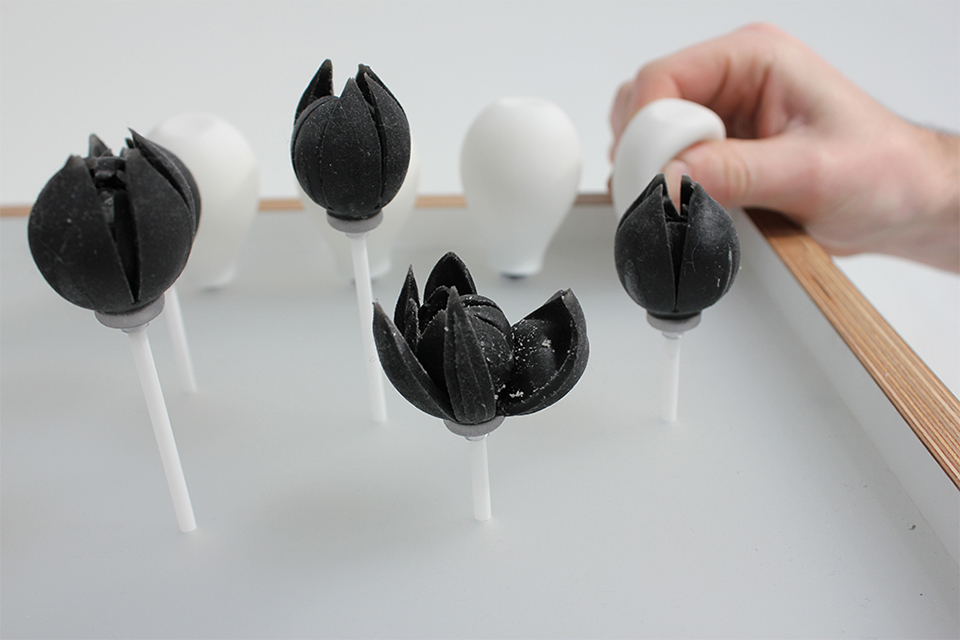
catherine wales

Catherine Wales photos by Christine Kreiselmaier
Project DNA is the three-dimensional accessories collection from London- based designer, Catherine Wales. At the helm of the world’s third industrial revolution, Catherine’s debut offering cross-pollinates high fashion, technology and science to re-evaluate conventional methods of garment construction and push the boundaries of digital fabrication within the luxury market.
Inspired by identity and the visual structure of human chromosomes, Project DNA is created almost entirely with individual and interchangeable ball and socket components that allow it to be built in a number of directions. Produced using white nylon with a 3D printer, the eight-piece collection encompasses a scaffolded corset, a blossoming feathered shoulder piece and a waist bracelet complemented by four transformative headpieces that hide key areas of the face; including a guilded horn and a mirrored mask, and a cut out visor helmet.
Catherine’s futuristic collection is completely unique and can be used both editorially to stimulate conceptual thinking and scientifically to develop the capabilities of luxury fashion prototyping within the 3D space.
As an expert pattern cutter, Catherine originally approached Project DNA with a view to sustainably solve the current complications surrounding garment sizing and manufacturing restrictions.
In this way, the collection embraces technological developments in order to cut down wastage and better support consumer demand.
Catherine Wales has been working in luxury and fashion for over 15 years. Her solo work channels her recent MA in Digital Fashion from the London College of Fashion. Prior to turning her sights to the digital world, Catherine trained and worked with some of the most prestigious fashion labels in the world, cutting designs for Jasper Conran, Jean Charles de Castelbajac, Oswald Boateng, Emanuel Ungaro and Saint Laurent, where she worked with the renowned Hedi Slimane and former design assistant, Simon Spurr.
Sophie Hérolt Petitpas
Sophie Hérolt Petitpas is a french journalist free lance found of design and lifestyle. Sophie is also passionate by astrology and its mythical and symbolic aspects. Curious and sensitive, she loved linking and describing her trend hunting with the eyes of mythology in her blog.
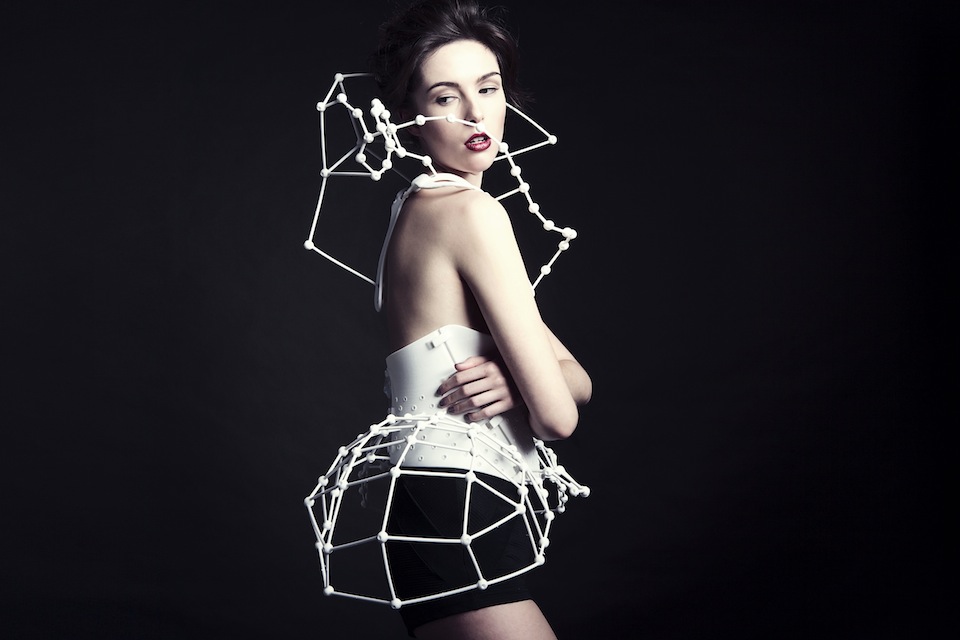
Catherine Wales photo by Christine Kreiselmaier

Catherine Wales photos by Christine Kreiselmaier
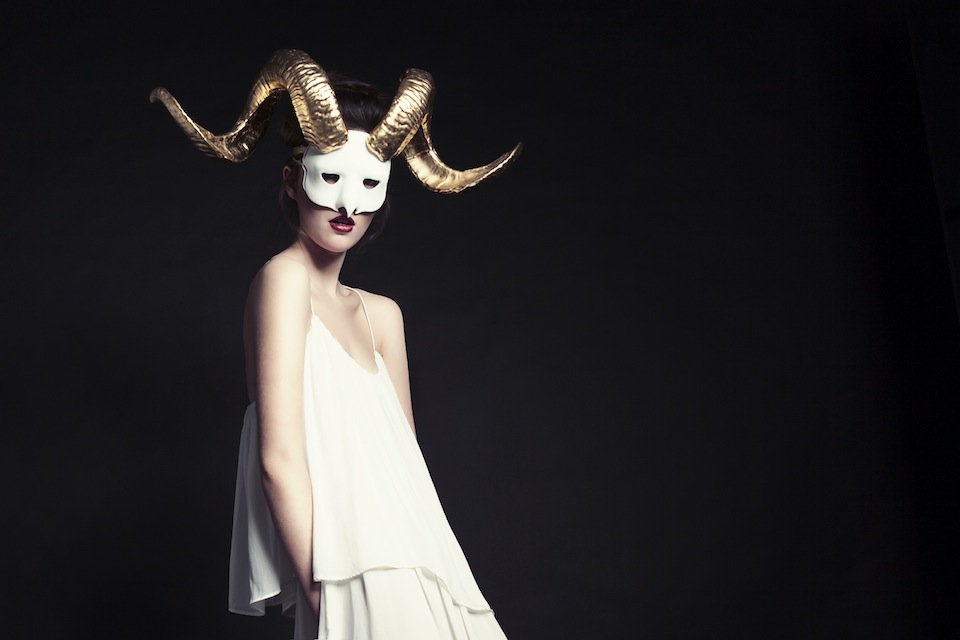
Catherine Wales photo by Christine Kreiselmaier

Catherine Wales photos by Christine Kreiselmaier
mer ka ba
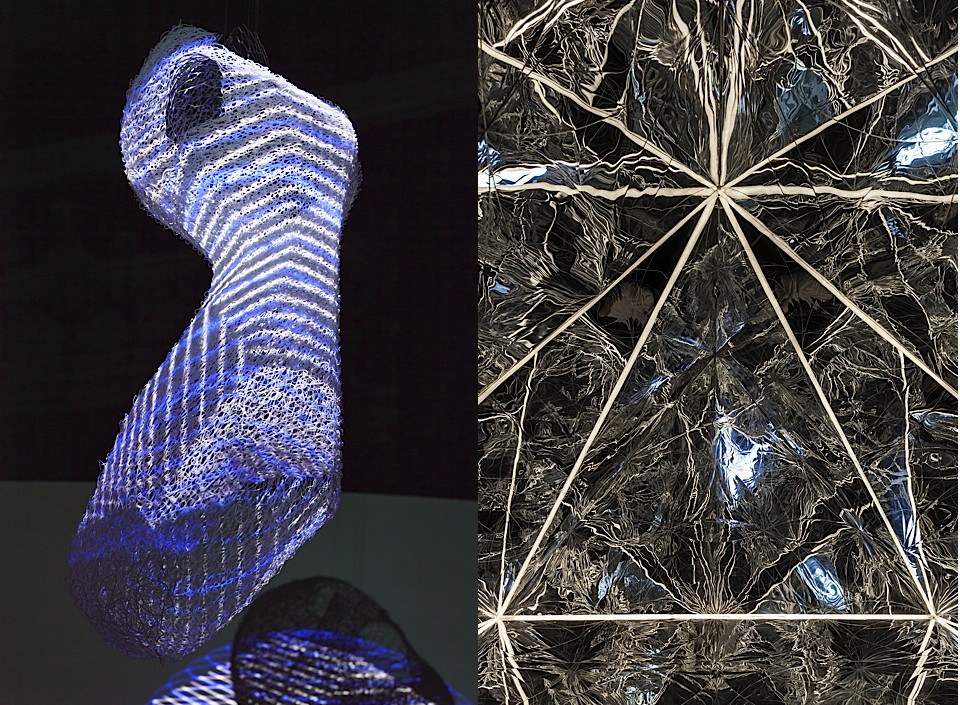
Pythagoras said “God geometrizes"and the archetypal language of sacred geometry, which is inherent in nature's design, is a key in understanding the universe from the microcosm (which is within), to the macrocosm (which includes everything that surrounds us). The diverse patterns and designs found in this geometry enforce our sense of interconnectedness and our relationship to the dimensions of all things that are created.
The design collective threeASFOUR has revealed a new dimension of sacred geometric depths in their work MER KA BA: a selection of their Spring/Summer 2014 Ready to Wear collection set against architecture and video projections at the The Jewish Museum. The New York based trio of fashion designers Gabriel Asfour, Adi Gil, and Angela Donhauser, have created a collection of 3D printed, laser cut silk and origami folded dresses that reflect their origins from Lebanon, Israel and Tajikistan, respectively. With past collections borrowing themes from the Zodiac calendar, Buckminster Fuller and Middle Easter talismans, their exhibition is a fully immersive environment that reflects their many influences. The title of the show taken from Egyptian hieroglyphs mer (rotating light) ka (spirit), and ba (body), when put together, are symbolic of the energy fields that the body transitions through as it ascends to a higher plane.
threeASFOUR's collaboration with architect Bradley Rothenberg and Studio Christian Wassmann invites visitors into a moody and textural space modeled after the sacred geometries commonly found in synagogues and mosques.
The designers explored new mediums in their mirrored structure and projections which borrow from the five Platonic solids. When you take a step back, the structure reflects on itself to form a 3-dimensional 6-pointed star or hexagram, which is known to represent the union of the material and spiritual worlds and the balance of masculine and feminine energies - symbolic of the balance of creative expression from this idiosyncratic trio.
The exhibition threeASFOUR: MER KA BA will remain on view through February 2, 2014.
On November 10th at 6pm The Jewish Museum will present an interactive performance conceived by threeASFOUR in relation to the exhibition, combining avant-garde fashion and ancient bread-breaking rituals.
Alexandra Conn
Alexandra Conn is an artist, illustrator and designer working in book publishing, fashion and beauty in California and New York. You can follow some of her adventures here.
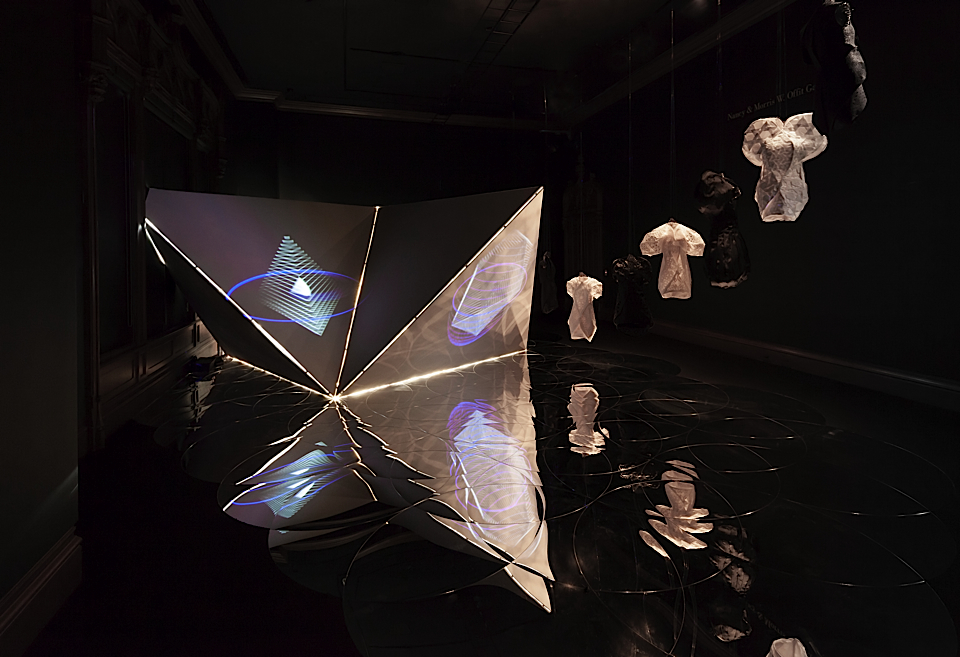
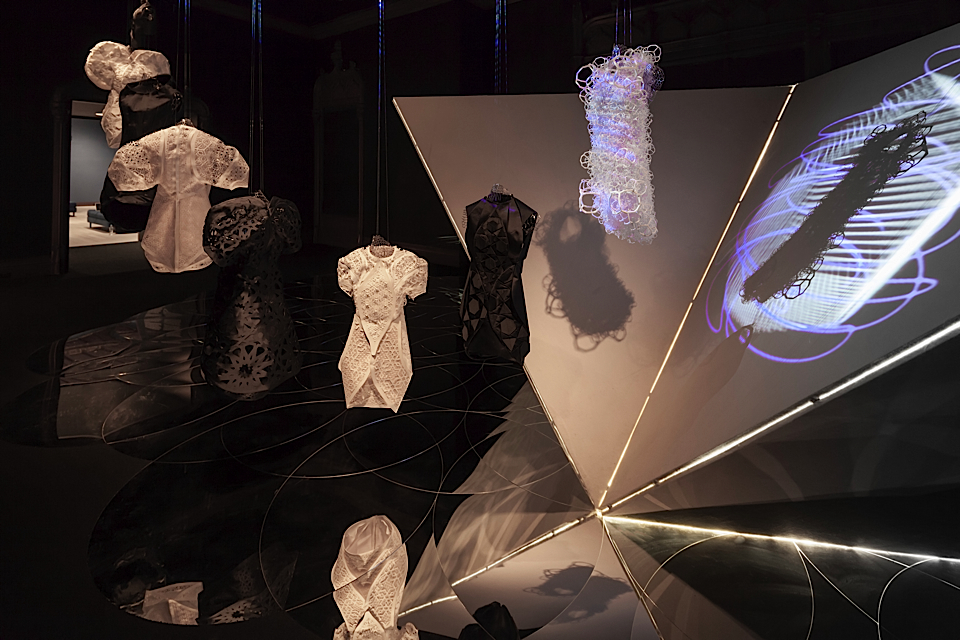
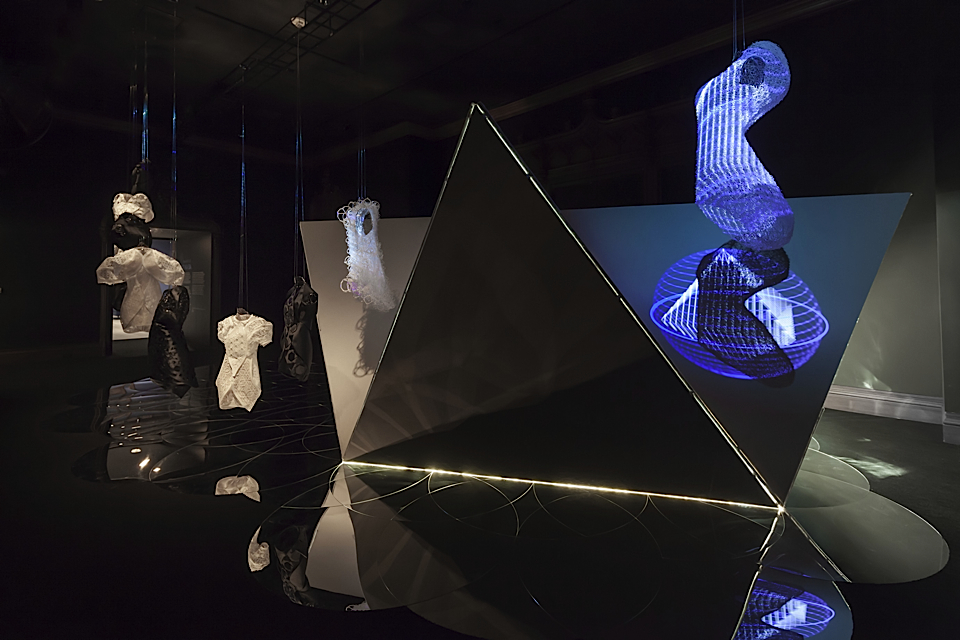
peta bush
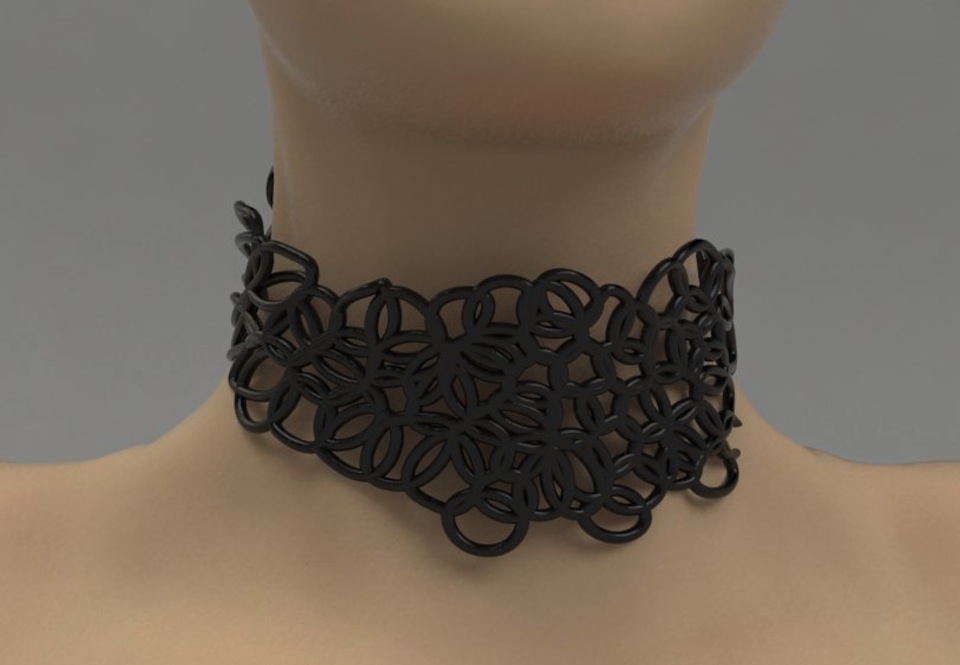
Peta Bush is a contemporary jewelry designer from London who has turned her design focus to wearable health devices.
Bush became interested in health devices when she discovered many were still so unappealing. "Why is everything still so beige? How can we make these objects more desirable?" This is the problem she is working to solve using a people-centric design process.
Bush imagines a more colorful future and dynamic new form factors. Putting anything on your body is an expression of who you are, and how you feel. Glasses started out as a purely medical device, but are now a style object – even for those who don’t need them. "We wear objects as adornment, to feel good," says Bush. Why not look at a neck brace or a walking stick in the same way?
The health device ideas pictured here are designed to work with acupressure points on various parts of the body. Future devices are being designed to support and immobilize.
Bush brings a feminine sensibility and twist to an industry which has been designed mostly by men, focused on function. As a contemporary jewelry designer, she hopes to make these devices more aesthetically appealing – just in time for a growing market of aging boomers. Wearable technology as an industry is exploding, and is projected to exceed $6 billion by 2018.
Listen to an interview with Peta Bush. You are also invited to discuss design ideas directly with Bush on twitter during the global chat on creativity – #ideachat, taking place on Saturday, October 12th, from 9 am - 10 am EDT, or 3 pm to 4 pm CEST. The #ideachat topic for October is "Why Do Design and Aesthetics Matter?"
Angela Dunn
Angela Dunn is a writer on future technology and trends. She is currently helping launch the startup Permamarks.com, a personal archiving and curation tool. She also hosts a popular monthly salon of global innovators on Twitter called #ideachat.
Dunn has always been curious and interested in how trends converge. She started spotting and creating trends early in life as a club DJ, and later launched many trends as the owner of an avant-garde nightclub recognized internationally. In recent years, Dunn's has provided foresight on digital, social and mobile trends. Her work has been published by leading organizations in the healthcare industry. You can follow her on twitter @blogbrevity and also at Permamarks.
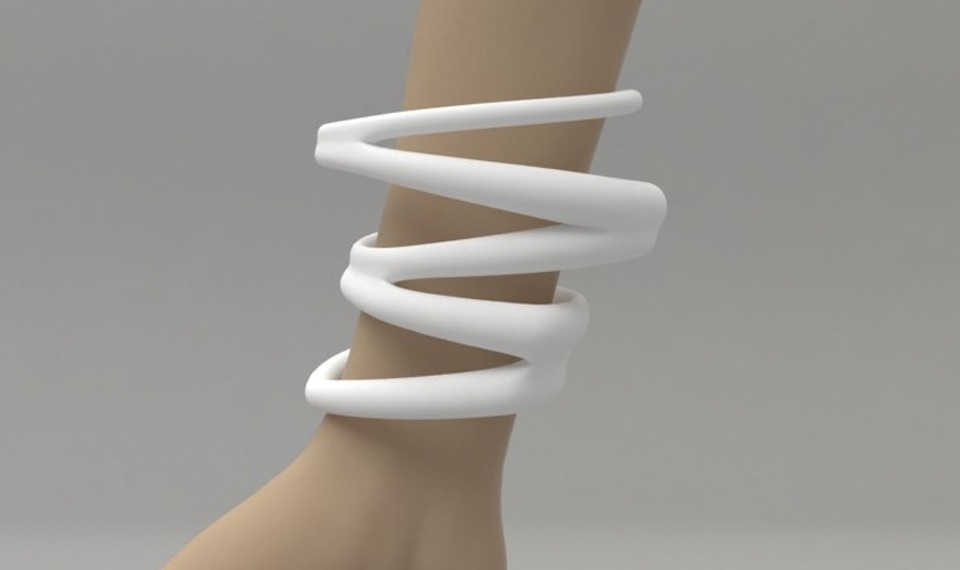
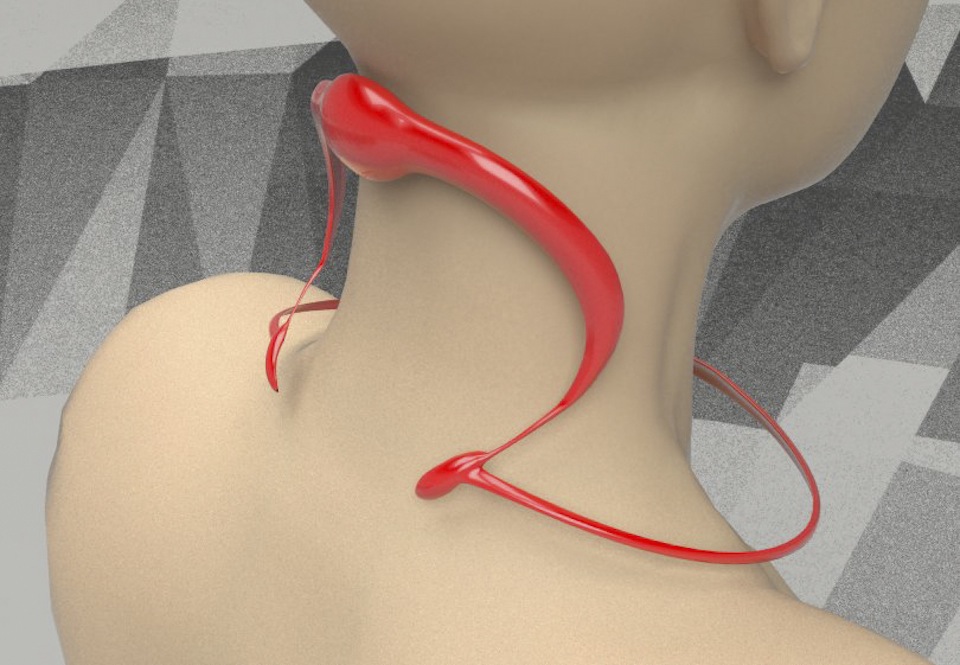
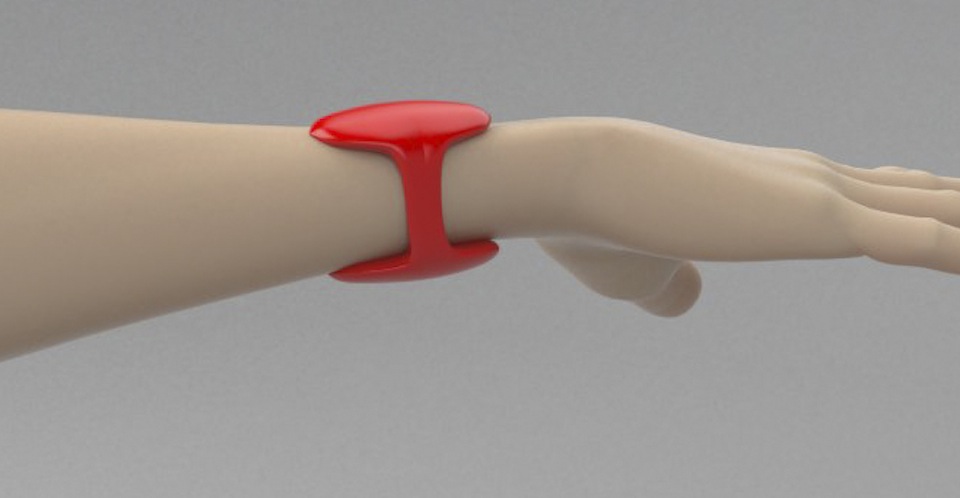
smart highway
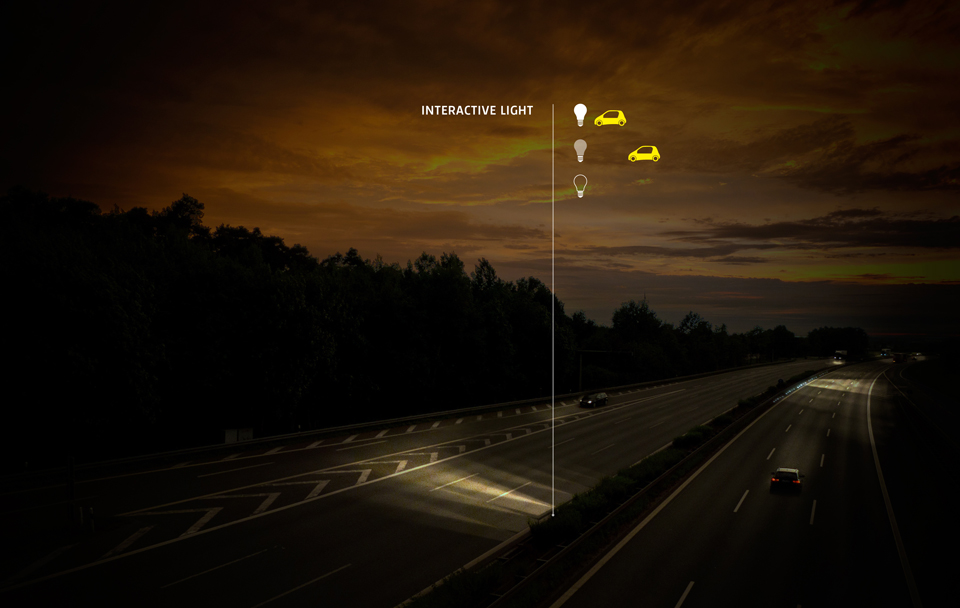
Smart Highway Interactive light -Studio Roosegaarde Heijman
Designer and innovator Daan Roosegaarde and Heijmans Infrastructure presented the first prototypes of the 'Smart Highway' during Dutch Design Week, selected 'Best Future Concept' by the Dutch Design Awards. For good reason. Using the latest technology, the studio's concept is to build roads that are more sustainable, safe, and intuitive.
Rather than focus on the car to innovate the driving experience, the focus of the project is to innovate the highway. Designs such as Glow-in-the-Dark Road, Dynamic Paint, Interactive Light, Induction Priority Late and Wind Light seek to make roads that are interactive, energy-saving, and adaptive.
These designs will be realized within the next five years, with the first iterations by mid-2013 in the Netherlands.
The 'Smart Highway' project is truly the Route 66 of the future.
Text by Ryan Moritz
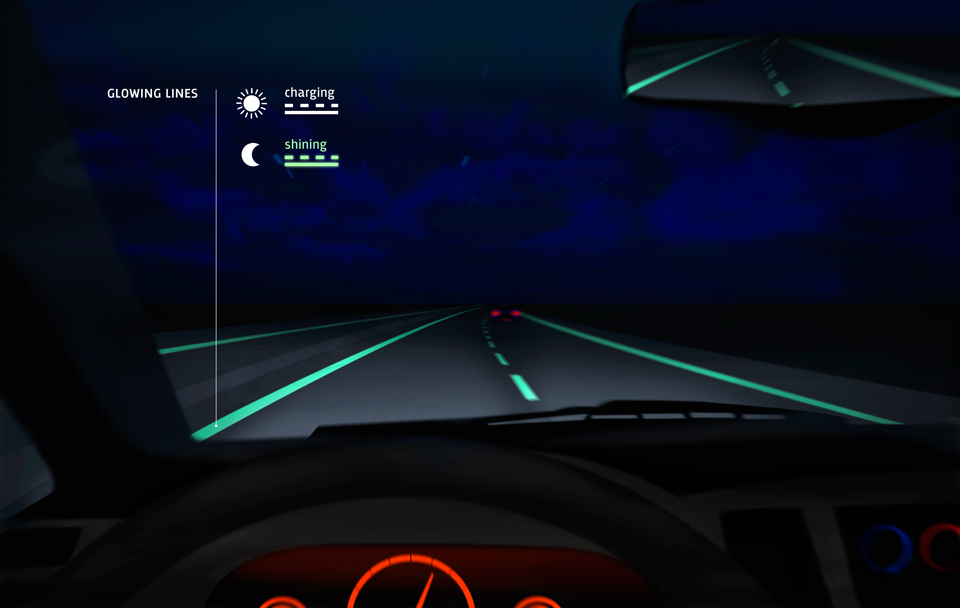
Smart Highway - Glowing lines - Studio Roosegaarde Heijmans
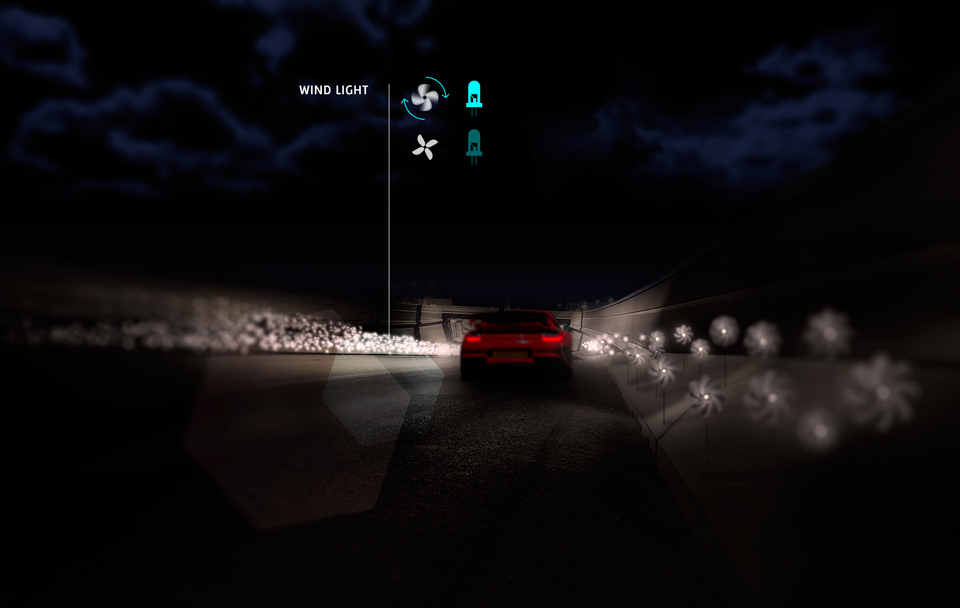
Smart Highway -Wind Light - Studio Roosegaarde Heijmans
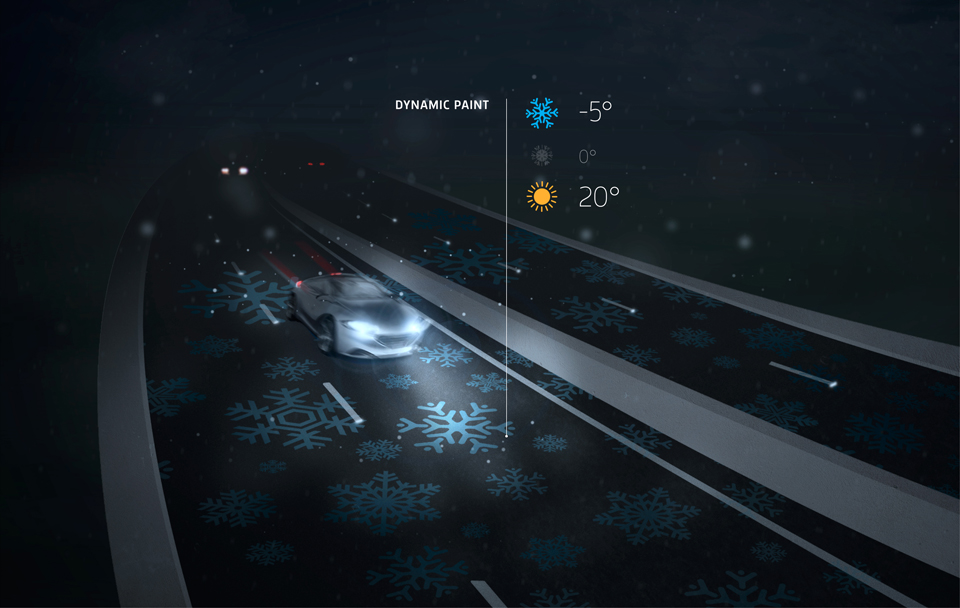
Smart Highway -Dynamic Paint - Studio Roosegaarde Heijmans
water graffiti
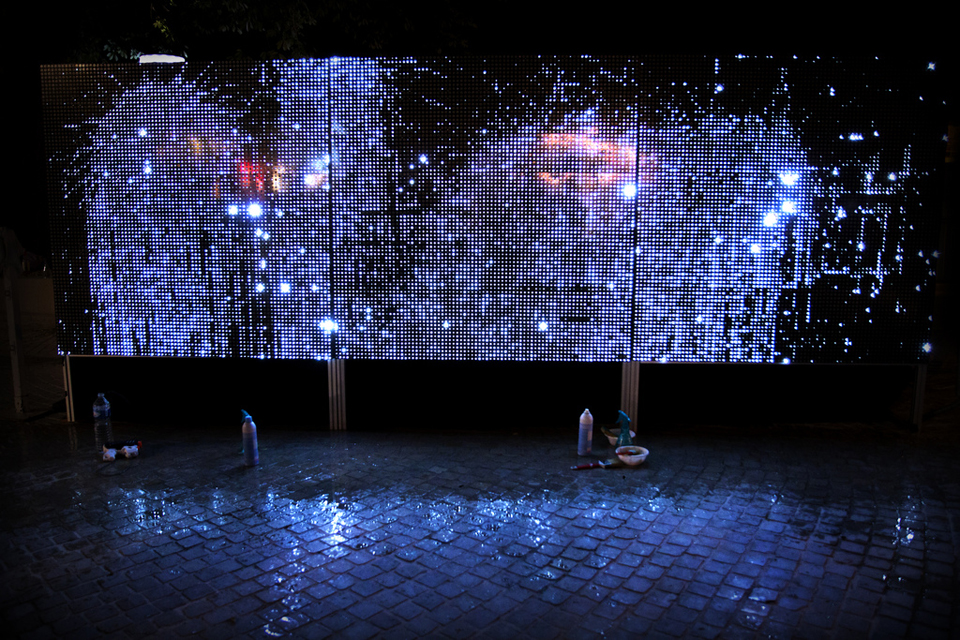
watergraffiti by Antonin Fourneau
Mixing water, technology, and public art, the Water Light Graffiti project is at once fluid and beautiful while at the same time transitory and digital. The project was conceived at Digitalarti, a lab dedicated to the digital art community at large. Welcoming artists, organizers, galleries, and collectors, the site and quarterly print magazine invites the public to share experiences, information and digital tools.
An artist in residence at Digitalarti Artlab, Antonin Fourneau created the Water Light Graffiti project. As described by the artist, the project surface is designed of thousands of LED lights which are illuminated by contact with water.
To activate the lights, one can use a paintbrush, spray bottle, sponge, or just about anything damp. The artist writes, "Water Light Graffiti is a wall for ephemeral messages in the urban space without deterioration. A wall to communicate and share magical in the city."
Subject Cécile Poignant - Text Ryan Moritz
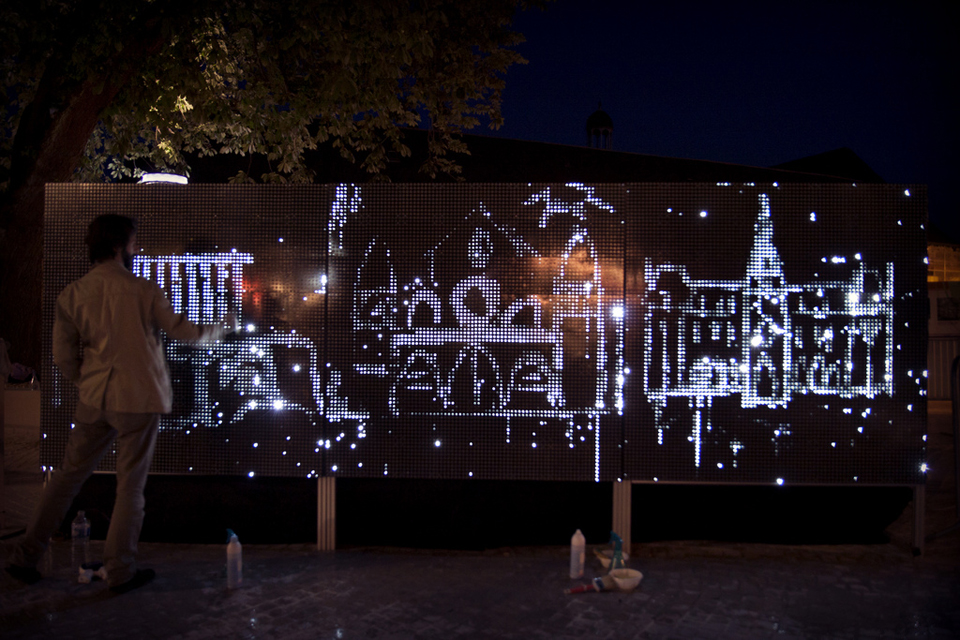
watergraffiti by Antonin Fourneau
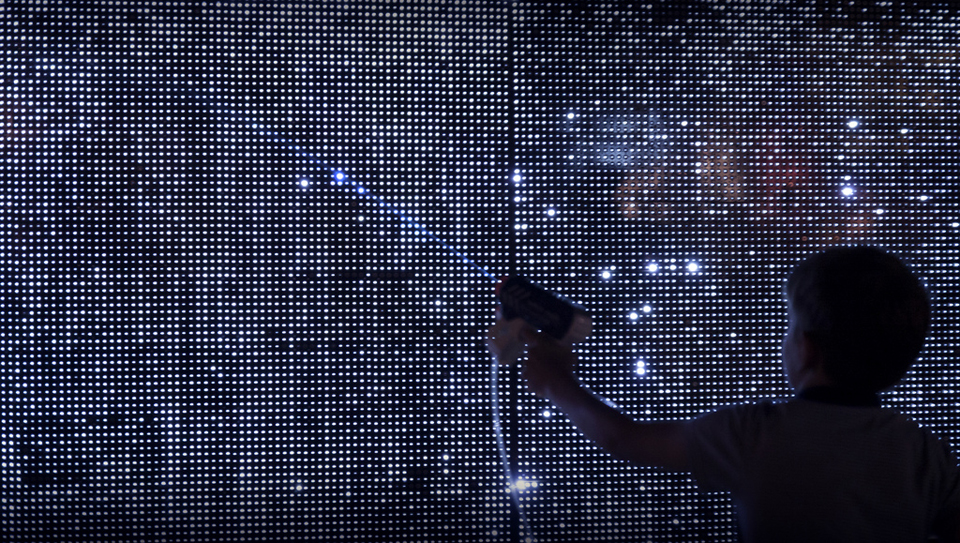
watergraffiti by Antonin Fourneau
landscape abbreviated
Landscape Abbreviated is a art installation by the young artist Nova Jiang for Wave Hill, the public garden & cultural center located in the Bronx. She created a little kinetic maze, with a floating garden, control by machines. His goal was to create a experience where a simple intervention could create an unpredictable paths.
I especially love this «modern» adaptation of a maze with a software that randomize the path so accordingly change your way of thinking to find an exit. It’s a beautiful metaphor of the serendipity, have exterior effect that forcing you to think differently.
This installation is quite little, but imagine a street, even a city where the nature drives your behavior and not this opposite like today.
Thomas Bouillot - New Grids By Thomas
hearing grass
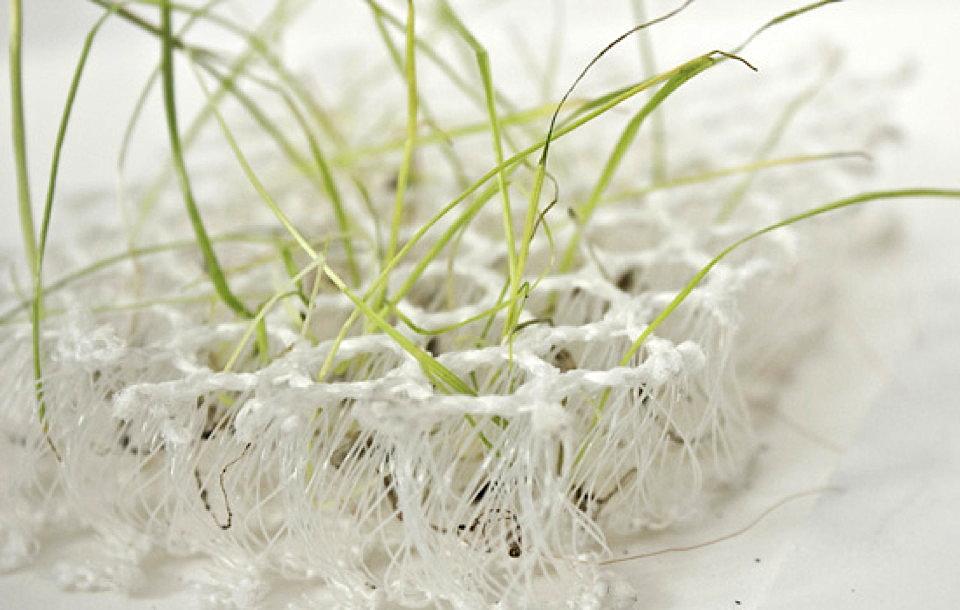
to hear the grass growing by FELD
Thomas Bouillot is studying advertising/brand communication, he has already worked in several french and american design/advertising agencies for few internships.
He is interested in blending design, technology and strategy. He also interested in the international cultural difference, the New Hollywood period, Beatnik books, Arduino, triathlon…
In spring 2011 he launched "New Grids" with the aim to introduce people some design work and planning thought.
Thomas will regularly share with Trendtablet's friends his best found.
Feld is a german studio specialized in «digital crafts», they design some digital objects connected to the physical world, or like here to the nature.
We see more and more works that connect nature and technology, it’s like a will of find another way to the eternal debate digital vs craft/traditional. Both are necessary, and when both are connected, they can bring us great experiences.
In this project, an arduino based computer is connected to the grass, for translate into a heart beat the growing phenomenon. An original way to realize when your plants need attention or when they’re in good mood.
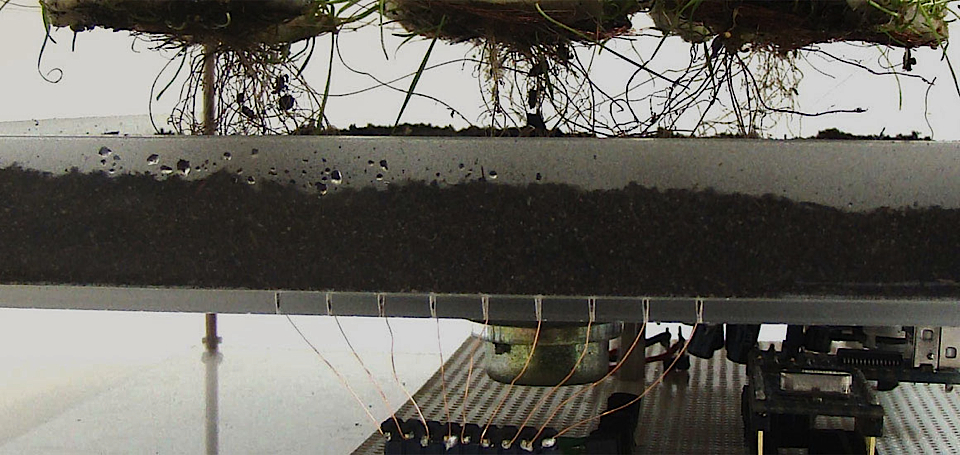
to hear the grass growing by FELD
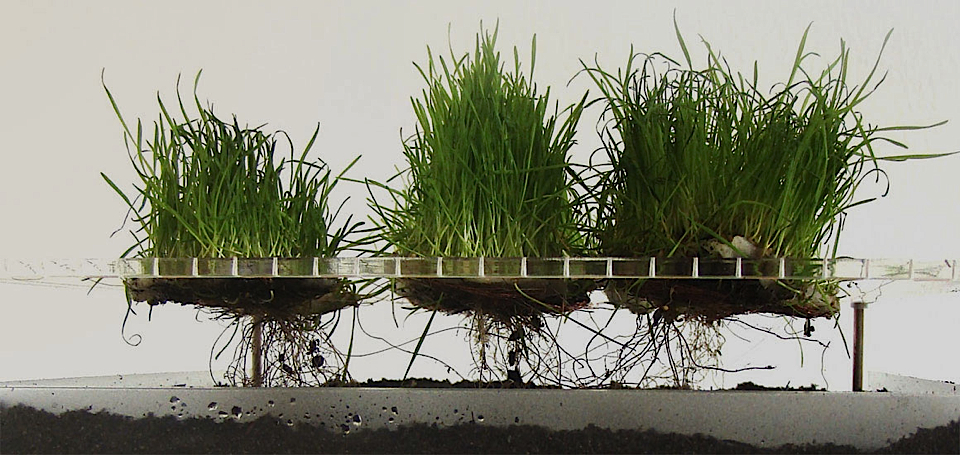
to hear the grass growing by FELD
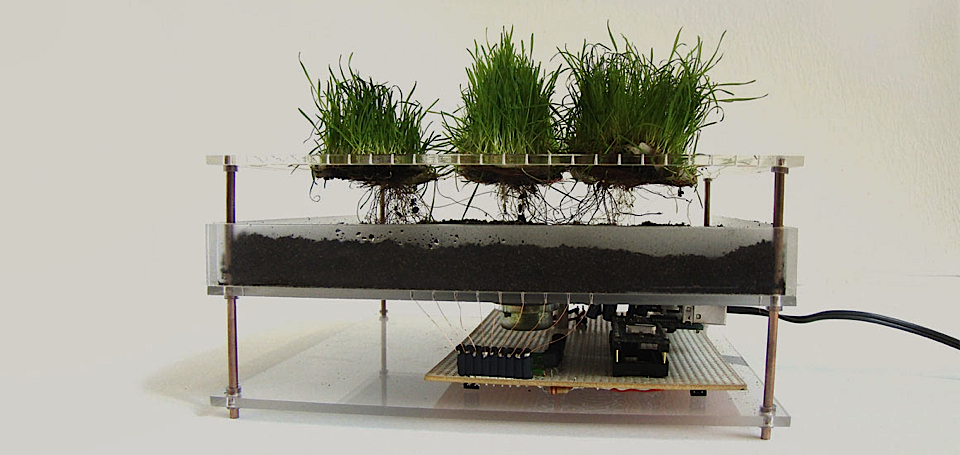
to hear the grass growing by FELD




